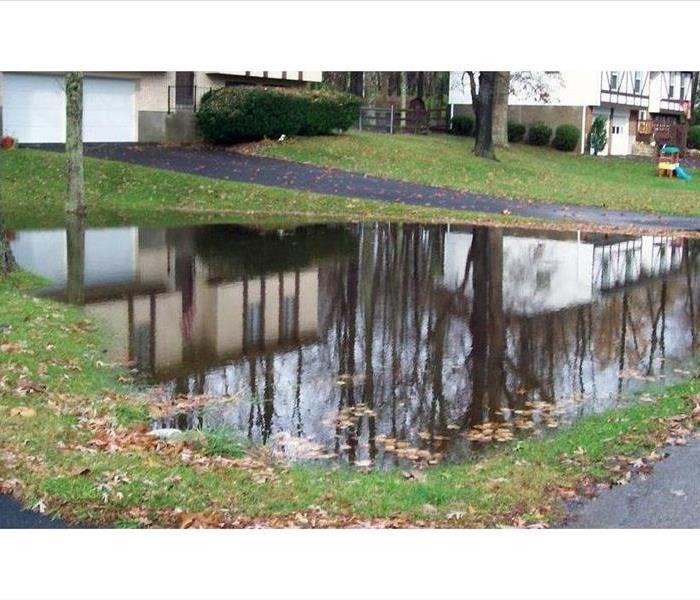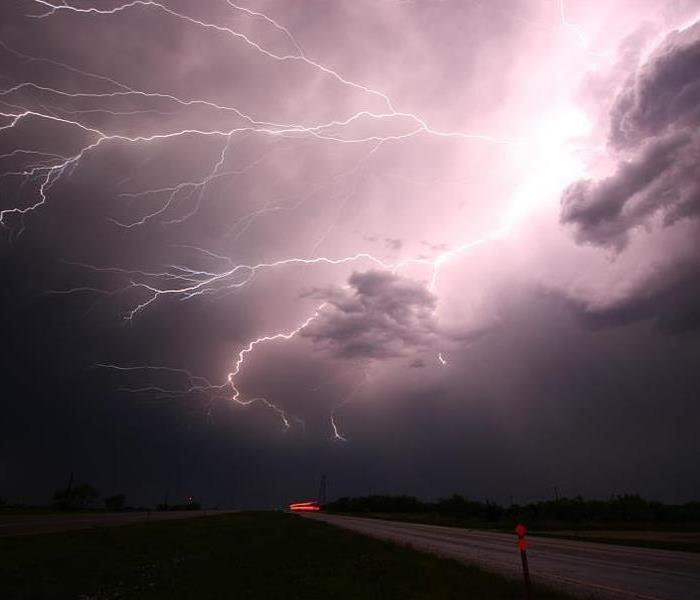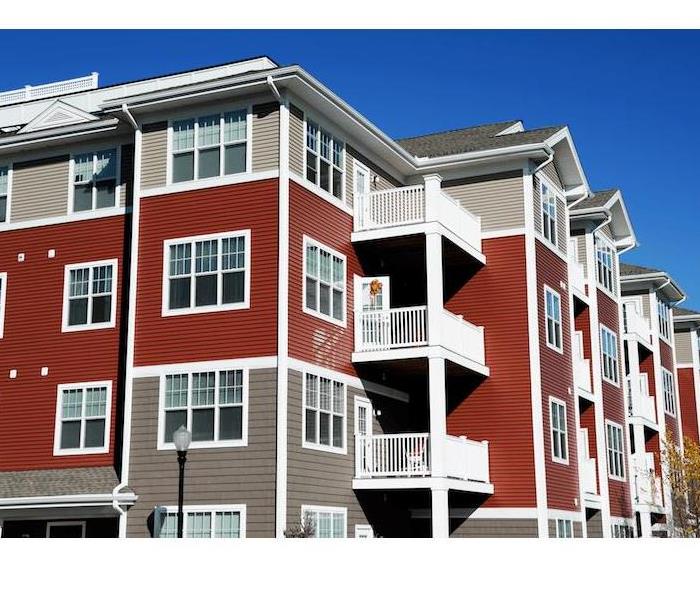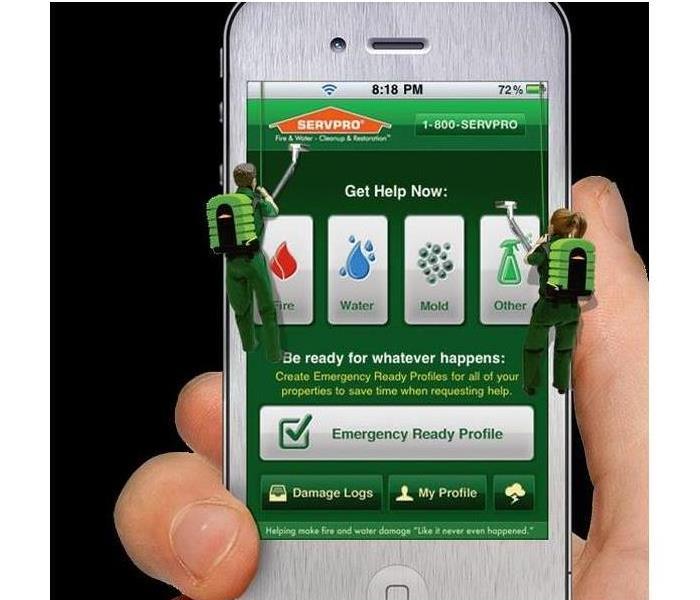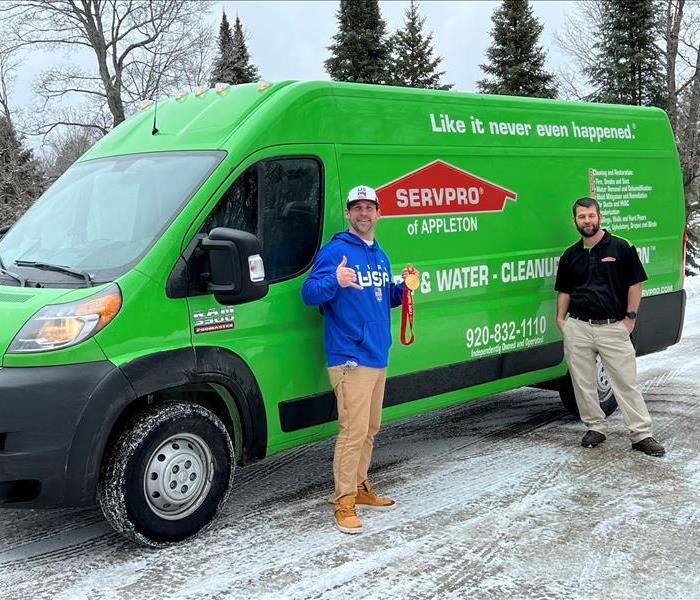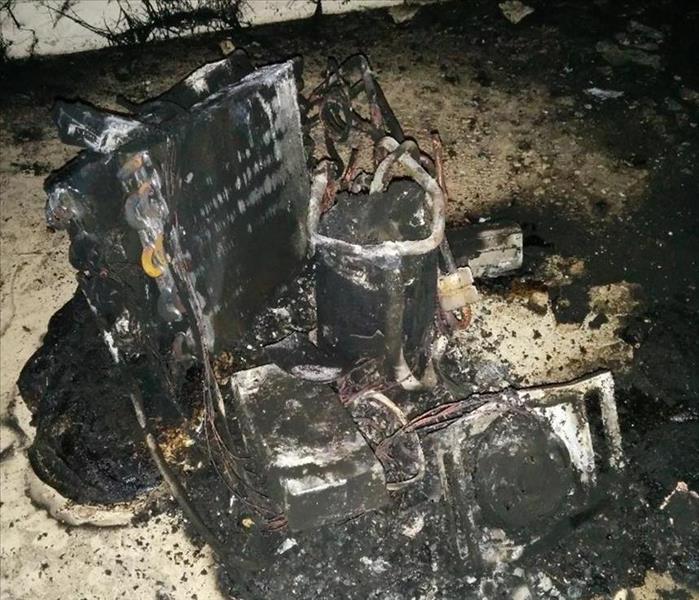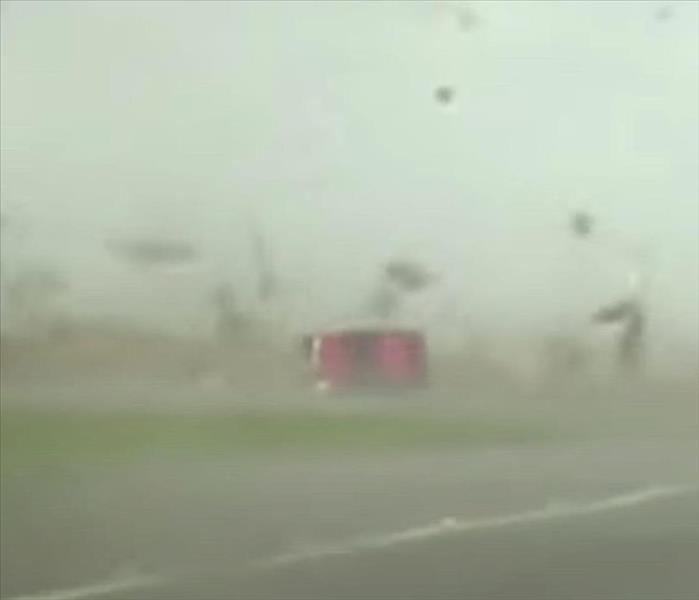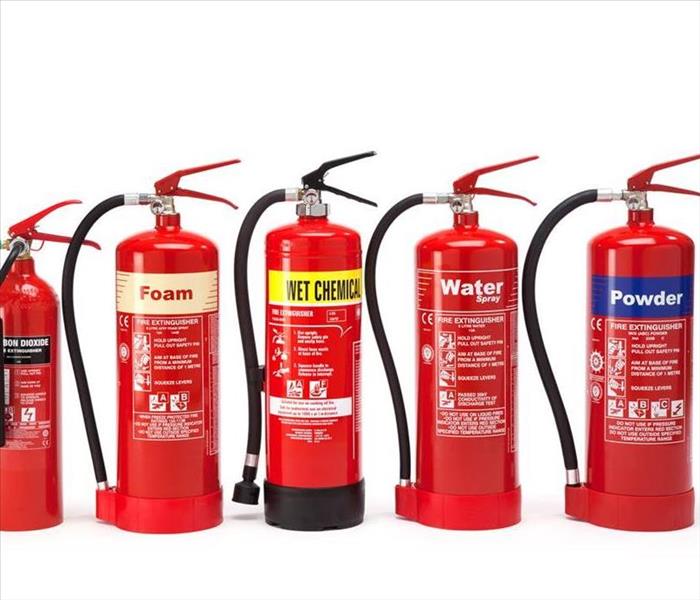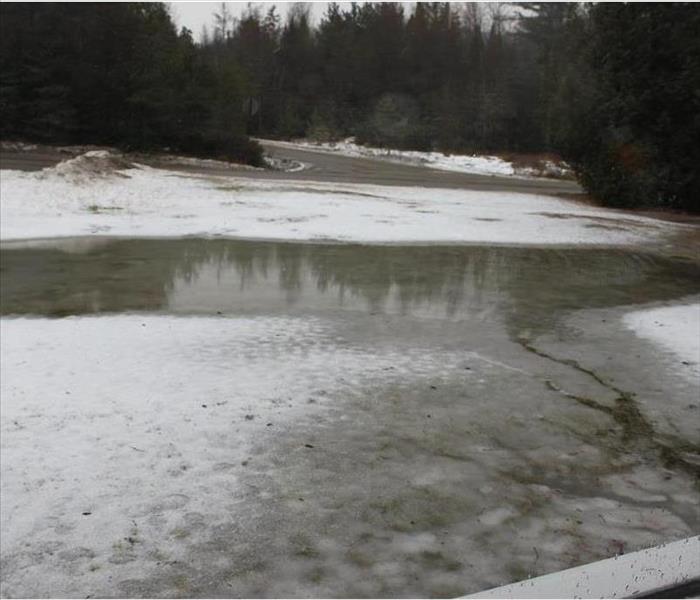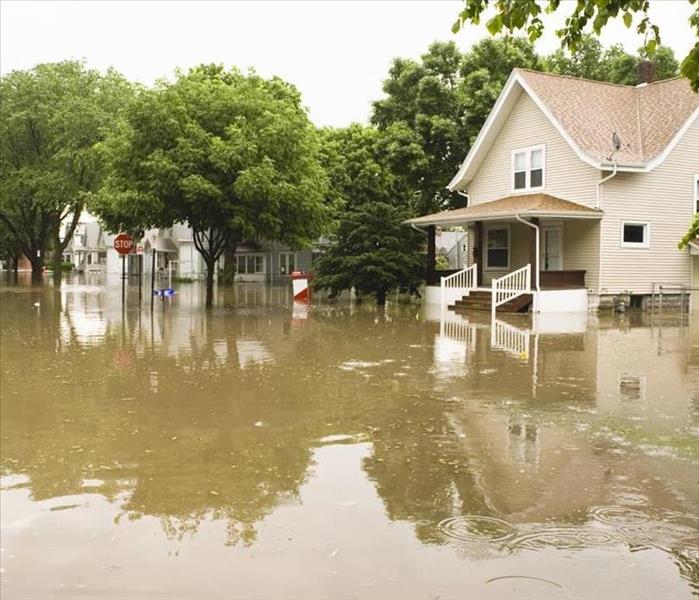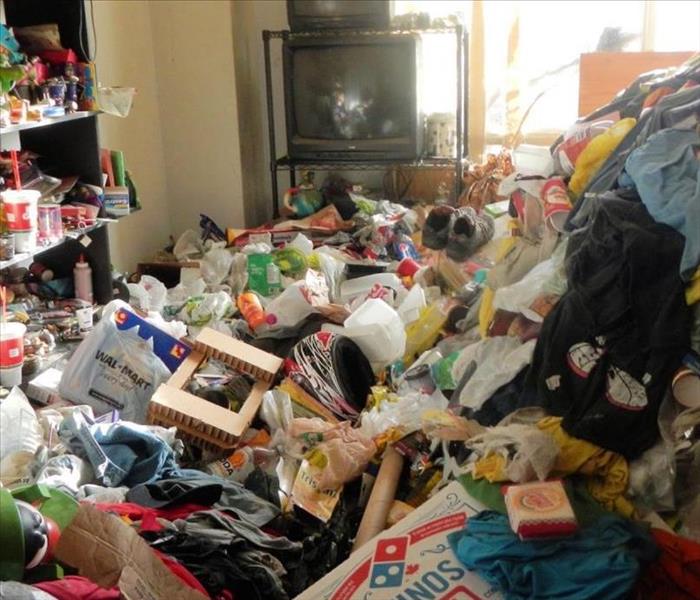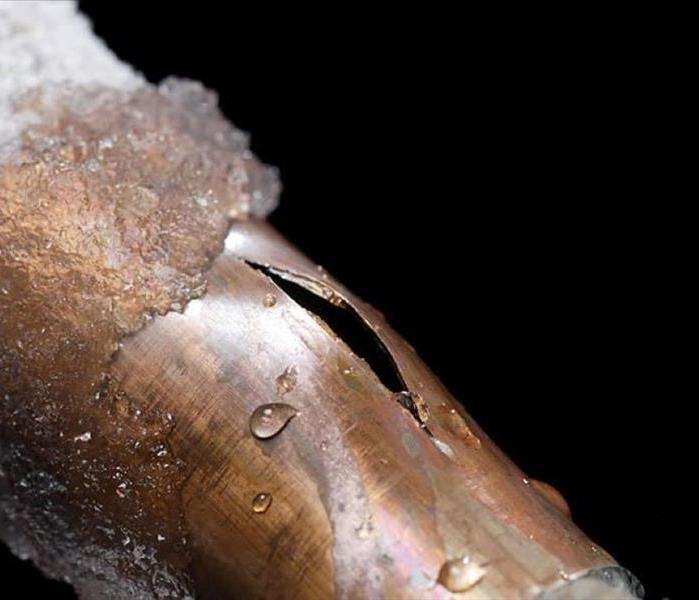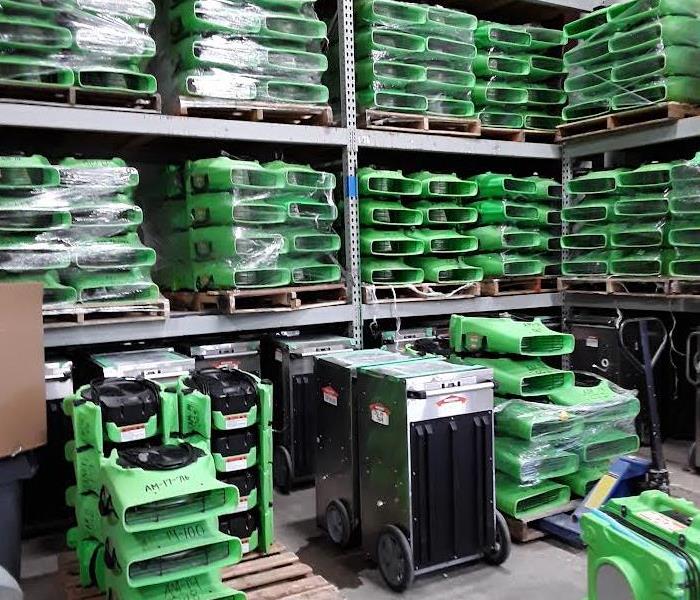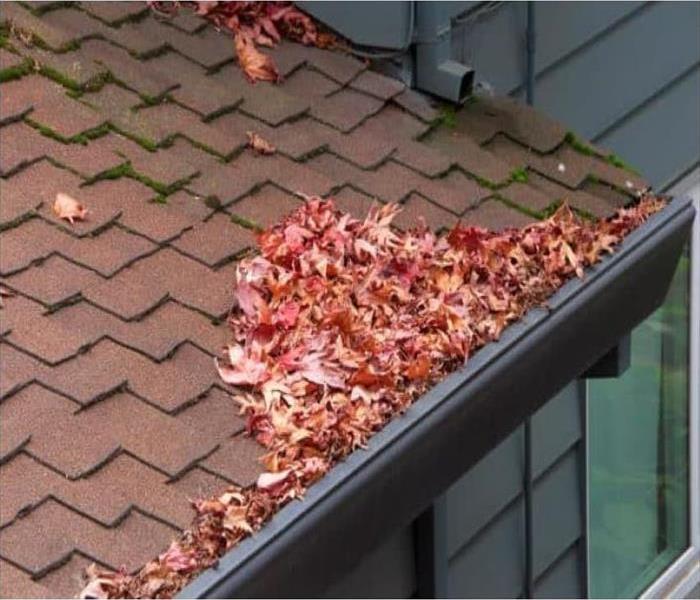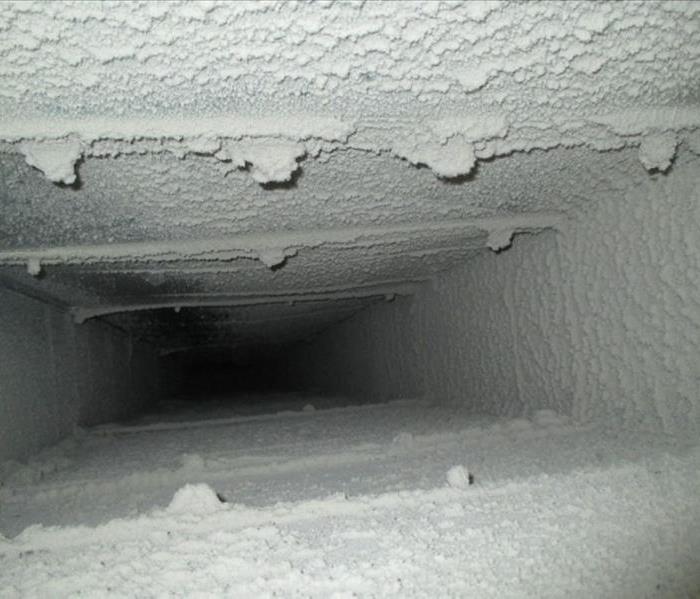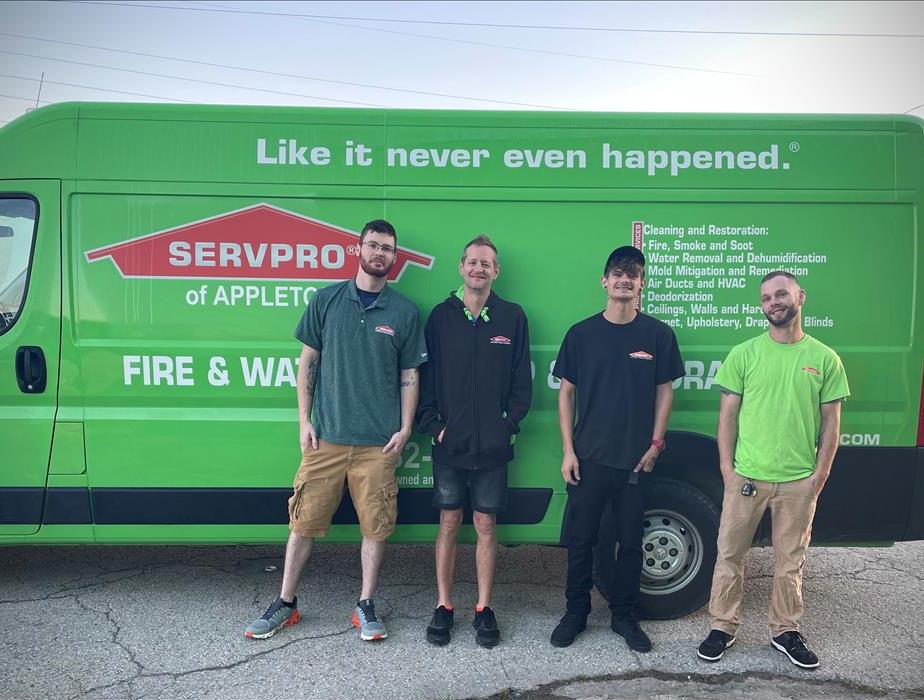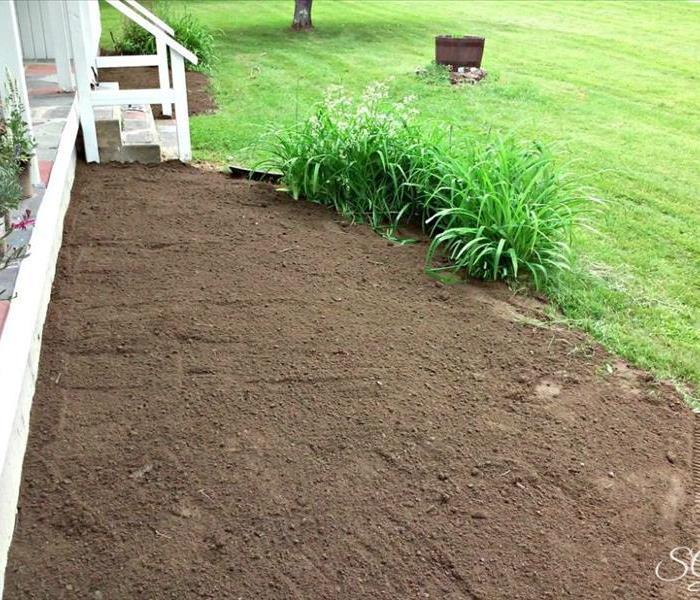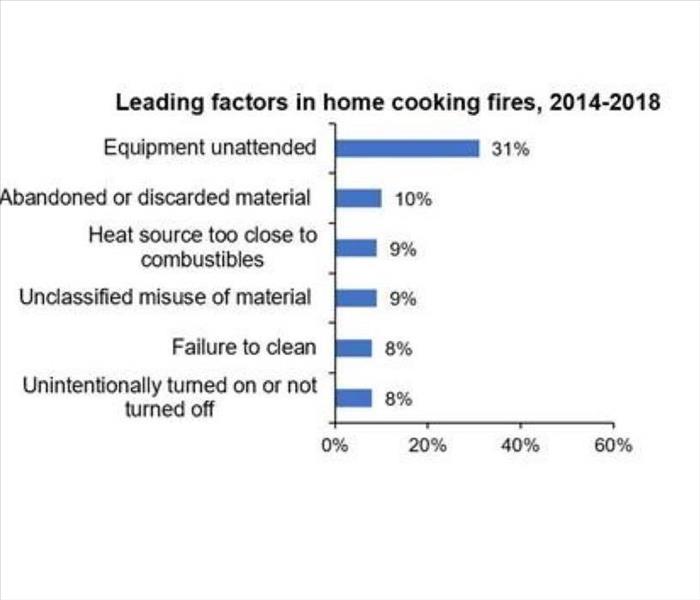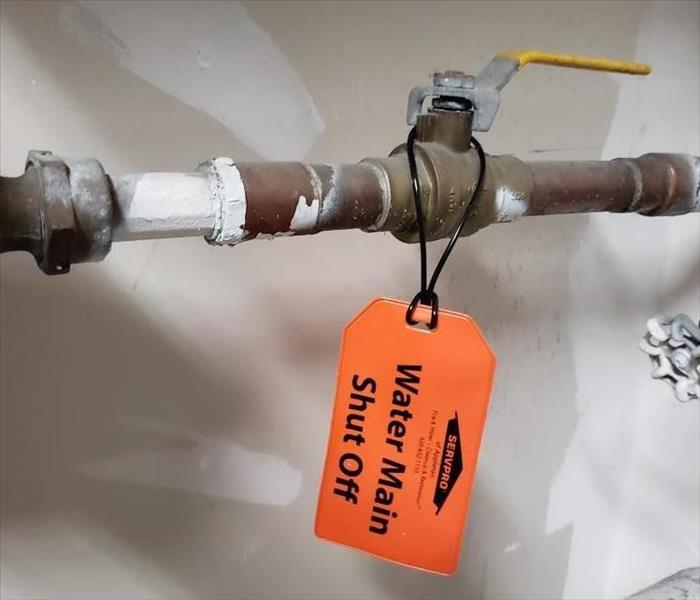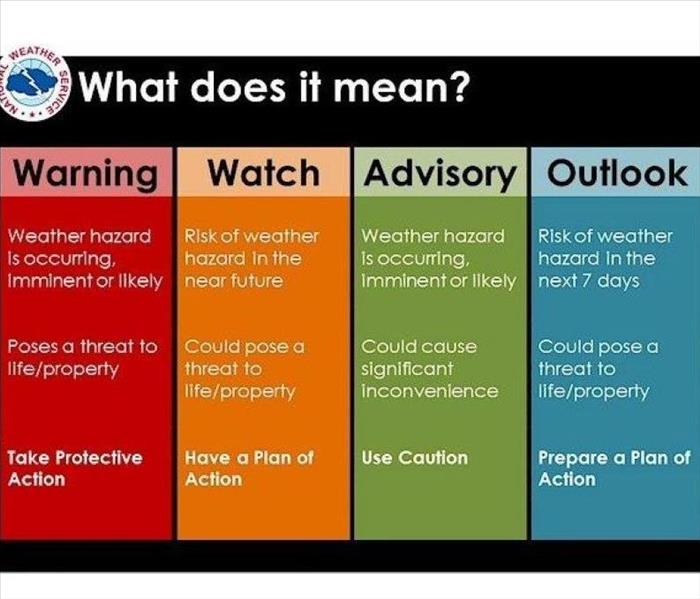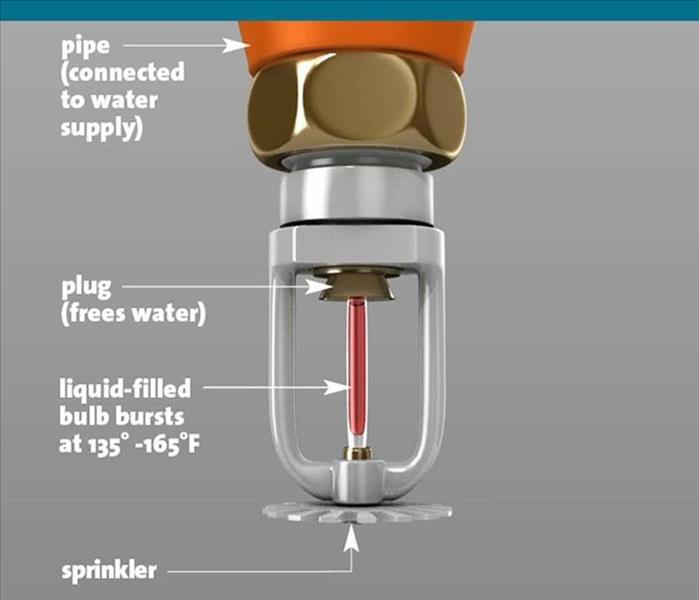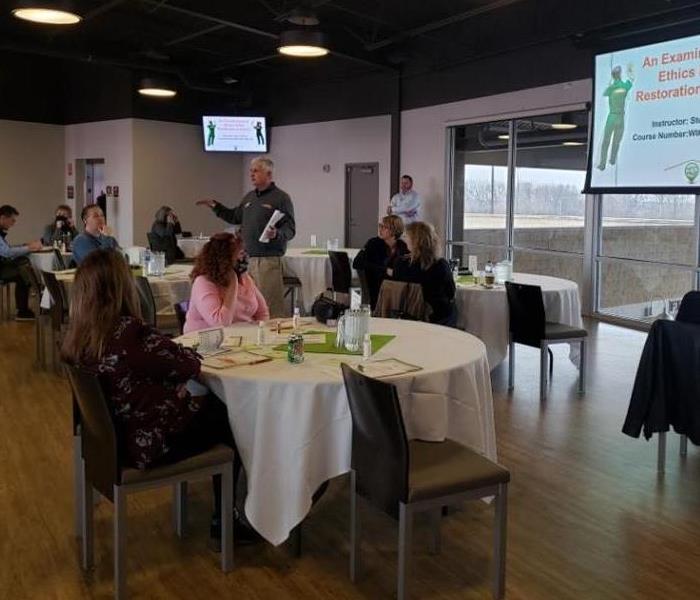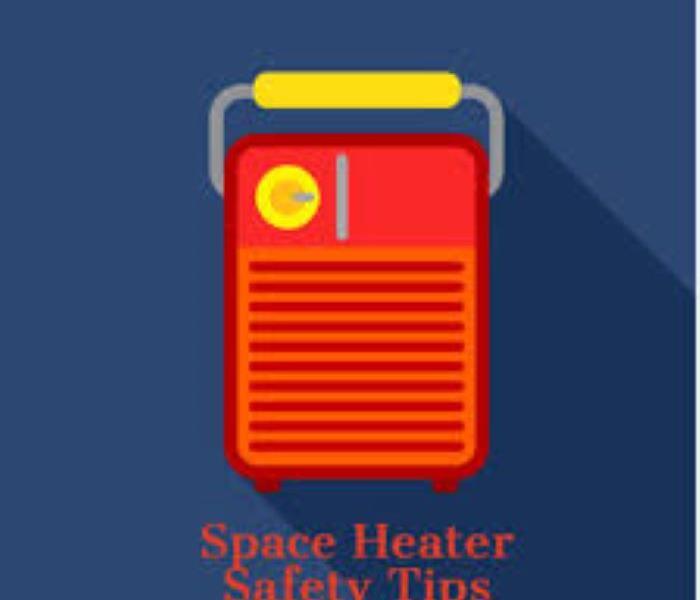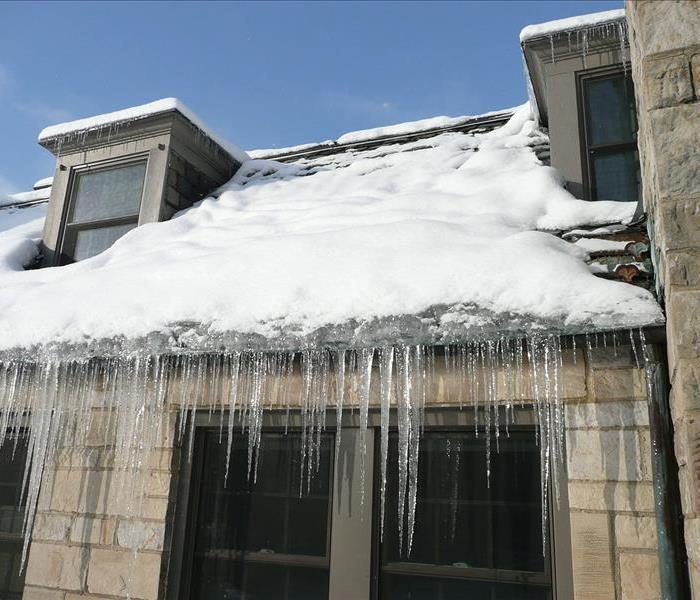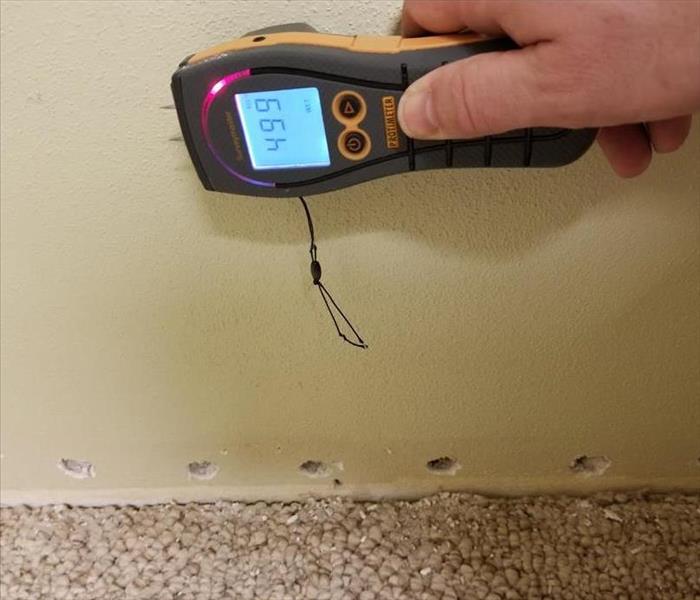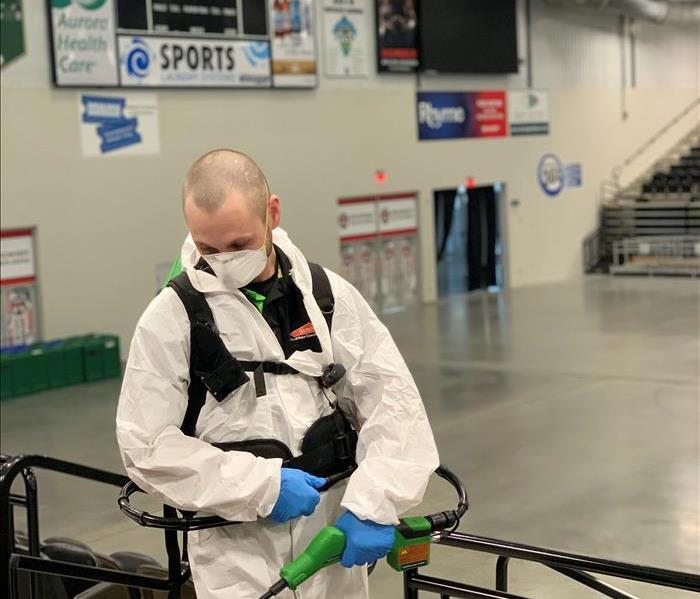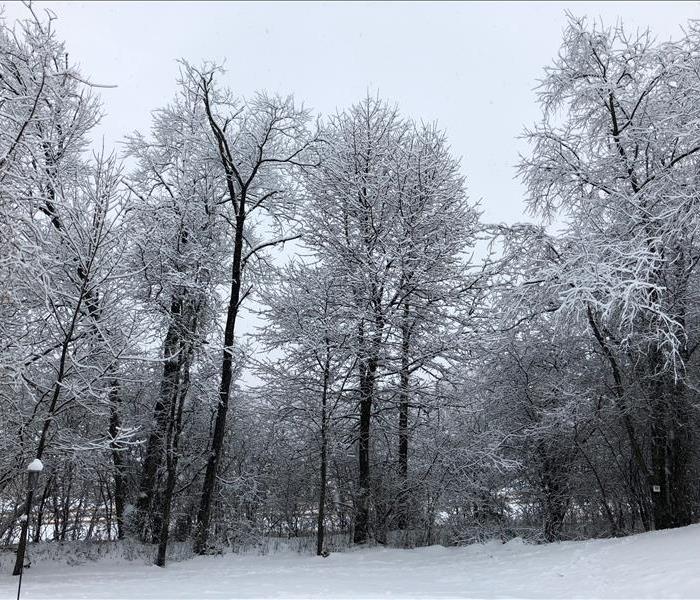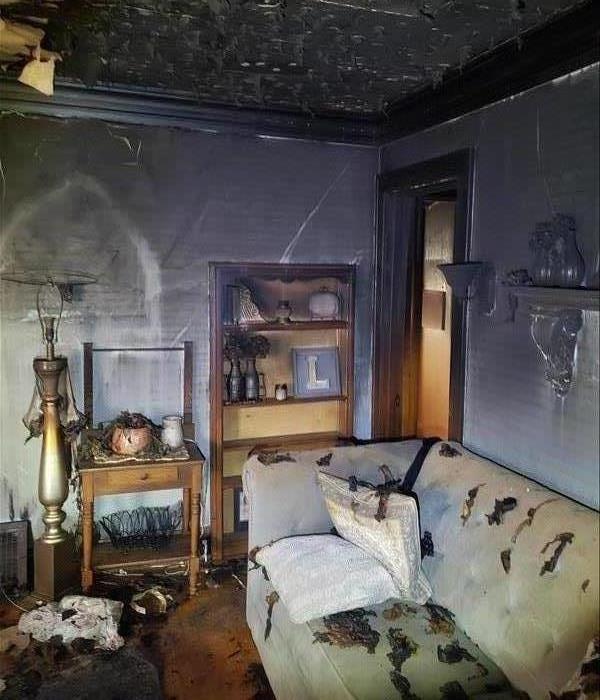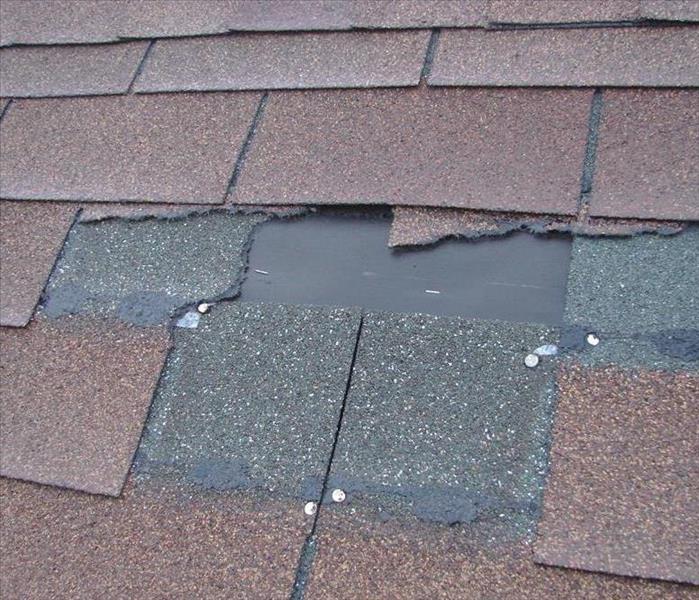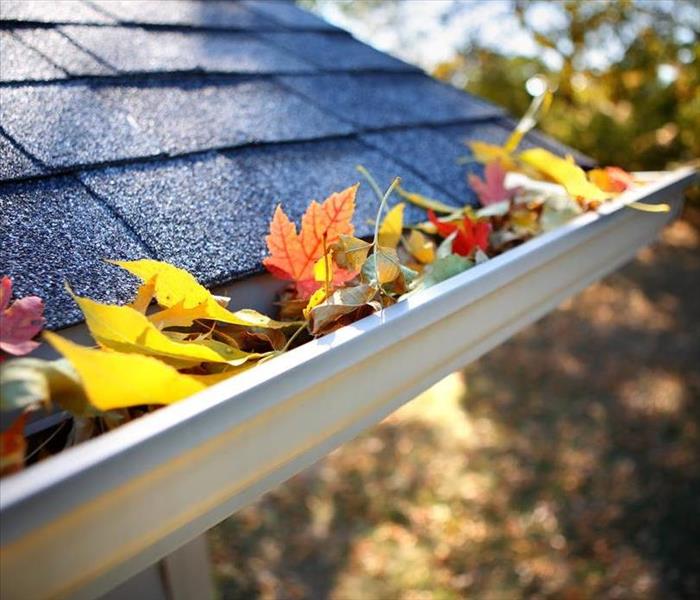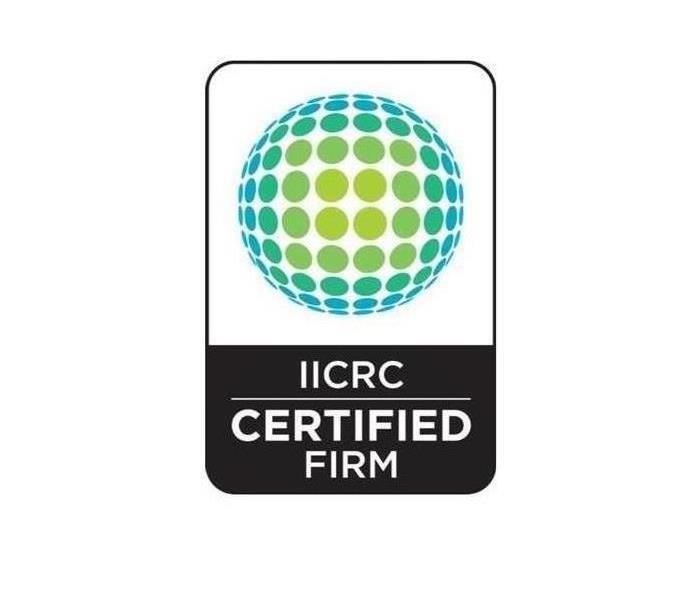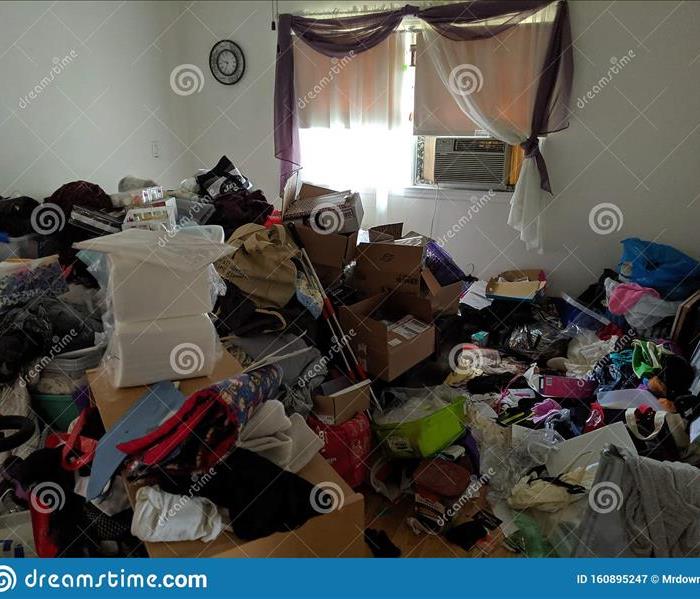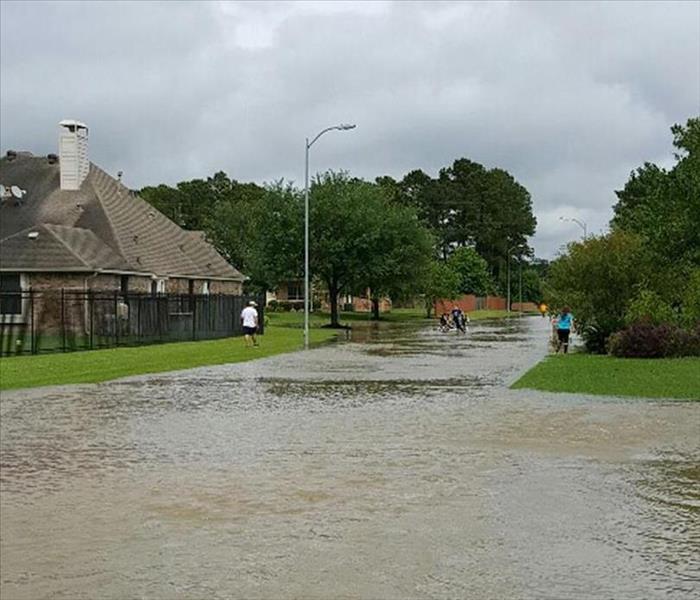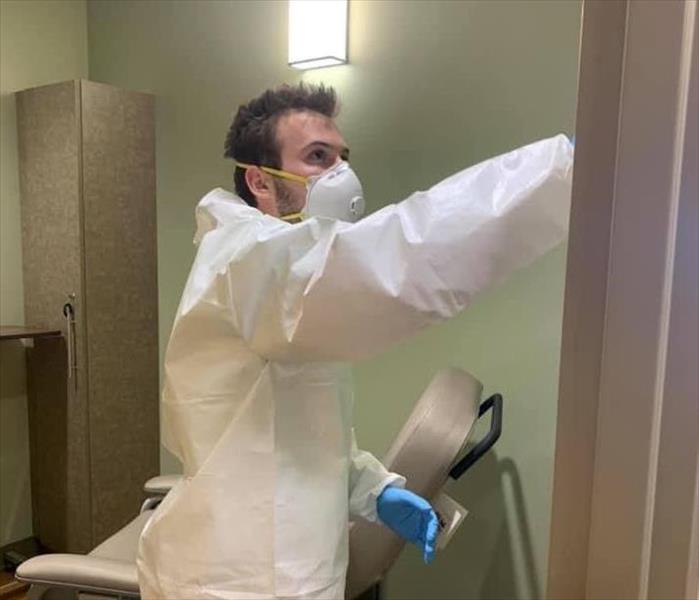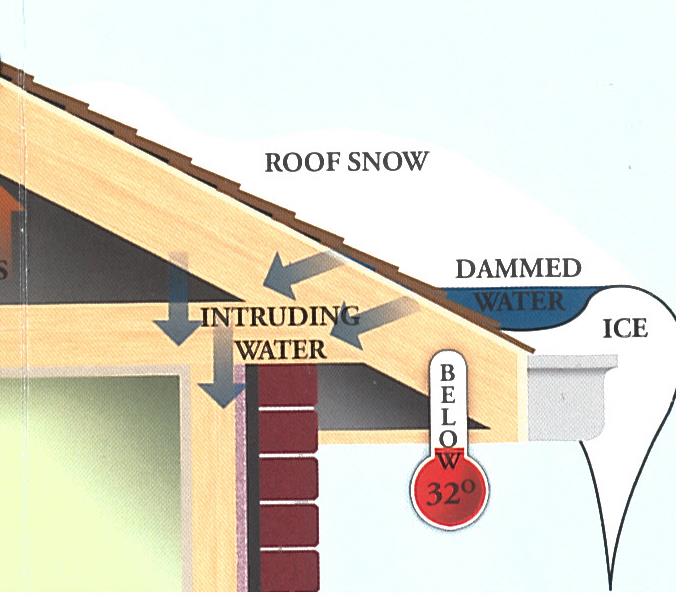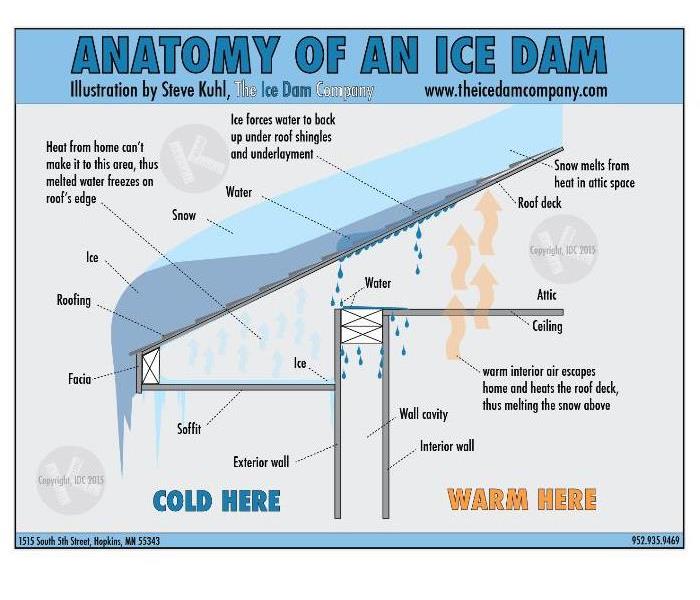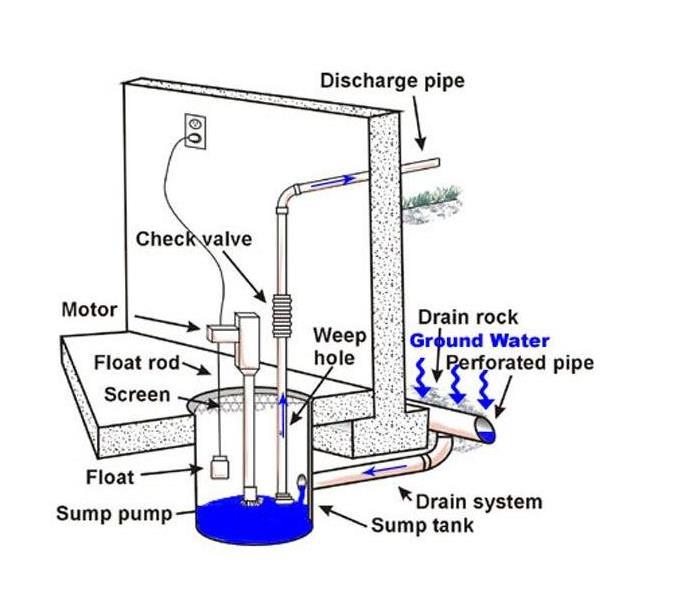Archived Blog Posts
Wisconsin Flood Awareness Week
3/8/2023 (Permalink)
March 6th to the 10th is Flood Awareness Week in Wisconsin. A flood plain is “an area of low-lying ground adjacent to a river, formed mainly of river sediments and subject to flooding.” That said a flood can occur just about anywhere given the right conditions. A flood is “the temporary overflow of water onto land that is ordinarily dry.”
This time of the year can be a particular problem for flooding when heavy rain falls on still frozen ground. It is not uncommon to see water flow across frozen ground in search of the lowest point to settle. If your home or business is in the path of that flowing water, you will have water damage.
What can you do to prevent this? Proper grading around your home or business is essential to keep the water flowing away instead of towards. Following is a great article on what needs to be done and why. Yard Grading 101: Everything you need to know (thisoldhouse.com)
National Repeat Day
6/2/2022 (Permalink)
June 3rd is National Repeat Day. Having to call SERVPRO to help clean up after a disaster is not something most people want to repeat. So today might be a good day to assess your property and determine if there is anything you can do to prevent that from happening.
While we typically think about cleaning our gutters in the fall, ideally gutters should be cleaned twice a year. Spring and early summer is another great time to clean your gutters. Keeping your gutters clean will allow rainwater to flow through them and away from your home’s foundation, helping keep your basement dry.
It is also a great time to check the slope around your foundation to ensure that rainwater running across the surface of the ground, because of heavy rain or frozen ground, will flow away from your home and not into it. Following is an article to help you determine if you have the proper slope around your foundation. If not, summer is a great time to make those adjustments so that next winter when we have rain on frozen ground, you don’t find water flowing into your basement. If you’ve ever had that happen to you, we’re sure it’s not something you want to repeat, especially since that type of flooding is typically not covered under your homeowners insurance policy.
How Much Slope You Need Near a House in Land Grading (thespruce.com)
Firework Safety Month
6/1/2022 (Permalink)
June is firework safety month. According to the National Fire Protection Association, “Fireworks caused an estimated 19,500 fires in 2018, including 1,900 structure fires, 500 vehicle fires, and 17,100 outside and other fires. Five deaths resulted from fireworks-started fires, along with 46 civilian injuries, and $105 million in direct property damage.” And this doesn’t include the injuries the fireworks themselves directly cause to individuals. According to the U.S. Consumer Product Safety Commission, each year 10,000 people are injured due to fireworks. In 2017 alone, 12,900 individuals were injured, with eight people dying. About 50% of all reported injuries are of children and young adults under 20. Out of this, 45% of the affected children are under the age of 14.”
With numbers like these it’s easy to see why it’s probably best to leave the fireworks displays up to the professionals. But if you are going to use fireworks this summer, here are some safety tips from the National Safety Council:
- Never allow young children to handle fireworks
- Older children should use them only under close adult supervision
- Never use fireworks while impaired by drugs or alcohol
- Anyone using fireworks or standing nearby should wear protective eyewear
- Never hold lighted fireworks in your hands
- Never light them indoors
- Only use them away from people, houses and flammable material
- Never point or throw fireworks at another person
- Only light one device at a time and maintain a safe distance after lighting
- Never ignite devices in a container
- Do not try to re-light or handle malfunctioning fireworks
- Soak both spent and unused fireworks in water for a few hours before discarding
- Keep a bucket of water nearby to fully extinguish fireworks that don't go off or in case of fire
- Never use illegal fireworks
Thunderstorms
6/1/2022 (Permalink)
We are in the heart of severe storm season in Wisconsin. Severe thunderstorms can occur any time of the year and any time of the day. But they occur most often between April and August, and in the late afternoon and early evening hours. This is because of the heat that is generated during these times. Thunderstorms usually develop in areas of high humidity. Moisture in the air that rises into the atmosphere in conjunction with warm temperatures causes a thunderstorm to form. Summer air has a greater potential for bringing on a thunderstorm because warm air can hold a lot more water vapor than colder winter air. And late afternoon and evening is typically the warmest time of the day, making it the perfect time for thunderstorms to develop.
Thunderstorms pose a wide variety of risks to your home or business. A lightning strike can cause a fire. High winds can blow shingles or other roofing materials off your roof making the structure vulnerable to water damage from the heavy rains that often accompany these thunderstorms. Lost power can mean a nonworking sump pump resulting in water in your basement.
Not much can be done to prevent these things. But a quick response can help limit the damage and prevent secondary damage. Be alert for threatening conditions and protect yourself first and foremost. But as soon as the storm passes, call SERVPRO to help you clean up. We can make it "Like it never even happened."
Renter's Insurance
5/21/2022 (Permalink)
Do you rent the property you live in? If so, do you have renter’s insurance? It’s not uncommon for renters to think they don’t need insurance, especially if the property owner has adequate coverage. Unfortunately, this usually isn’t true, and renter’s find themselves wishing they would have gotten renter’s insurance. Here’s why.
In general, the property owner’s insurance covers damage to the structure, while the renter’s insurance covers what we call “contents”, or the renter’s personal property, things like their furniture, clothing, shoes, electronics, accessories etc…
Let’s look at a specific example. Let’s say you are renting an apartment, and the tenants in the unit above you forgot they left the water running in their tub, it overflows, and water pours into your unit destroying your big screen tv and getting your couch all wet and dirty. The property owner’s insurance will cover the drying and repair of the structure itself, the carpet or flooring, the drywall, the light fixtures etc.. But it will not cover your big screen tv or couch. Those items would be covered under renter’s insurance.
An added benefit of renter's insurance is that because the coverage is for your personal items and not the residence, your belongings are typically covered due to theft and other covered losses when you travel away from home.
Renter’s insurance can also cover expenses like hotel and meals should your residence be uninhabitable from a loss. And it can also provide liability coverage should someone other than you get hurt on your property and attempt to sue you.
If you are a renter, and you don’t have this very important coverage, we highly recommend reaching out to your insurance agent today. A renter’s insurance policy can be as little as $10-$15 a month and is well worth the investment.
Commercial Construction Fire Hazards
5/18/2022 (Permalink)
Commercial properties often have fire safety and prevention systems in place. An effective system will incorporate three main elements: detection, control, and extinguishing. Components of these three things can include but are not limited to: fire & smoke alarms throughout the building, fire extinguishers throughout the building, sprinkler systems, fire/smoke curtains that drop down and contain smoke to certain areas and help hinder spread of the fire.
However, when a commercial building is under construction, these things do not yet exist. This means that commercial buildings under construction can be at increased risk of fire. In addition, according to the U.S. fire Administration, “Buildings under construction or renovation are at their most vulnerable and weakest condition. Accumulation of waste combustibles, limited access, minimal water supply and hazardous operations increase the challenge. Add to this the effects of firefighting operations, increased water weight, weakened metal and support structures, and hidden hot spots, and you have a formula for disaster waiting to happen.” For tips on fire prevention at buildings under renovation or construction visit:
Fire prevention at buildings under renovation or construction (fema.gov)
IICRC Triple Master
4/29/2022 (Permalink)
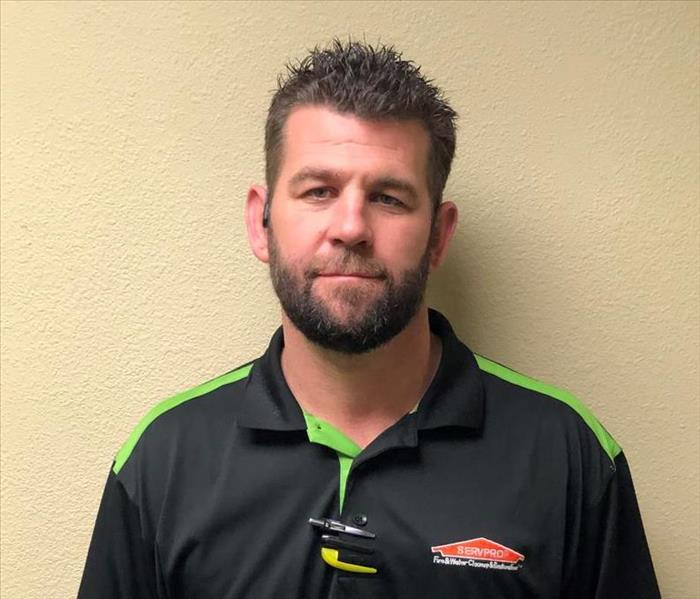 IICRC Triple Master Beau Baumgartner
IICRC Triple Master Beau Baumgartner
SERVPRO of Appleton is pleased to announce that our very own Beau Baumgartner is now a Triple Master, holding IICRC Master Certifications in all 3 available areas:
- Fire & Smoke Restorer
- Water Restorer
- Textile Cleaner
IICRC stands for “Institute of Inspection, Cleaning and Restoration Certification”. The IICRC is a certification and standard setting non-profit organization for the inspection, cleaning, and restoration industries. They develop health and safety related industry standards, as well as common, industry-accepted language and terminology.
IICRC offers over 20 certifications. Each certification requires candidates to successfully complete a course and get a passing grade on a standardized examination. Becoming a Master in each category is a long and labor-intensive process. It requires candidates to get all certifications related to that category in stages, as well as years of experience in the field and a final master exam. The first step is to get multiple certifications in the specific category as well as a minimum of 12 months working in the field for Journeyman status. Once that is achieved there are more certifications and a minimum of 3 years in the field before qualifying for the Master Course and exam. Only 3.7% of IICRC’s constituents have attained this prestigious designation. And we are fortunate to have one of them working for us!
Commercial Disasters
4/29/2022 (Permalink)
“According to the Association of Records Manager and Administration, about 60% of businesses that experience a major disaster such as a fire close within two years. According to Labor Department statistics, over 40% of all companies that experience a disaster never reopen and more than 25% of those that do reopen close within two years.
With numbers like this, it’s easy to see why hiring a good restoration company that can get your business back up and running as quickly as possible is vital. We have the staff and resources to do that. And we know exactly what you’re feeling and what you need. In March of 2014 we experienced a fire at our own shop when one of our trucks started on fire after being towed back to the shop after hitting a pothole. For over 2 months we operated our business from temporary rented space while our shop and office were being restored. As a result, we truly appreciate what you are experiencing, and our top priority is getting you back to business as usual. Your business depends on it.
ERP's & Hotels
4/12/2022 (Permalink)
Due to their nature, having so many bathrooms per square foot, hotels are at greater risk for water damage than most commercial properties. Each toilet, tub, and sink presents a risk of overflowing, a burst or leaky pipe etc… And when these water damages happen, the scope of the damage can be vast. With many floors/stories, there are plenty of places for the water to travel. As a result, a quick response is essential and can limit damage. To that end, an ERP (Emergency Ready Plan) from SERVPRO can be helpful, especially when a water pipe has burst.
What is an ERP? An ERP is a quick reference of important building and contact information. Information like where the water shut off valves are, the name and contact information for the building’s alarm system management company, and so much more. And your ERP can be loaded as an app on a phone for anyone who might need it, making it conveniently accessible anywhere or anytime, day or night. If your hotel or business would like a personalized ERP at no cost to you, call our office at (920) 832-1110 and ask for one of our sales representatives, Joe or Jamie. They would love to help you out.
Olympic Gold Medalist in the SERVPRO Extended Family
3/23/2022 (Permalink)
Growing up in the Michigan Upper Peninsula near a ski hill, our own Beau Baumgartner and his four siblings worked and spent a lot of their free time at the ski hill. For brother Nick, that turned into a career in snowboarding, with gold & silver medals at 2 Winter X Games, and 4 trips to the Olympics, culminating in a gold medal at the recent Beijing Olympics in 2022.
At the age of 40, Nick competed in the Beijing Games as the oldest American Snowboarder in Olympic history. But that distinction brought him gold. Nick and his partner Lindsey Jacobellis, 36, won the first ever Winter Olympics mixed team snowboard cross event. A mixed team snowboard cross consists of one man and one woman. In each round the men go down the hill first in groups of four. When the men cross the finish line, their times are transferred to their teammates. The women then take off in a staggered format based on the time difference. The first woman across the line wins.
We here at SERVPRO of Appleton are lucky to have Nick’s older brother Beau working for us. Beau joined us in the July of 2021 bringing with him 12 years of experience in the restoration industry with Service Master. Beau has been a huge asset to us. It is clear to us that Robert and Mary Baumgartner raised some very hard-working boys.
Dehumidifier Fire Risk
3/23/2022 (Permalink)
According to Wikipedia, “A dehumidifier is an air conditioning device which reduces and maintains the level of humidity in the air. This is done usually for health or comfort reasons, or to eliminate musty odor and to prevent the growth of mildew by extracting water from the air. It can be used for household, commercial, or industrial applications. Large dehumidifiers are used in commercial buildings such as indoor ice rinks and swimming pools, as well as manufacturing plants or storage warehouses. Typical air conditioning systems combine dehumidification with cooling, by setting cooling coils below the dewpoint and collecting the condensate.”
In the restoration business we use large dehumidifiers on a regular basis when mitigating water damage. Air movers or fans cause water to evaporate out of materials. But that moisture than evaporates into the air. Too much moisture in the air, or humidity, can also cause mold. Fans/air movers and dehumidifiers work together to get any water disaster properly dried.
Many homeowners and small business owners also use small dehumidifiers in their homes and basements to keep humidity and mold away. But did you know that dehumidifiers can also overheat and cause a fire? We have seen our share of home fires caused y dehumidifiers that have overheated. The US Consumer Product & Safety Commission issued its most recent recalls for dehumidifiers on August 4, 2021, indicating that the recalled dehumidifiers can overheat and catch fire, posing fire and burn hazards. The recall involves dehumidifiers manufactured before September 1, 2017, with the brand names including AeonAir, Amana, ArcticAire (Danby), Classic (Danby/Home Hareware Stores), Commercial Cool, Danby, Danby Designer, Danby Premiere, De’Longhi, Edgestar, Friedrich, Generations (Danby), Haier, Honeywell (JMATEK/AirTek) and Idylis to name a few. For a complete list visit:
Two Million Dehumidifiers With Well-Known Brand Names Recalled Due to Fire and Burn Hazards; Manufactured by New Widetech | CPSC.gov
Tornado Safety
3/22/2022 (Permalink)
The internet is filled today with images of a red pickup truck being blown over by a tornado in Texas. While tornadoes can occur anytime of the year, they are most common between the months of March and September, peaking in May, June and July. So now is a good time to refresh ourselves about tornado safety.
- A TORNADO WATCH means conditions are favorable for severe weather or a tornado to develop. People located in and around the watch area should keep an eye toward the sky and listen to your local tv or radio station, or weather radio, for further weather information. The watch is intended to give you time to prepare and review your safety rules.
- A TORNADO WARNING means that a tornado has been detected by the National Weather Service Doppler radar or a reliable report of a tornado has been reported from the field. A tornado warning is usually issued for portions of one or two counties for an hour or less. The storm could also produce large hail and destructive straight-line winds. If the tornado warning includes your neighborhood or workplace, you should seek safe shelter immediately.
While there is no place that is 100% safe from an incoming tornado, the Centers for Disease Control and Prevention (CDC) recommends seeking shelter in the following areas of the home:
- In the basement, if the building has one
- An inside room on the lowest floor of the building, such as a bathroom or closet
- Interior hallways
Entrepreneur Magazine Top 10 Franchise Company
3/18/2022 (Permalink)
“Entrepreneur is an American magazine and website that carries news stories about entrepreneurship, small business management, and business. The magazine was first published in 1977. It is published by Entrepreneur Media Inc., headquartered in Irvine, California. The magazine publishes 10 issues annually, available through subscription and on newsstands. It is published under license internationally in Mexico, Russia, India, Hungary, the Philippines, South Africa and others.”
Every year since 1979 Entrepreneur has published a list of their Top 500 Franchise Companies. The Franchise 500 evaluation process is based on what the magazine calls “The Five Pillars of the Franchise 500”: Costs and Fees; Size and Growth; Support; Brand Strength, and Financial Strength and Stability.
SERVPRO has been consistently making the list since 1988. But for the first time since 2016, SERVPRO was named a Top 10 overall franchise opportunity in 2021, even ranking above McDonalds. And we have held the #1 position in the cleaning and restoration industry for nearly 20 years in a row.
According to our CEO Rick Isaacson, “SERVPRO’s #10 overall ranking is a result of the hard work our franchises, their crews, and our dedicated headquarters team put in while many businesses were not so lucky. So many businesses were negatively impacted, slowed, or closed due to the pandemic. When COVID forced much of the world to slow down or step back, our team stepped up and did what it took, whether that was cleaning businesses so they could reopen safely or disinfecting first responders’ vehicles – man of those at no cost – to give back to those working every day to keep us safe.” We here at SERVPRO of Appleton have been proud to play our part by disinfecting the COVID areas of a local hospital on a daily basis, as well as many businesses when cases arose in their staff.
2021 Franchise 500 Ranking (entrepreneur.com)
.
Kitchen Fires & Fire Extinguishers
3/10/2022 (Permalink)
The number one cause of home fires is cooking. The kitchen is where the 3 things needed for a fire come together: heat, oxygen, and fuel. Oxygen is always present. Stoves provide heat. And cooking oil or the oil in grease provide the fuel. Almost 10% of cooking fires spread beyond the kitchen and cause significant damage to the house. And truthfully it doesn’t have to spread beyond the kitchen to do significant damage. The smoke can travel through out the house causing significant smoke damage.
You should never throw water on a grease fire because it can make it worse. You can douse a fire with baking soda or salt, but we often don’t have enough on hand to do the trick. The other problem with baking soda and salt is in the panic of the moment they can easily be confused for flour or baking powder, both of which are highly flammable and will make the fire worse.
Your best bet is to store a small fire extinguisher in the kitchen or very close by. But did you know that there are different types of fire extinguishers? It’s based on what is sprayed from the fire extinguisher. Some extinguishers use water, others use foam, others use chemicals. Obviously for the kitchen you don’t want a water-based fire extinguisher. Following is a great article on the different types of fire extinguishers to help you decide which one is right for you.
Most Common 5 types of fire extinguishers and their uses (teamworkholding.com)
Winter Rains Cause Flooding
3/9/2022 (Permalink)
This past weekend heavy rain fell in our area. With the ground still frozen and unable to absorb the rain, many people experienced wet basements and even flooding.
Water will gravitate to the lowest possible point. When the ground is frozen, rainwater can flow across the ground like a river towards that lowest point. If your home is in its path, you may experience water damage, especially if that flow encounters a basement window, egress window or other opening.
It’s important that the ground around your home is properly pitched or sloped away from your home. Flowing water must run away from your home not towards it. Following is a great video that shows you how to properly slope the ground around your home.
https://www.youtube.com/watch?v=5hYIda7tWqA&fbclid=IwAR2kGCJfBaieaNHKx4o
This spring would be a great time to get outside and check the ground around the foundation of your home or businesses, and make corrections if necessary. A little preventative maintenance could save you a lot of headaches and money next winter and early spring.
Flood Insurance
3/9/2022 (Permalink)
This past weekend heavy rain fell in our area. With the ground still frozen and unable to absorb the rain, many people experienced wet basements and even flooding.
Water will gravitate to the lowest possible point. When the ground is frozen, rainwater can flow across the ground like a river towards that lowest possible point. If your home is in its path, that water may enter your home or basement, especially if that flow encounters a basement window, egress window or other opening.
In another blog post we discussed how important it is that the ground around your home or business is properly pitched so that water flows away from the structure and not towards it, to prevent water intrusion. In this blog post we will talk about the financial implications of water damage incurred this way.
For the purposes of insurance, “flood” means any water outside the structure that flows inside at ground level. This past weekend we received many calls from homeowners experiencing a water loss in this manner. The problem is that standard homeowner’s insurance policies do not cover water damage as the result of flooding. Homeowners can purchase a sump pump rider that allows for coverage of water loss as the result of a failed sump pump. But even a sump pump rider does not cover actual flooding.
For flood water to be a covered loss, homeowners must purchase flood insurance. According to Wikipedia, “Flooding is defined by the National Flood Insurance Program (NFIP) as a general and temporary condition of partial or complete inundation of two or more acres of normally dry land area or two or more properties (at least one of which is your property) from: Overflow of inland waters, unusual and rapid accumulation or run off of surface water from any source…” It is estimated that only about 20% of homes at risk for this type of flooding are covered by flood insurance. For more on federal flood insurance, visit:
Myths and Facts About Flood Insurance | FEMA.gov.
Hoarding Experts
1/31/2022 (Permalink)
Years ago you didn’t hear much about hoarding. But with cable television shows like Hoarding: Buried Alive, many of us have now been exposed to hoarding. Simply stated hoarding is “a persistent difficulty discarding or parting with possessions because of a perceived need to save them.” “Hoarding disorder is a mental health disorder in which people save a large number of items whether they have worth or not.” Hoarding and OCD (Obsessive Compulsive Disorder) are closely related. They both fall under the obsessive compulsive and related disorders category in the Diagnostic and Statistical Manual of Mental Disorders, 5th edition. Hoarded items can vary but generally they are common possessions. Hoarded items can be anything from books, clothing, magazines, and containers, to garbage, rotten food and even feces and all of the above.
It’s important to note that hoarding is different than collecting. Collecting involves targeting very specific items, removing the items from ordinary use, organizing them, and often displaying them for the collector and others to admire. Hoarding is more impulsive and is usually very chaotic and disorganized. The resulting clutter takes over the home and disrupts the ability to use living spaces, while creating unsanitary and unhealthy conditions.
The overall prevalence of hoarding disorder is approximately 2.6%, with higher rates for people over 60 years old and people with other psychiatric diagnoses, especially anxiety and depression. The bulk of evidence suggests that hoarding occurs with equal frequency in men and women. Hoarding behavior begins relatively early in life and increases in severity with each decade, according to the American Psychiatric Association.
While we here at SERVPRO have extensive experience cleaning hoarding situations, it is essential that our services be combined with mental health therapy to treat the underlying cause. If the proper treatment is not done, the home will quickly return to its original state.
We are a Preferred Provider for Most Major Insurance Companies
1/5/2022 (Permalink)
Very often when you’ve experienced a disaster, your insurance company will cover the remediation and possibly even the rebuild process if you’ve purchased adequate coverage. That’s the good news. The bad news is many people find it daunting to deal with the insurance claims process. That’s where SERVPRO of Appleton can really stand out over other restoration companies.
We are a preferred provider for some of the top insurance companies in the business. We are a preferred provider for State Farm, American Family, Auto Owners, Erie, Hanover, and Farmers to name a few. What this means is we know exactly what these insurance companies are looking for in terms of photos, sketches, and other documentation, to process your claim quickly and efficiently with the maximum amount of coverage. We have multiple software programs that communicate directly with these major insurance companies and streamline the process for the customer.
And rest assured that while we know how to deal with insurance companies on claims, you are our customer, and we work for you! Our sole purpose is to make the restoration experience as smooth as possible for you, our customer. Your disaster is probably a once in a lifetime experience for you. But it’s what we do all day, every day.
The most important thing you can do when you call us is be prepared to give us the name of your insurance company, the claim number if you have it and the name and phone number of the adjustor that has been assigned to your claim. We will take it from there.
Winter Storms & Burst Water Pipes
12/14/2021 (Permalink)
Once again the Fox Valley is experiencing mild temperatures for this time of the year. But those of us who have lived in Wisconsin for any length of time know that winter storms and severe cold snaps are headed our way. Subzero temperatures, winter storms and even thawing periods create some of our busiest times of the year. The culprit, burst water pipes. Now is a good time to do a little preventative maintenance.
You might be asking yourself why thawing periods would be a problem. Without getting into the chemistry of water and what causes it, suffice it to say that water expands as it freezes. While this expansion can cause a weak pipe to burst, it's usually not the direct cause of a burst pipe. Pipes usually burst where little or no ice has formed. That's because the break is usually the result of increased pressure in the pipe and not expanding ice. Pipes burst when water thaws and begins to flow, but then runs into other, still-frozen parts of the pipe and builds up pressure.
What can you do to prevent burst pipes? The simple and most direct answer is to keep your water pipes warm and prevent them from freezing. Typically homes in Wisconsin are built with the water pipes located on the inside of the building insulation, which protects the pipes from subfreezing weather. That said, if your homes insulation is inadequate, you may have a problem. Also consider that any hole on an outside wall for things like television or cable wires, phone wires, or even furnace exhaust vents, can let cold air in. These openings need to be properly insulated as well. If you're building a new home, or doing a home remodel project, it's also a good idea to locate your plumbing pipes on inside walls versus outside walls whenever possible.
To further protect your water pipes, it's a good idea to insulate the pipes themselves. Most hardware stores or home improvement stores carry foam rubber or fiberglass sleeves that most homeowners can install themselves. Plumbing supply stores and insulation dealers carry pipe sleeves that feature extra-thick insulation, as much as one or two inches thick. These sleeves will obviously cost a little more but may be worth the extra cost.
One last thing to consider, even the best insulation in your home, and on your pipes, may not be enough to protect your pipes from freezing during particularly cold temperatures. If your furnace breaks down while you are out of town on vacation, you may return to a huge mess. If you plan to be out of town during the winter months, you may want to consider purchasing a remote temperature monitor, or a thermostat that allows you to monitor the temperature remotely. A remote temperature monitor is a digital thermometer that tracks ambient changes in temperature. The sensor then streams the temperature data using wireless technology such as Wi-Fi, Bluetooth or GSM to your computer, tablet or cell phone. This way you can be alerted to any problems at home, even when you're away, so that you can send someone to address the problem before it's too late. Remote temperature monitors are not terribly expensive. They can be purchased on-line or at hardware stores and home improvement stores for as little as $50 or less.
And as always, if one of your water pipes bursts and floods your home or business, the experts at SERVPRO of Appleton are here to help.
Holiday Candle Fires
12/8/2021 (Permalink)
Many people enjoy lighting candles during the holiday season. As a result, December is the biggest month for candle fires. “In 2016, the top three days for candle fires were Christmas Day, New Years Eve, and New Years Day. More than half (56%) of the December home decoration fires were started by candles, compared to nearly a third (31%) the remainder of the year.” According to the National Candle Association here are some candle safety basics:
- Before burning, trim the candle wick to ¼ inch in order to prevent a flame from being too large
- Always burn candles in a well-ventilated room and avoid drafts/vents
- Never leave a candle unattended
- Never place a candle near or on anything that can catch fire
- Use a candle snuffer to extinguish the flame (never use water)
- Do not move a candle until it is completely cooled
The best way to prevent house fires caused by candles is to not use candles at all. Here are some alternatives to candles that can help create that desired atmosphere and scent without the danger of a flame:
- Essential Oil Diffuser
- Battery-Powered Candles
- Candle Warmers
But if you do experience smoke or fire damage as the result of a burning candle, our experts at SERVPRO of Appleton & Winnebago County are available 24 hours a day, 7 days a week to help restore your property.
Water Damage Remediation Equipment
12/7/2021 (Permalink)
Air movers and dehumidifiers are the core of water damage remediation. They work in tandem to dry your property quickly and efficiently. While there is a scientific explanation to how air movers and dehumidifiers work together to dry, in very simplistic terms, air movers get air circulating and encourage water in flooring, drywall, furniture etc..to evaporate into the air. That can create a very humid environment, so much so that proper drying is hindered. That’s where the dehumidifiers come in. They remove the excess water from the air.
We use industry standard formulas to tell us how many air movers and dehumidifiers are needed for each water loss situation. You might be surprised just how many air movers and dehumidifiers it can take to properly dry your loss. But rest assured, no matter what the size of your loss is, we have the equipment to fit your needs. We have over 1,000 in our shop at any given time. Whether your water loss is contained to a corner of your kitchen from a leaky frig or spans thousands of square feet in a warehouse, we’ve got you covered.
Once we remove our equipment from you property, it is brought back to our shop, cleaned & sanitized, shrink wrapped onto pallets and stored for the next disaster.
Clogged Gutters
11/17/2021 (Permalink)
Fall color came a bit late this year. Many trees are still dropping leaves in the middle of November. So while you may be used to cleaning your gutters earlier in the season, you will want to get out there and make sure your gutters and ridge lines are free of leaves and other debris now before the snow flies in earnest. Keeping your gutters free of leaves and debris will keep rain and snow melt flowing through your gutters and away from your home. This preventative maintenance will help avert water damage to your home this winter. Clogged gutters can cause ice dams in the winter, and ice dams can result in water damage to your home.
An ice dam is a ridge of ice that forms at the edge of a roof and prevents melting snow (water) from draining off the roof. As snow melts from your roof, either by the heat of the sun, or by heat escaping from your home, it tends to refreeze at the edges and other juncture points of your roof. The refreezing of water has a damming effect creating an even bigger ice dam behind it. Continuous feeding of the ice dam by melting and refreezing snow melt can cause significant damage. As the water seeps under shingles, it refreezes expanding and creating an even bigger gap for future drainage to fill and further the cycle. Your shingles are being raised and eventually the water that backs up behind the dam, and underneath the shingles, can leak into your home and cause damage to walls, ceilings, insulation, and create a perfect environment for mold growth.
The forecast for the Fox Valley area this weekend is dry and low 40’s. A perfect time to get out there and make sure your gutters are clean
Duct Cleaning
11/17/2021 (Permalink)
For several years now we have been so busy with restoration work, and most recently covid cleaning as well, that we have not been able to do duct cleaning work. Whenever we received calls for this service, we would refer them to our favorite duct cleaning contractor. But we are excited to announce that recently we staffed up with highly trained personnel to focus on duct cleaning. We are so excited to be adding this service versus referring our customers elsewhere.
According to Wikipedia, “Ducts are conduits or passages used in heating, ventilation, and air conditioning (HVAC) to deliver and remove air. The needed airflows include, for example, supply air, return air, and exhaust air.” But why is it important to clean them you might ask.
Ducts are just like any other surface in your house. They collect fine dust, pet dander, hair, dead skin cells and more. And since we don’t dust our vents regularly like other surfaces in our home, eventually these things become matted down and become a perfect surface for things like bacteria and mold to grow. Since ducts also commonly deliver ventilation air as part of the supply air, keeping them clean is one method of ensuring acceptable indoor air quality as well as thermal comfort.
Hurricane Ida
9/29/2021 (Permalink)
Recently Hurricane Ida struck causing damage and massive flooding all the way up from the gulf coast to the New York and Jersey areas. As you can imagine, restoration companies in the affected areas could not keep up with the demand for assistance.
While SERVPRO locations are franchised and independently owned, they are also part of a national network with the organizational capacity to mobilize and send crews from all over the country to areas hit hard by disaster.
We here at SERVPRO of Appleton are proud to have the capacity to send an amazing group of employees, who are willing to leave their own homes and families, and travel to other parts of the country to help when the need arises, while still servicing our customers here at home.
This crew recently spent a couple of weeks out in the New York and New Jersey area and we couldn't be more proud.
We Are a One Stop Restoration Company
6/30/2021 (Permalink)
In a previous blog post we discussed the fact that making your emergency “Like it never even happened,” is most often a two-step process. First there is the clean-up/mitigation of the damage done by the water, fire, smoke, mold, or other disaster. And while our primary goal is to save as much of the structure and contents as we can during the mitigation process, very often we must remove or displace some things so that we can properly mitigate the damage. For example, sometimes cabinets need to be removed, in order to get air circulating behind them, so that proper drying can take place.
This leads to the second step in the process which is the rebuild process. In this process we put things back in their proper place and replace things that could not be saved like drywall, carpeting etc…In our previous example, the cabinets would be put back in place during the rebuild process.
Not all restoration companies are able to rebuild after a disaster. With some restoration companies the customer needs to find a second company to do the rebuild work. At SERVPRO of Appleton however, we have two full-time carpenters on staff, as well as a host of excellent subcontractors to handle all the customer’s rebuild needs. While each of these steps is a separate service and billed independently, it is helpful for the customer to have one contractor managing the process and dealing with the customer’s insurance company.
This also means that we are more than just a restoration company. Our rebuild team would be happy to give you a quote for any of your home remodeling projects. You need not have an emergency to call SERVPRO of Appleton. Call our office today at (920) 832-1110 for more information.
Flash Floods
6/29/2021 (Permalink)
While early June was hot and dry, this past week has brought quite a bit of rain to our area. Summer rains can sometimes result in Flash Floods. According to Wikipedia, “A Flash Flood Warning is a hazardous weather statement issued by the National Weather Forecasting agencies throughout the world to alert the public that a flash flood is imminent or occurring in the warned area. A flash flood is a sudden, violent flood after a heavy rain, or occasionally after a dam break. Rainfall intensity and duration, topography, soil conditions and ground cover contribute to the flash flooding.”
Flash flooding can present a risk for water damage to your home or business. Flash floods can result in water flowing across the ground like a river. If the ground around your home or business is not properly graded/pitched so that water flows away from the building, flowing water can flow towards your home and enter through basement windows, doors and other openings causing a significant amount of water damage.
It is important to periodically take a level and check the ground around your home or business to ensure it is properly pitched away from the structure. Pay particular attention to planting beds and other areas where the slope of the ground may be hidden by bushes or other vegetation. What you want to see is a slope or pitch away from your home of 1 inch per foot.
Following is a great video showing you how to check your slope and fill any low areas as necessary. This simple maintenance can prevent water damage and save you money and stress. How to Properly Grade Around Your Home - YouTube
Cooking Fires
6/9/2021 (Permalink)
In a blog post a few months ago we discussed space heaters and the fire risk they present. Space Heaters are the second most common cause of home fires. But the number one cause of home fires is cooking.
According to the NFPA “US fire departments responded to an estimated average of 172,900 home structure fires per year started by cooking activities in 2014-2018. These fires caused an average of 550 civilian deaths, 4,820 reported civilian fire injuries, and more than $1 billion in direct property damage per year.”
The top causes of cooking fires are:
- Placing combustible items too close to the stove or other heat source such as oven mitts, pizza boxes, dish rags etc…
- Unintentionally turning on the stove or heating element, or forgetting to turn it off
- Leaving cooking food unattended
Keep these things in mind when cooking because every year we get many calls for fires caused for each of these reasons.
Water Main Shut Off Tags
5/26/2021 (Permalink)
Water pipes can burst for a wide variety of reasons. The most common reasons include:
- Water Pressure Changes
- Frozen Pipes
- Corrosion
- Moving Pipes
But no matter what causes the burst pipe, getting to the water shut off valve quickly and shutting off the water supply is key. The longer water flows, the more damage will be done and the costlier the clean up and mitigation will be. This is especially true in commercial buildings where a single pipe can be expected to supply enough water to suppress a fire in a million square foot building. Millions of gallons of water could potentially be gushing out every minute.
As discussed in previous blog posts, our sales team would love to help you prepare for such a disaster with an ERP (Emergency Ready Plan). An ERP will provide a map of the property showing where things like the water shut off valves are.
Our Water Main Shut Off Tags are also helpful. They are bright orange and they make spotting the valve particularly easy. And while the ERP will also contain essential phone numbers during a disaster, our Water Main Shut Off Tags put our phone number right at your fingertips. Because a prompt response can make all of the difference for your home or business.
If you would like your own Water Main Shut Off Tag/s, call or stop by our office. (920) 832-1110
Spring Storm Season
5/20/2021 (Permalink)
It’s spring in Wisconsin. And with it comes storms and tornado season. April through September is considered tornado season in Wisconsin. That said, tornadoes can occur any time of the year, but happen most often in the months of May, June and July. Of those three months, Wisconsin tends to see the most tornadoes in June.
Tornado season tends to be one of our busiest times because storms pose multiple threats to your home or business. Lightning strikes can start a fire. High winds can blow off shingles and allow water to intrude into your home. High winds can also topple power lines leaving you without electricity and a working sump pump, which can result in water in your basement. Large amounts of rain can result in flooding or run off that can run into your home or business if the surrounding ground is not properly graded.
Unfortunately, you cannot prevent strong storms and tornadoes. But you can be prepared. You can make sure your home is in good repair so it can withstand high winds and you can make sure the ground around your home is properly graded so that ground water runoff flows away from your home instead of towards it. And of course, you can keep SERVPRO of Appleton’s phone number handy. Prompt response to disaster is key to mitigating the damage.
SERVPRO of Appleton will help you clean up and insurance will cover the cost of damage to your property. You need to focus on staying alert and staying safe during a storm. Local television and radio station typically broadcast weather alerts. If you do not tend to listen to local stations, a weather radio can be helpful during storm season.
A WATCH means that the conditions are perfect, and the potential exists, for the development of severe storms or tornadoes but nothing is currently happening. A WARNING means that severe weather is imminent in your area or is already occurring. If a warning is issued, you should take shelter immediately.
ERP's (Emergency Ready Plans) for Businesses
5/4/2021 (Permalink)
What is an ERP (Emergency Ready Plan)?
Whether you own a home or a business, it’s important to be ready for a potential disaster. But it’s particularly important when you own a business. According to a report from the Federal Emergency Management Agency (FEMA), 40% of businesses never reopen following a disaster. And of the ones that do, another 25% fail within one year.
That’s why your business needs an Emergency Ready Plan. While an ERP can’t stop a disaster from happening, it will help your business be ready to handle one.
An ERP is a document that contains the critical information you need in the event of an emergency or disaster. This document can even be loaded as an app on your phone, providing ready access for key employees any day, any time; because disasters don’t just happen during business hours. An ERP will:
- Provide a detailed map of your facility showing where to find important things like water shut-off valves, fire extinguishers and other priority areas. This will allow any employee to get to these areas quickly and efficiently. Prompt response is key in any disaster to help lessen damage. If there is a water main break, the quicker you get to the shut off valve, and stop the flow of water, the less damage there will be. If there is a fire, the quicker you get to a fire extinguisher the better.
- Put all essential phone numbers in one place. All of the essential phone numbers for things like: SERVPRO, the sprinkler system emergency contact, the building owner emergency number, local fire department will now be at any employees finger tips.
- Help employees identify the chain of command and who within the organization has the authority to authorize emergency clean up services to begin. In order for any restoration company to begin work, proper authorization forms must be signed. Any delay in recognizing and reaching the person who has the authority to authorize the work, will result in costly delays to mitigating the damage.
- Be free of charge to your business. Our friendly sales staff would love to do an ERP free of charge for your business. It won’t take much time, and it could save your business.
Be ready with an Emergency Readiness Plan (ERP) from SERVPRO of Appleton and Winnebago County.
Call 920-832-1110 to schedule your FREE plan
Fire Sprinkler Systems in Commercial Buildings
4/7/2021 (Permalink)
When we think of a sprinkler system, we often think of an outdoor system of hydration, watering our lawns in a residential application, or watering a golf course in a commercial application. But buildings can have sprinkler systems as well. Building sprinkler systems protect against fires.
A fire sprinkler system is a water piping system in the ceiling, connected to a water supply, with adequate pressure and flowrate, onto which sprinkler heads are attached. The system discharges water through the sprinkler heads when they detect a rise in temperature adequate to suggest a fire may be present. Historically sprinkler systems were only used in factories and large commercial buildings. Today they have become affordable enough to be used in smaller buildings and even homes.
The National Fire Protection Association (NFPA) is the main organization that sets the standards for fire safety including fire sprinkler system requirements. Some requirements are up to local municipalities. However, according to NFPA 13, all newly constructed commercial buildings that are 5,000 square feet or larger are required to have fire sprinkler systems. In addition, any remodels that add square feet to an existing commercial building so that its footprint is 12,000 square feet or more mandates installation of a fire sprinkler system. NFPA also states that any townhomes with more than two units per building require an automatic fire sprinkler system.
While early systems dispersed water from every head when one head was triggered, systems today only disperse water from the head/heads that detect excessive heat. This helps to minimize water damage to areas of the building not affected by fire. This was one of the primary hesitations people had about sprinkler systems. They felt they were trading fire damage for water damage. As a result, fire sprinkler systems are extensively used today.
Worldwide, over 40 million sprinkler heads are fitted each year. In buildings completely protected by fire sprinkler systems, over 96% of fires were controlled by fire sprinklers alone.
Hardwood Floor Water Damage
4/7/2021 (Permalink)
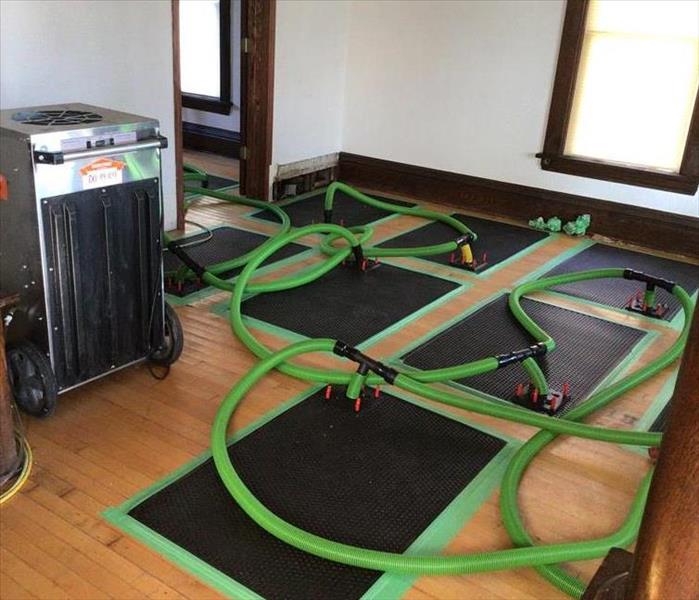 Injecti-Dry system used to dry hardwood floor after a water damage
Injecti-Dry system used to dry hardwood floor after a water damage
Natural hardwood floors have been a popular flooring choice for homes & businesses alike throughout time. They can be a bit pricey but they truly are an investment in your home or business. If properly cared for, quality hard wood floors can be sanded down and refinished resulting in a floor that can last the life of the building.
Although sturdy they present unique challenges when water damage occurs. Hardwood is naturally porous and easily holds moisture. Having a large amount of water in contact with the floor for a long period of time can be very damaging. The first 24 hours are the most critical. The longer the floor has contact with water the more damage can be done.
Water can cause the following damage to hardwood:
- Cupping - This is when the edges of the individual planks are slightly raised compared to the center of the board. By a visual exam it will look like the shape of a cup, thus the name cupping.
- Buckling - This is when the floorboards have expanded past their capability. The edges expand upwards at the seams making a peak.
If your hardwood floors become water damaged SERVPRO can help. We use an Injecti-Dry system on hardwood floors. This system is extremely quick, easy, and efficient to set up. Injecti-Dry consists of mats and hoses mounted directly to the floor. Hoses are used to extract the moisture out of the seams. A dehumidifier is placed nearby to help combat the humidity given off by this system.
Again, prompt action is essential in saving hardwood floors from water damage. Some minor cupping can be repaired by sanding down the cupped edges and refinishing the floor, but once buckling occurs, there is nothing that can be done and the floor must be replaced.
That is why it is important to call SERVPRO as soon as moisture has been detected.
National Mom & Pop Business Owner's Day
3/29/2021 (Permalink)
March 29th is National Mom and Pop Business Owners Day, a day that honors all small business owners. SERVPRO of Appleton uniquely qualifies as both a big business and a small business.
SERVPRO Industries was originally launched in 1967 by Ted and Doris Isaacson as a painting business in Sacramento, California. But with their background in cleaning and restoration, they transformed the company into a franchisor of cleanup and restoration specialists. They sold their first franchise in 1969. By 1988, there were 647 franchises and the corporate headquarters was moved to Gallatin, Tennessee. Today there are over 1,900 franchises in the United States and Canada.
According to Wikipedia, “Despite the franchise structure of numerous relatively small entities, SERVPRO has the capacity and organizational competence to respond to large-scale disasters, including major corporate and government contracts…” This means we are uniquely positioned to respond to major disasters, much like a large company, while remaining a locally owned, small family business.
Small businesses are a vital part of the U.S. economy. According to the U.S. Small Business Administration, there are more than 27 million small businesses in the United States. 59.9 million people or 47.3% of the private work force are employed by small businesses.
SERVPRO of Appleton was founded in 1992 by Mr. Kelly Rousso. Kelly’s first employee was Debbie Soloway. Together they built a thriving business. In 2014 Kelly sold the business to C.J. Snyder. Debbie and a few other key employees, like Joyce Ebajan, stayed on and helped C.J. grow the business to close to double its size in 2021 from when he purchased it in 2014.
Today SERVPRO of Appleton employs approximately 30 people. C.J.’s wife and 3 grown kids have all worked for the business at various times. In addition, we sincerely view all our employees as part of our SERVPRO Family. They are true heroes helping people during their time of need.
Continuing Education Classes for Insurance Professionals
3/29/2021 (Permalink)
Specific requirements vary by state, but most states require insurance professionals to complete about 24 hours of continuing education every 2 years. Completing their CE requirements not only keeps their insurance license active; it also keeps them updated on the latest rules, regulations, and products to keep them competitive.
Every year since 2017 SERVPRO of Appleton has been hosting 2 Continuing Education Classes for Insurance Professionals free of charge at Neuroscience Group Field, home of the Wisconsin Timber Rattlers Baseball Team.
This year there was a morning session on Ethics, and an afternoon session on Restorative Drying for Water Damage with a catered lunch in between.
These classes are always very popular. The venue is quite beautiful, the food is great and the Timber Rattlers mascot often joins us to raffle off tickets for the upcoming season.
While things looked a little different this year with covid social distancing, we were thrilled to still be able to hold this very popular event. If you are interested in joining us in March of 2022, watch our facebook page early next year for more information.
SERVPRO Works to Keep You Open for Business
3/26/2021 (Permalink)
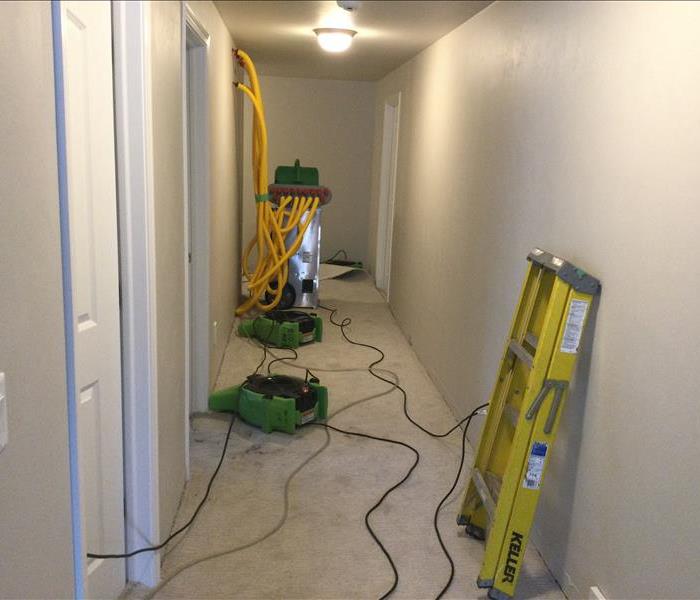 Drying Ceiling in place to reduce disruption and reduce cost.
Drying Ceiling in place to reduce disruption and reduce cost.
When disaster strikes and water floods your home or business, you need it dried quickly and efficiently. Drying things quickly is always important to prevent secondary damage. But it takes on added significance when the damage is at a place of business. Every day that your business is impacted is lost revenue.
Water trapped inside walls and ceilings can be especially troublesome because there’s no easy way to pull moisture through drywall or plaster. Other companies, and remodeling contractors, may be quick to start tearing your home or business apart. This is not only incredibly disruptive, but it can add huge costs to the repair side of the process. Here at SERVPRO we take unique and creative measures to dry your home in the fastest yet least invasive way possible.
In this case we had a wall that had absorbed some water near the ceiling of this hallway. Other companies would have just ripped the drywall out, but we decided to use a spider hosed attachment on one of our fans to inject air into the wall cavity through tiny port holes. This approach saved the homeowner hundreds of dollars in repairs, weeks of time, and they never had to worry about demolition in their home. This is a fantastic example of how we go above and beyond for our customers.
Water Damage from Hydronic Heat Systems
3/25/2021 (Permalink)
Hydronic or water-based radiant heating systems are common in commercial buildings and are even found in residential homes. What are they and why are they used? In a hydronic heating system, water is heated and moved through a system of sealed pipes to radiators throughout the building. Once the heated water is used, it is returned to be reheated via a recirculating system.
Hydronic heat has many advantages. One advantage is the variety of places it can be used. It is even used to heat the Frozen Tundra at Lambeau Field. Green Bay was the first NFL team to heat their field and they have been doing it since 1967. Originally an electric coil system was used. But in 1997 that was replaced with a new, more efficient hydronic system. Buried 6 to 12 inches below the turf is a series of pipes with a combination of warm water and antifreeze running through them. This system prevents the soil and the roots from freezing.
Systems similar to the one at Lambeau Field are used in the cement slabs of commercial buildings. They are even used in basements of residential homes. They can be used to heat swimming pools. The possibilities are many.
Other advantages to hydronic heating:
- Unlike air forced central heating systems there are no airborne particles, providing a totally dust free and allergen free form of heating
- When used to heat the air through radiators or panel radiators, the radiators can be individually adjusted to provide ultimate comfort in each room
- Panel radiators push out natural radiant heat which spreads evenly
But hydronic heat systems are not without their disadvantages. We here in the water restoration business see one of their biggest disadvantages regularly. All pipes run the risk of bursting due to pressure changes or below freezing temperatures. This can happen with plumbing pipes, sprinkler system pipes and hydronic heating pipes. When a pipe in a hydronic heating system bursts, the resulting water damage can be massive if not caught immediately. The system tries to compensate for the loss and keeps pulling more water in to the system. Add to that the loss of heat in the building and an icy mess can be the result. The attached picture of an ice filled bathtub is from a home that experienced such a loss.
Clothes Dryer Fires
3/25/2021 (Permalink)
Any appliance that creates heat can be a fire hazard and there are many of them throughout our homes and businesses. They range from the small and seemingly insignificant like a curling iron, to the big and more obvious like a stove. A significant one we tend to overlook is a clothes dryer.
Most of us know that a clothes dryer produces lint. As our clothes, towels and sheets tumble around in the dryer, fine fibers separate from the cloth. These fibers are called lint. Dryers are equipped with lint traps to collect the lint. It is extremely important that the lint trap is cleaned after every load. Cleaning the lint trap helps air flow and keeps the machine running more efficiently. But perhaps more importantly, cleaning the lint trap helps reduce the risk of fire. Dryer lint is extremely flammable. If enough of it accumulates, the heat from the dryer can ignite the lint and cause a fire. The lint trap is not perfect. Even with regular cleaning lint can get past it. Cleaning your lint trap after every load and even a thorough cleaning of your dryer’s venting system will go a long way towards preventing fires.
Recently we were called to a fire caused by a commercial clothes dryer at a boutique hotel in downtown Appleton. Luckily, the fire was noticed quickly, and damage was fairly contained. That is why some people prefer to be home when they run their clothes dryer versus turning it on and leaving the house for several hours.
Chimney Fires
3/18/2021 (Permalink)
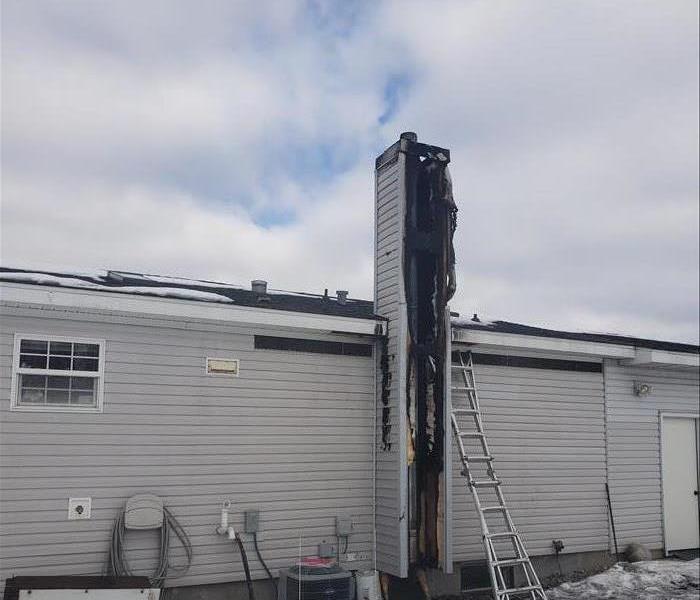 This chimney fire in Stevens Point, Wisconsin caused significant smoke damage to the inside of the house.
This chimney fire in Stevens Point, Wisconsin caused significant smoke damage to the inside of the house.
According to Wikipedia, “A chimney fire is the combustion of residue deposits referred to as soot or creosote, on the inner surfaces of chimney tiles, flue liners, stove pipes, etc.”
So, what is creosote? When wood burns, certain by-products or substances are produced. There is the smoke you can see, as well as things you cannot see like tar in the smoke, water vapor, gases, unburned wood particles, and assorted minerals. These by-products are warm, and when they pass through the cool chimney, condensation forms. The resulting residue sticks to the inner walls of the chimney creating something called creosote. Creosote is brown, sticky and highly flammable. If enough creosote builds up, and the temperature in the chimney becomes high enough, a chimney fire can erupt.
There are things you can do to help minimize your risk of a chimney fire. Here are three things to avoid that encourage the build-up of creosote:
- Burning wet and/or unseasoned wood or things like wrapping paper that may contain chemicals. Your wood should be seasoned or dried for at least 6 months after chopping and kept stored under cover to prevent it from getting wet. If you want to be extra certain your wood is sufficiently dry, you can purchase a cheap moisture meter (for more info on moisture meters see our previous blog post on what they are and how they work) at a hardware store. The moisture content of your wood should be no more than 20%
- Not having an adequate air supply. Always make sure your fire is getting enough air by making sure your chimney flue is completely open and the glass doors are open
- Avoid cooler chimney temperatures by ensuring your chimney is adequately insulted
But probably the most important thing you can do to avoid a chimney fire is to have your chimney regularly inspected and cleaned by a certified Chimney Sweep.
"Three Cheers" for SERVPRO
3/17/2021 (Permalink)
As mentioned in a previous blog post, we recently had the honor of sending 2 crews to the Dallas, Texas area to help after the historic winter storm that caused burst pipes and water damage to so many homes and businesses. The people of Texas showed their gratitude by humbling us with multiple five star google reviews as well as the following kind words in the “Three Cheers Section” of the Dallas Morning News.
“SERVPRO – The cavalry arrived on a recent Sunday afternoon to our house in the form of four bright green SERVPRO trucks with Appleton, Wis., painted on the sides. When the SERVPRO Operations manger first called us to schedule an appointment after the storm, I noticed a strange 920 area code. After making the appointment, I thought I should do a bit of work to make sure it wasn’t some sort of scam. As the Dallas Morning News Watchdog says, “It’s good to be overly careful.”
I called the local SERVPRO franchisee and found out that the company brought in over 1,000 folks from around the country to help Texans get their homes back in shape. A woman on the crew told me that this was her first time to help during a disaster and that she is proud to be helping people recover.
I am thrilled there are people like her and the rest of the team. I just wanted to say thank you and recognize all those who traveled far to help.
I’m sure there are others from around the country, and this “Three Cheers” is for all who have come here to help.
Perri Brackett, Lewisville”
Perri, thank you so much for the “Three Cheers”! We were honored to be a part of this historic effort and we too are grateful for our amazing employees! They really are like heroes helping people during a time of need.
Texas Winter Storms
3/9/2021 (Permalink)
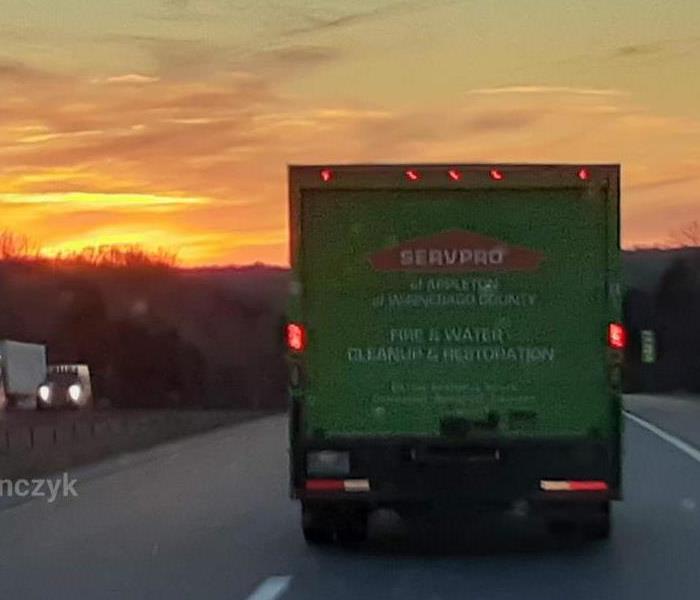 On the road in Texas
On the road in Texas
Recently Texas, and other states across the south, experienced a historic winter storm with record amounts of snow and record low temperatures. All throughout Texas records were broken. 10.1 inches of snow fell on San Angelo, Texas. The previous record was 2.5 inches in 1951. Houston received 6.4 inches of snow. That’s the most snow Houston has received in 55 years. The border city of Brownsville reported snow for only the 3rd time since 1898. Both Dallas and Houston experienced temperatures well below freezing. And sadly, these storms led to a failure of the power grid in Texas leaving millions of homes and businesses without power and most importantly heat. This lack of heat has resulted in frozen and burst pipes leaving millions of Texans with water damaged property. At one point, SERVPRO had over 26,000 customer service requests.
SERVPRO activated their Storm Team and called upon their national franchise system to work together to help Texas, Oklahoma, Kansas, Missouri and Arkansas. SERVPRO is the only restoration company in the business that has the capacity and organization competence to respond to such large-scale disasters. SERVPRO crews from all over the country have descended upon these areas to assist in the clean up effort.
We here at SERVPRO are proud to have 2 crews working in the Dallas, Texas area. We are so proud of all our incredible employees who have stepped up to assist their fellow citizens. From the employees who left their own homes and families to go down to Texas, to the employees who stayed here in Wisconsin and are picking up the extra slack during their teammate’s absence, to our incredible office staff who is supporting them all and doing double duty, we are so proud of them and we are grateful for all their efforts. Not only are they heroes to people in need, but they are doing it with an attitude of gratefulness. In response to a thank you for her efforts, one employee said, “I’m honored. Thank you for the opportunity.”
And the people of the Dallas area are thanking them by showering us with 5 star google reviews all the way from Texas!
Space Heater Fires
3/8/2021 (Permalink)
During the fall, the dead of winter, and even into the early spring months, people like to use space heaters in their home or office. People sometimes bring a small space heater to work and place it under their desk. Space heaters are also used in garages, by college students in dorms, in old drafty apartments or homes, and a variety of other places. But no matter where you may be using a space heater, it is important to follow some basic safety tips because any appliance that generates heat is a potential fire hazard. According to the National Fire Protection Association, space heaters cause 43% of home heating fires each year.
Space heaters should always be placed on a solid and level surface. But the leading cause of space heater fires is placing flammable items such as curtains, blankets, towels or clothing too close to them. These items can become overheated and catch fire. This is something to keep in mind for any appliance that generates heat. We often help customers restore their home after a fire that started in the kitchen when things like pizza boxes or hot pads were left on top of the stove or too close to it. The same concept applies to space heaters.
It is also important to plug the space heater directly into the electrical outlet versus using an extension cord. Because space heaters have heating elements that can sometimes reach as high as 600 degrees Fahrenheit, they can generate a lot of energy. If you use an extension cord, the outlet can overheat, short -circuit and potentially start a fire. For the same reason, you should regularly inspect the cord on your space heater for signs of damage or wear and make sure it is not frayed or pinched. In addition, the electrical cord should never be placed underneath a throw rug.
It is also wise to make sure your space heater has a UL certification label. Having a UL tested product shows that the equipment meets a nationally recognized safety standard.
Ice Damming
2/8/2021 (Permalink)
As you drive around town these days you may notice many homes and businesses with icicles hanging from them. While they may be a pretty winter sight, they typically indicate a problem that may lead to water damage to your home or business. Most often icicles are an indication of an ice dam.
An ice dam is a ridge of ice that forms at the edge of a roof and prevents melting snow (water) from draining off the roof. As snow melts from your roof, either by the heat of the sun, or by heat escaping from your home, it tends to refreeze at the edges and other juncture points of your roof. The refreezing of water has a damming effect creating an even bigger ice dam behind it. Continuous feeding of the ice dam by melting and refreezing snow melt can cause significant damage. As the water seeps under shingles it refreezes expanding and creating an even bigger gap for future drainage to fill and further the cycle. Your shingles are being raised and eventually the water that backs up behind the dam, and underneath the shingles, can leak into your home and cause damage to walls, ceilings, insulation, and create a perfect environment for mold growth.
To prevent ice dams, it’s important to clean your gutters before winter so that winter’s melting snow and rain can properly drain off your roof.
Additionally, improper insulation and improper attic ventilation can contribute to ice damming by allowing warm air from inside your home to escape into the attic. It seems counter-intuitive, but the basic ventilation principal for your attic is to keep it as cool as possible during the cold season. If you look at your roof several days after a snow and you see an even distribution covering your roof, that’s a good sign that your attic is properly insulated and ventilated. If on the other hand, you see sections where snow has melted, that suggests an area in the attic where warm air is present due to either improper insulation or improper ventilation. These problems should be addressed as soon as the weather allows.
Many of the current ice dams may be caused by an excessive amount of snow in a short amount of time followed by some warmer temperatures. Some homeowners find it useful to use a roof rake during the winter months. A roof rake is not your average garden rake. It is a specialty item used to remove snow from the 4-6 feet of roof above your gutter, while standing safely on the ground, so that melting snow can properly flow off of your roof versus forming an ice dam. Roof rakes can be found in season at most hardware and home improvement stores. If you choose to use a roof rake, it’s important to follow all suggested safety precautions and suggestions for use. Additionally, it’s important to know the condition of your roof and shingles. Older roofs, or roofs in poor shape, can easily be damaged by roof rakes and may cause more harm than good.
Use of Moisture Meters in Commercial Buildings
2/3/2021 (Permalink)
When your home or business is damaged by water, it is important that everything is dried in a timely manner. Timely drying or removal of water damaged materials is essential to prevent secondary damage like mold and rot. But how can property owners tell if things they can’t see or touch are wet? The bigger the property, the more difficult the challenge is as there are more places for the water to run to. That is where SERVPRO of Appleton comes in. To get an accurate picture of your water damage situation, and determine where the water has traveled, and how deep it has gone, we use a variety of moisture meters and even infrared cameras.
There are 3 types of moisture meters: pin, pinless and pin/pinless all in one. In addition, meters can be equipped with a connection option to add accessory probes that can be inserted deeper into a surface for more accurate core or depth readings. They all work on the same basic principle. Moisture conducts electricity. The meters are essentially testing the strength of an electrical connection. Moisture conducts electricity well. The stronger the connection, the wetter the material. Infrared cameras rely on the notion that wet areas not only conduct electricity better, but they also tend to be cooler. Infrared cameras give us an idea where to look for moisture.
We use all types of moisture meters, including probes depending on the surface and situation. Pin meters have two pins on the end of them that are inserted into the surface. These moisture meters can be good for porous materials like carpet or insulation. Pinless meters work well on wood and drywall and other surfaces that we don’t want to put small holes into. Probes are not desirable, as they leave a slightly larger hole, but can become necessary in situations where we need to analyze multiple layers or surfaces.
In the photo you can see that we have removed the baseboard and have drilled holes in the wet drywall. Low profile air movers are placed up to the holes in order to get air circulating behind the wet drywall. We then use moisture meters to determine when the drywall is sufficiently dry. Very often paint will make drywall feel dry to the touch when it is still very wet on the backside. Moisture meters become very important in these situations.
Commercial Building Disinfection
1/12/2021 (Permalink)
The COVID 19 pandemic has been hard on many individuals and businesses. One of the hardest hit businesses is the entertainment industry and their venues, where hundreds, and even thousands of people gather to watch a sporting event, competition, concert or other such event. Some of these venues are publicly owned, while others are privately owned. But no matter who owns them, there are necessary operating costs to avoid damage to the properties, even during a pandemic when their doors are closed to the public. Buildings must still be heated or cooled depending on the climate to avoid things like burst water pipes in cold climates or mold growth in warm and humid climates. Heating and cooling equipment must still be maintained, filters must be changed, and so much more. As a result, these facilities must find a way to get some revenue coming in again in order to survive, especially the private owned venues with no other income source.
This past week we helped one such venue, the Menominee Nation Arena in Oshkosh, disinfect their facility so that they could safely host an event on a limited basis. We disinfected all public areas of the 64,300 square foot arena with SERVPROXIDE. SERVPROXIDE is our own patented disinfectant that kills 99.999% of virus and bacteria cells on hard and soft surfaces. SERVPROXIDE is not a bleach. It’s active ingredient, chlorine dioxid, has a very different chemistry than bleach. Chlorine dioxide is less caustic, safer and gentler than bleach and many other antispetics and antimicrobials. SERVPROXIDE Chlorine or dioxide has been used in defense against Anthrax attacks, to purify drinking water in the aftermath of Hurricane Katrina, and most recently to kill MRSA in schools and hospitals. And now it is being used for the COVID 19 pandemic. Not only is it effective, but it’s safe. It has the lowest toxicity rating given by the EPA. It is safe to use around pets (both cats & dogs), the elderly, as well as children and infants. It is even safe to use around food.
To disinfect the facility, our staff wiped down all high touch hard surfaces like doorknobs, handrails, plumbing fixtures etc..by hand. For soft surfaces and all other areas, we used electrostatic spray to apply the SERVPROXIDE. Electrostatic spray surface cleaning is the process of spraying an electrostatically charged mist onto surfaces and objects. The solution is combined with air and atomized by an electrode inside the sprayer. The resulting spray uniformly covers even the most complex surface.
Electrostatic spray is also more convenient than disinfectant fogging. Fogging requires the space to be evacuated and closed off for extended periods of time during disinfection. Electrostatic spray disinfecting is highly effective and allows the facility far more flexibility.
If you need your commercial building disinfected, give us a call today.
Winter Storms
1/4/2021 (Permalink)
Often when we think of a storm, we think about a summer storm. But storms can occur anytime of the year. And no matter when they occur, they can do significant damage to your home or business.
According to Wikipedia, a Winter Storm is, "an event in which varieties of precipitation are formed that only occur at freezing temperatures, such as snow, mixed snow, mixed snow and rain, or freezing rain-rain that encounters frozen surfaces".
Just like summer storms, winter storms can include high winds. The effects of high winds on trees and power lines can be further compounded by wet, heavy snow or freezing rain and ice, causing downed trees and power lines. These downed trees and power lines can land on your home and do significant damage.
We here at SERVPRO of Appleton are a full service restoration company. Should your home or business be damaged by a downed tree or power line this winter, we can provide board up services, to prevent further damage from precipitation and quickly begin the restoration and repair process.
Structure vs Contents in a Fire Loss
12/4/2020 (Permalink)
In an August 12th blog post, we discussed the fact that restoring your home or business after a water loss is often a two step process. There is the mitigation process, where the structure is dried, and secondary damage like wood rot and mold is prevented. Then there is the rebuild process where things that were displaced, or couldn't be properly dried in the mitigation process, are rebuilt or put back together.
Restoring your home or business after a fire is also a two step process. There is the process of cleaning and repairing the structure itself, and there is the process of cleaning the contents IN the structure; things like clothing, dishes, furniture, art work, electronics etc...As you can see by the attached picture from a home fire, the structure, ie..the walls and ceiling are completely coated in soot and smoke, as well as the contents of the home like the couch, tables, wall sconces etc.
In a water loss situation, the steps must be done in the proper order. In a fire loss situation, the two processes can go on simultaneously. In addition, it's entirely possible to hire one company to clean and repair the structure, and have different company clean the contents.
We here at SERVPRO of Appleton are a full service restoration company. We can clean and repair your structure after a fire, as well as the contents of your structure. If you experience a fire, we can make it like it never even happened. Pictures of homes we have restored after a fire can be found in the Before and After Photos section of our website.
National Roof Over Your Head Day
12/3/2020 (Permalink)
December 3rd is National Roof Over Your Head Day. National Roof Over Your Head Day was created as a day to be thankful for what you have, starting with the roof over your head. We here in the restoration industry think it’s a great day to not only be thankful, but to have your roof inspected before the dead of winter sets in and your roof becomes snow covered and slippery, making it difficult or impossible to access for repairs.
Roofs are no different than any other part of our home or business, they weather and age. As they weather and age, openings can occur. Any opening in your roof is an invitation for water infiltration. And any infiltration of water into your attic or home can lead to wood rot and mold growth. It doesn’t take a whole lot of water for wood rot and mold growth to set in. When the water infiltration isn’t significant enough to be visible in living areas of your home, it’s easy for these things to take hold and do some real damage without you even noticing. Regular inspections of your roof and attic go a long way to catching any problems early and thus saving you a lot of money and hassle.
Clogged Gutters & Water Damage
10/22/2020 (Permalink)
It’s that time of the year when leaves are falling from the trees and filling our gutters. It’s important to clean your gutters and remove the leaves, in order to prevent water problems in the winter and spring. Gutters clogged with leaves can cause 2 different water problems.
If your gutters are clogged with leaves, water from rain or melting snow cannot freely flow off your roof and an ice dam can form when the temperature dips below freezing. An ice dam is a ridge of ice that forms at the edge of a roof and prevents additional melting snow from draining off the roof. As snow melts from your roof, either by the heat of the sun, or by heat escaping from your home, it tends to refreeze at the edges and other juncture points of your roof. The refreezing water has a damming effect creating an even bigger ice dam behind it. Continuous feeding of the ice dam by melting and refreezing snow melt can cause significant damage. As the water seeps under shingles it refreezes, expanding and creating an even bigger gap for future drainage to fill and further the cycle. Your shingles are being raised and eventually the water that backs up behind the dam, and underneath the shingles, can leak into your home and cause damage to walls, ceilings, insulation, and create a perfect environment for mold growth. In extreme cases we have seen water pouring down into living areas when winter rain falls on the ice dam. To see a graphic of how ice dams work, see our blog post from January 14, 2020.
In warmer weather, clogged gutters can also cause water problems in your basement. In an April 21st, 2020 blog post, we discussed the importance of proper grading around your home to keep water from rain and melting snow flowing away from your foundation and home. Downspouts help to direct rainwater from your roof away from your home. If the gutters are clogged, water can pour over the gutters versus going into the downspouts and flowing away from your home. Water by your foundation is never a good thing. It can compromise your foundation and have a way of finding itself in your basement. In addition, repeated episodes of water pouring over your gutters can cause erosion of the ground around your foundation, which can cause low spots near your foundation furthering the cycle. In that same blog on April 21st, 2020, we shared a great video on the proper slope around your home.
Ideally, you should clean your gutters twice a year, in the spring and in the fall.
National Moldy Cheese Day
10/9/2020 (Permalink)
October 9th is National Moldy Cheese Day. While an old hunk of cheese sitting around in your refrigerator that has red or brown-tinged mold on it is typically contaminated with bacteria, and is not good for consumption, grey, blue, or green colored moldy cheeses like Roquefort, Brie, bleu and gorgonzola to name a few can be quite tastey. If you have never tried a moldy cheese, your local deli may have a cheesemonger. A cheesemonger is a person who specializes in cheeses, butter, and other dairy products. A cheesemonger can provide expert advice on artisan cheeses for recipes, banquets and sources for restaurants.
While mold on cheese may be a good thing, mold in your home or business is not. Mold is considered a lifeform and it can be found anywhere. During the spring and summer months it is not uncommon for your local weather forecaster to include counts of allergens in the air like pollen and mold. People who suffer from allergies to mold and other outdoor fungi feel their allergies are worse in the late summer than in spring.
The mold spores that are in the air can deposit themselves on just about any surface and grow whenever water or moisture is present. And it doesn’t take a lot of moisture for mold spores to grow. Even condensation on windowsills is enough moisture for mold spores to grow. Therefore, to prevent mold in your home or business it’s important to keep humidity levels at a reasonable level and address any leaks from things like plumbing, roofs, windows etc. as soon as possible.
If you find a mold problem in your home or business we have IICRC certified experts in mold to help you find the source of your problem and safely remove the mold from the building.
National Save Your Photos Day
9/26/2020 (Permalink)
The last Saturday in September, which this year is the 26th, is National Save Your Photos Day. As a restoration company, we often tell our customers that when you experience a flood or a fire, we can make it "Like it never even happened.” Sadly, photos are one of the few items in your home or business this may not apply to. These valuable memories are perishable. Today is an excellent day to remind yourself to protect your photos should your home or business ever experience a disaster.
When it comes to your digital photos, it is important to have a solid back up plan. Following is a great article on creating a solid back up plan for your digital photos:
https://digital-photography-school.com/create-solid-backup-strategy-photos/
As for older printed photos, and/or camera negatives, you can either convert these images to digital images and/or we recommend storing them in a fire and waterproof (or at least resistant) safe. Small fire and waterproof safes start at around $50 at major retailers like Walmart or Costco to name a few.
To convert photos to digital images you can either purchase a photo scanner and scan your photos to digital images yourself, or if you prefer, a quick google search of the topic will yield several companies that will provide this service for you. A few options among many are:
www.scancafe.com
www.fotobridge.com
www.legacybox.com
Some local camera stores may provide this service as well.
Mitigation & Rebuild Processes
8/12/2020 (Permalink)
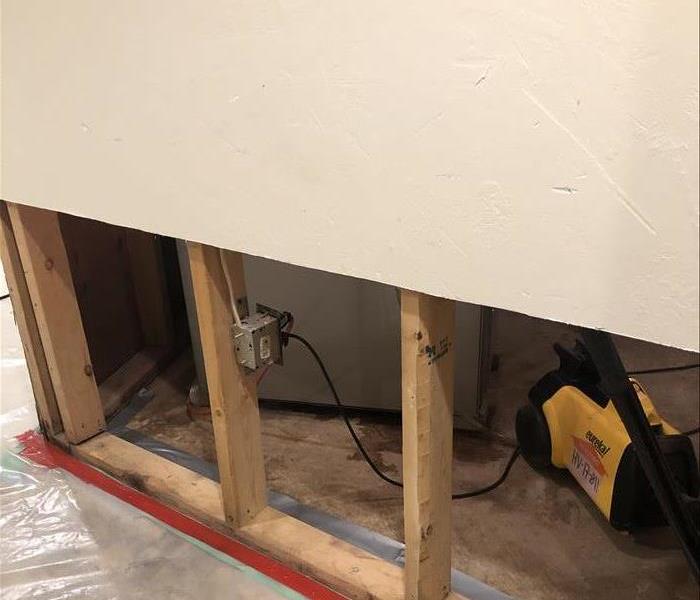 Pictured is an example of a drywall flood cut in a flooded basement
Pictured is an example of a drywall flood cut in a flooded basement
Did you know that making your water damage disaster “Like it never even happened,” is a two-step process? And that each process is billed separately? The first step is what we call “mitigation”. The second step is what we call “rebuild”.
MITIGATION
The first and most important step is mitigation. The definition of mitigation is: “the action of reducing the severity, seriousness, or painfulness of something”. In the water restoration industry mitigation is the actual drying of your structure in a timely manner, with timely being the key word.
Drying your structure in a timely manner after a water loss is essential to reducing its severity. Timely drying of your structure prevents something we call “secondary damage” and makes it more likely that we will be able to save versus having to remove parts of your structure. When things like wood, drywall, fabric, carpeting, insulation, and so much more get wet, they need to be dried quickly, to prevent the growth of mold and bacteria, wood rot, leaching, and delamination. (Delamination is a mode of failure where a material fractures into layers.) Once these things happen, very often there is no choice but to remove them.
Our goal in the mitigation process is to dry the structure while saving as much of it as we can with as little disruption as possible. That said, the drying process can require the removal of things like woodwork, cabinets, carpet padding, and more, in-order to get air circulating behind and under them.
Drywall is a perfect example. Our first choice is to completely dry drywall in place. In-order to do this, it is important to get air circulating behind the drywall. Drywall can often feel dry to the touch even though it is not. Things like paint can mask the moisture that is hidden on the back side of the drywall. If that happens, mold and bacteria will start to grow on the backside of the drywall and the building will begin to stink and maybe even become unhealthy. We have special meters that can detect moisture hidden deep within. If we detect moisture on the backside of your drywall our first choice will be to dry it in place. We do this by removing the baseboards, drilling holes in the drywall behind the baseboard and putting special low-profile air movers up to the holes to get air circulating behind the drywall. Once the drywall dries, the baseboard can be put back up. The baseboard will cover the holes and the water damage to the drywall will be "Like it never even happened.”
If, however the drywall is too saturated or has been wet for too long, it may need to be removed. But even then, we do it with as little disruption as possible. We only remove drywall that cannot be saved. When the water has come from the ground up like in a flooded basement situation, this often results in something we call a “flood cut”. This is where we cut and remove only the drywall at the bottom 1/3 of the wall or the drywall that cannot be saved.
The second step after mitigation is to “rebuild”, or put back, everything that has been displaced or completely removed in the mitigation process.
REBUILD
During the rebuild phase, things that were displaced or removed are put back or replaced. In our drywall example above, if we were able to dry the drywall in place, the rebuild phase would involve putting the baseboard back up and thereby covering the holes in the drywall. If any drywall could not be saved and had to be removed like in our flood cut example, new drywall is put up, taped, mudded and the wall painted.
It is important to note that these two steps are truly separate and distinct and are even billed separately. The mitigation process is the part that is most necessary. It prevents further damage and preserves the safety of the structure.
Some water restoration companies do not offer rebuild services. We are a full-service restoration company with in-house carpenters and regular subcontractors for all of our customer’s rebuild needs. Once the mitigation process is complete, we will ask you if you want a bid for the rebuild process. While some property owners choose not rebuild at all, do the work themselves, or have a different contractor they prefer to use for construction jobs, many end up doing the rebuild work with us. But much of it depends upon their level of insurance coverage and their own financial situation.
One of the most common problems we see is an inadequate amount of insurance coverage. Many property owners have adequate coverage to pay for the mitigation process, but they do not have enough to cover the rebuild process. If you want your water damage situation to truly be “Like it never even happened,” talk to your insurance agent today to make sure you have adequate coverage to cover both steps.
IICRC Certification
7/19/2020 (Permalink)
All of our management and crew leads, as well as most of our technicians, are IICRC Certified. What does that mean to our customers?
IICRC stands for “Institute of Inspection, Cleaning and Restoration Certification”. The IICRC is a certification and standard setting non-profit organization for the inspection, cleaning and restoration industries. They develop health and safety related industry standards, as well as common, industry-accepted language and terminology.
It was founded in 1972 by Ed York. Today it is a global organization, headquartered in Las Vegas, Nevada, with more than 53,000 active certified technicians and more than 6,000 Certified Firms.
In order to become certified, candidates must successfully complete a course in one of over 20 qualifications in cleaning, inspection, and restoration, at one of 70 approved schools worldwide. In addition to successfully completing the course, they must also get a passing grade on a standardized exam. In order to remain IICRC Certified, candidates must earn continuing education credits.
Each IICRC Certification costs SERVPRO of Appleton a fair amount of money in course fees, certification fees, travel and lodging expenses, and lost time on the job. But this is a cost we gladly incur in order to have the best trained staff. Our customers can be assured that our staff has received the highest level of training in our industry.
National Pet Fire Safety Day
7/15/2020 (Permalink)
July 15th is National Pet Fire Safety Day. The American Kennel Club in association with ADT Security Services declared National Pet Fire Safety Day in 2009 to educate pet owners on how to take steps to prevent fires and plan for unexpected emergencies. In other words, pet owners need to take steps to ensure their pets don’t accidentally cause a fire, and they need to take steps to ensure their pets safety should the unfortunate happen.
Many home fires are caused by one of four things:
- Electrical Fires
- Cooking or Kitchen Fires
- Candles or Other Open Flames
- Clothes Dryers
With that in mind, here are some Pet Fire Safety Tips:
- Extinguish open flames. Pets are curious and certainly not cautious. Wagging tails haphazardly knock over candles. Curious kitties will paw at sizzling grease, quickly sending a kitchen up in flames.
- Remove knobs from the stove. When not in use, they will not accidentally get turned on.
- Consider flameless candles for ambiance and backup lighting in the event of a power outage.
- Replace glass water bowls with metal or plastic. Outside on wooden decks, they can heat up and actually start a fire.
- Store leashes and collars near the entrance of your home. When away, have your pets in the main living area for easy rescue.
- Secure young pets when away from home. This can help avoid fire hazards. Pet kennels or in a pet-proofed room are options.
- Fire alert window clings help firefighters identifying the room your pets are located and identify the number of pets in the home. Add one to the window of the room you keep your pets when you are away. Keep it updated with the number of pets who reside with you and your current phone number.
- Have a plan when you are home. Know which family members will be responsible for each pet.
National Social Media Day
6/30/2020 (Permalink)
June 30th is National Social Media Day. In a relatively short time, social media has completely transformed our lives. Many people might be surprised to know that it all started with a site called Friendster. According to Wikipedia, “Friendster was a U.S. social networking site based in Mountain View, California, founded in 2002 and launched in March 2003 by Jonathan Abrams. The company was sold in 2015 and became a social gaming site based in Kuala Lumpur, Malaysia.”
A more widely known social networking site called My Space was born from Friendster. According to Wikipedia, “In August 2003, several eUniverse employees with Friendster accounts saw potential in its social networking features. The group decided to mimic the more popular features of the website. Within 10 days, the first version of Myspace was ready for launch… From 2005 to 2008, it was the largest social networking site in the world, reaching more than 100 million users per month.”
Of course, we all know that Myspace was eventually dwarfed by Facebook. Today roughly 68% of U.S. adults say that they use Facebook, and roughly three-quarters of them say they access Facebook on a daily basis. Facebook users span a wide range of ages and demographic groups.
Given those numbers, it’s not surprising that most U.S. companies also have a Facebook page. We here at SERVPRO of Appleton are no exception. We would love to count you among our followers at:
https://www.facebook.com/SERVPROAppleton
Followers of our page can find helpful tips for cleaning their homes, avoiding disasters and so much more
Terminally Cleaning a Healthcare Facility
5/28/2020 (Permalink)
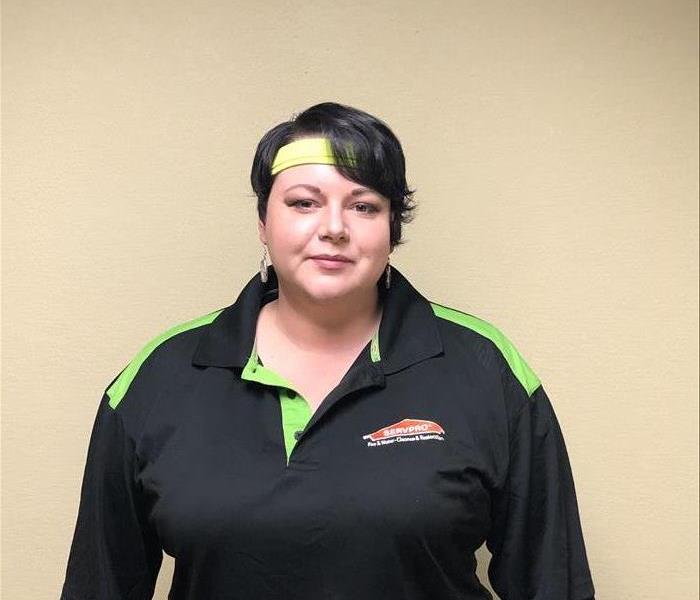 Amanda Baranczyk
Amanda Baranczyk
Healthcare professionals all over the United States are bravely caring for COVID-19 patients. We here at SERVPRO of Appleton are proud to assist them in any way we can. Every night we have a crew, headed up by our very own Amanda Baranczyk, that goes into a local medical facility and terminally cleans the entire floor being used for COVID-19. This includes COVID-19 patient rooms, the nurse’s station, lounges, restrooms and more, the entire floor.
Terminal cleaning is a cleaning method used in healthcare environments to control the spread of infections. It is the thorough cleaning/disinfection of all surfaces including walls, floors, ceilings, and re-usable equipment.
Amanda says that she really enjoys her work at the hospital. She enjoys helping people, and the contribution she can make to her community during this global pandemic. This work is a perfect match for Amanda as she has even joked that she would do this work for free. We here at SERVPRO of Appleton, and the entire Appleton community, are lucky to have her and her crew! Together we will get through these difficult times.
Grocery Store Fire
5/27/2020 (Permalink)
SERVPRO Industries was originally launched in 1967 by Ted and Doris Isaacson as a painting business in Sacramento, California. But with their background in cleaning and restoration, they transformed the company into a franchisor of cleanup and restoration specialists. They sold their first franchise in 1969. By 1988, there were 647 franchises and the corporate headquarters was moved to Gallatin, Tennessee. Today there are over 1,700 franchises in the United States and Canada.
According to Wikipedia, “Despite the franchise structure of numerous relatively small entities, SERVPRO has the capacity and organizational competence to respond to large-scale disasters, including major corporate and government contracts…..” What that means to you is that we are always here to help. Whether you are a single homeowner in an area that has been hit by a large scale storm like a hurricane, or you are a large or small business, we can call upon our national franchise system to work together to address your needs. We are the only restoration company in the industry that has the organizational competence to do this.
Recently we helped the Madison franchise clean up after a fryer caught fire at a Pick ‘n Save in Columbus, Wisconsin. Our two franchises worked together and put in long hours so that the store could reopen in just 3 days. We couldn’t be any prouder of our crews and the effort they put in to get that grocery store reopened, especially during these unprecedented times of a global pandemic. It’s so important that our grocery stores remain open to serve their communities.
National Pack Rat Day
5/13/2020 (Permalink)
May 17th is National Pack Rat Day. Pack Rat is a nickname commonly used for a person who collects or hoards, often unneeded, items. Sometimes a Pack Rat can evolve into a compulsive hoarder.
According to Wikipedia, “Compulsive hoarding, also known as hording disorder, is a behavioral pattern characterized by excessive acquisition of and an inability or unwillingness to discard large quantities of objects that cover the living areas of the home and cause significant distress or impairment. Compulsive hording behavior has been associated with health risks, impaired functioning, workplace impairment, economic burden, and adverse effects on friends and family members. When clinically significant enough to impair functioning, hoarding can prevent typical uses of space enough so that it can limit activities such as cooking, cleaning, moving through the house, and sleeping. It can also put the individual and others at risk of fires, falling, poor sanitation, and other health concerns.
Researchers have recognized compulsive hoarding as a phenomenon since at least the 1980’s, but only recently have begun to study hoarding, and it was first defined as a mental disorder in the 5th edition of the DSM in 2013. It was not clear whether compulsive hoarding is a separate, isolated disorder, or rather a symptom of another condition, such as OCD, but the current DSM lists hoarding disorder as both a mental disability and a possible symptom of OCD. Prevalence rates have been estimated at 2%-5% in adults, though the condition typically manifests in childhood with symptoms worsening in advanced age, at which point collected items have grown excessive and family members who would otherwise help to maintain and control the levels of clutter have either died or moved away. Hoarding appears to be more common in people with psychological disorders such as depression, anxiety, and attention deficit hyperactivity disorder. Other factors associated with hoarding include alcohol dependence and paranoid, schizotypal and avoidance traits.”
If you suspect that a friend or a loved one is a compulsive hoarder, getting them the proper psychological help is essential. But in addition to the psychological help, they will need help cleaning and organizing their home or living space. We here at SERVPRO of Appleton & Winnebago County have extensive experience cleaning severe hoarding situations. We will clean the space with efficiency and compassion.
National Third Shift Workers Day
5/12/2020 (Permalink)
May 13th is National Third Shift Workers Day. The third shift usually runs from midnight until 8:00 am. According to 2004 data from the Bureau of Labor Statistics, almost 15 million Americans work full time on evening shift, night shift, rotating shifts, or other employer arranged irregular schedules.
On this day we would like to acknowledge our hard-working staff at SERVPRO of Appleton & Winnebago County who often work irregular schedules. While they may not work third shift every day, every week or even every month, they sure do when it’s necessary. Emergencies can happen at any time of the day or night, and our heroes at SERVPRO are here to help with your emergency whenever it may occur! We are very proud of their hard work and dedication to serving others in need!
American Red Cross Giving Day
4/21/2020 (Permalink)
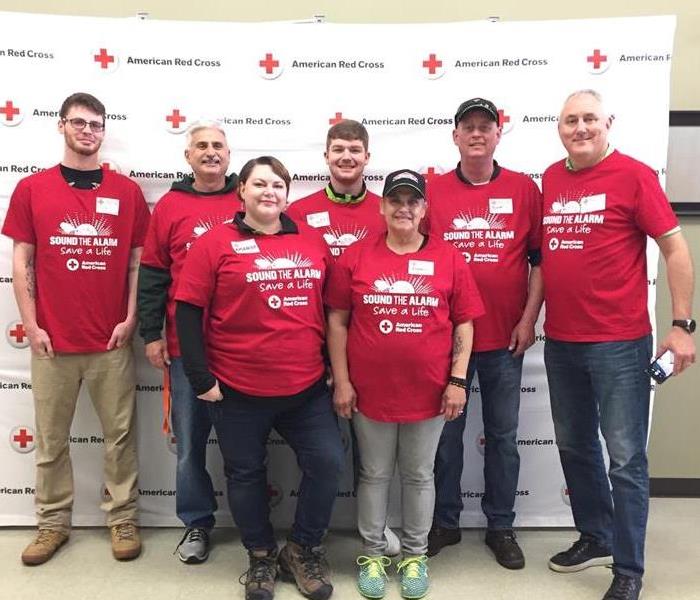 SERVPRO of Appleton & Winnebago County employees volunteering for the American Red Cross' "Sound the Alarm Campaign".
SERVPRO of Appleton & Winnebago County employees volunteering for the American Red Cross' "Sound the Alarm Campaign".
April 21st is “American Red Cross Giving Day”. According to Wikipedia, the American Red Cross is a humanitarian organization that provides emergency assistance, disaster relief, and disaster preparedness education. Each year it responds to more than 60,000 disasters, including house or apartment fires, hurricanes, floods, earthquakes, tornadoes, hazardous materials spills, transportation accidents, explosions and other natural and man-made disasters. They offer assistance that allows people to resume their normal daily activities, by providing shelter, food, health, and mental health services to address basic human needs.
Red Cross Giving Day was established in 2015. It’s a 24 hour rally for public support. If you’d like to support their mission, you can donate money or your time and efforts. To find out more about volunteer opportunities in your area, visit: https://www.redcross.org/local/wisconsin/volunteer.html
Proper Grading Around Your Home or Business
4/21/2020 (Permalink)
In a recent blog post we talked about flood water and the need for flood insurance. If your home falls in a high-risk flood area, you should talk to your lender or insurance agent about flood insurance today.
But sometimes even homes that aren't in a high risk area can experience flood water during particularly heavy rains, or in the spring when the ground is still frozen. Remember any water that flows over the ground and enters your home or basement through a window or any other crack or opening can be considered flood water.
Therefore it's essential that the ground around your foundation is properly pitched or slopped so that rain water flows away from your home and foundation.
Following is a great video from YouTube to show how the ground should be pitched around your home. Take some time this spring to check the grading around your home to prevent problems down the road.
https://www.youtube.com/watch?v=5hYIda7tWqA&fbclid=IwAR2kGCJfBaieaNHKx4o
National Kickball Day
4/17/2020 (Permalink)
April 17th is “Kickball Day”. According to Wikipedia, Kickball was invented in 1917 by Nicholas C Seuss, who was the Supervisor of Cincinnati Park Playgrounds in Cincinnati, Ohio. It was originally called “Kick Baseball” or “kick cabbage”. Seuss’ first documented overview of the game included 12 rules and a field diagram.
In the early 1920’s physical education teachers began using Kickball in their curriculum as a way to teach their students the basics of baseball. At that time, they used a soccer ball or a volleyball.
The lack of both specialized equipment and highly skilled base positions make Kickball perfect for not only children on playgrounds, but also adults looking for a little fun and extra exercise. Many communities offer adult Kickball Leagues in the summer.
Every summer our employees form a team in a local league. It’s always a great night out and a good time for all. We love sponsoring such a fun event for our employees and their families. It's another way to promote team bonding and a great working environment for our employees.
Flooding & Flood Insurance
4/15/2020 (Permalink)
The spring rainy season is upon us. We have already begun receiving calls from home and business owners alike with flooded basements. But did you know that where the water comes from is an important factor in determining if your homeowner’s insurance policy will cover losses associated with water in your basement?
Most often, water that flows across the ground and enters your basement through a window, door, or any other crack or opening is considered “flood water”. According to Wikipedia, “Flooding is defined by the National Flood Insurance Program (NFIP) as a general and temporary condition of partial or complete inundation of two or more acres of normally dry land area or two or more properties (at least one of which is your property) from: Overflow of inland waters, unusual and rapid accumulation or runoff of surface water from any source…”
Losses associated with flood water are not generally covered by a standard homeowner’s insurance policy. To be covered for losses associated with flood water, homeowners must have specific flood insurance. Yet it is estimated that nationwide only about 20% of homes at risk for floods are covered by flood insurance. If you live near a body of water and don’t have flood insurance, talk to your lender or insurance agent about this very important coverage today.
Doing Our Part During the COVID-19 Pandemic
3/26/2020 (Permalink)
The COVID-19 Pandemic is spreading across the globe and the United States. People are anxious and healthcare professionals and our politicians are scrambling to prepare and get ahead of the crisis. Tony Evers, the governor of Wisconsin, has issued a “Safer At Home” Order, which closes all nonessential businesses in the state in an attempt to slow the spread of the virus.
As an emergency services company, we here at SERVPRO of Appleton & Winnebago County are not only open for business, but we are doing our part to assist with the COVID-19 Pandemic. Last week we cleaned and disinfected a 60,000 square foot medical facility that has been sitting vacant since a new facility was built next door. Healthcare officials are now setting up the old facility to be used for testing, triage and overflow.
We are also helping some medical facilities with nightly disinfecting. We are honored to be able to assist our hardworking and brave medical professionals in any way we can.
We Are The Cleaning Experts
3/16/2020 (Permalink)
SERVPRO is Here to Help during this time of need
During this unprecedented time caused by the global pandemic of coronavirus, this is a reminder to our customers that we are specialists in cleaning services, and we adhere to the highest cleaning and sanitation standards.
Specialized Training
We are prepared to clean and disinfect your home or business, according to protocols set forth by the Centers for Disease Control and Prevention. We have years of experience in dealing with biological contaminants, and we will go beyond the scope of work that regular janitorial staff perform on a daily basis.
The CDC encourages cleaning of high-touch surfaces such as counters, tabletops, doorknobs, light switches, bathroom fixtures, toilets, phones, keyboards, tablets and tables. Other spaces mentioned in the CDC’s guidance for commercial spaces include:
- Kitchen/Food Areas
- Bathrooms
- Schools/Classrooms
- Offices
- Retail Spaces
- Water Fountains
- Shelving/Racks
- Sales Counters
- Carpets and Rugs
- Stair Handrails
- Elevator Cars
- Playground Equipment
- Fitness Equipment
Specialized Products
The CDC recommends usage of a labeled hospital-grade disinfectant with claims against similar pathogens to the coronavirus. Multiple products in the SERVPRO product line carry the EPA-approved emerging pathogens claims. While there is currently no product tested against this particular strain of the coronavirus, we are following all guidelines as provided by the CDC and local authorities.
Call Today for a Proactive Cleaning
If your home or business needs deep cleaning services, call the experts today – SERVPRO of Appleton & Winnebago County (920) 832-1110
Business Restoration
2/26/2020 (Permalink)
According to FEMA (Federal Emergency Management Agency), 40% of businesses do not reopen following a disaster such as a fire or flood. And of the businesses that do reopen, another 25% fail within a year.
With numbers like that, it’s easy to see the importance of emergency services and mitigating the loss as quickly and efficiently as possible. We here at SERVPRO of Appleton & Winnebago County have experience on both sides of the equation. Not only are we proud to count some of the biggest and best businesses in the Fox Valley among our customers, but we have experienced our own major disaster.
In March 2014 we experienced a fire at our own office/shop, when a truck parked in our shop caught fire overnight due to damaged wiring. While our structure was still standing, we had extensive fire and smoke damage throughout our shop and attached office. Both our shop and our office were unusable and much of the equipment we use to assist our customers was destroyed. We were completely overwhelmed and filled with despair. But we knew better than anyone that a prompt response was essential. Within less than 12 hours we had rented space and were able to set up operations in temporary spaces, while new equipment was purchased, and the cleanup began. Three months later we were moving back in to our clean and rebuilt home. Six years later we are proud to have not only survived our disaster but continued to grow our business.
If your business experiences a major loss, we are uniquely equipped to help you make it “Like it never even happened,” so that you can count yourself among the success stories.
Importance of Clean Carpets
1/29/2020 (Permalink)
Dirt, dust, bacteria and other allergens build up in your carpet over time. This build up causes two issues: 1) it’s unhealthy and 2) it mattes down the carpet fibers, making your carpet look old and worn.
A good professional cleaning will remove the dirt, debris and bacteria that regular vacuuming will not, keeping the environment in your home healthy and your carpet looking it’s best. The Carpet and Rug Institute recommends professionally deep cleaning your carpet every 12-18 months.
Here at SERVPRO of Appleton & Winnebago County we have two of the best carpet cleaners in the business. They both have over 10 years of experience and are dedicated to their craft.
Brent Smeaton came to us in February of 2017 with 9 years of commercial and residential carpet restoration experience. He has a very loyal following of property management companies, churches, insurance offices, assisted living homes, residential customers and more.
Jordan Van Handel came to us in March of 2018. He too came with 9 years of previous carpet restoration experience. Jordan approaches every job as if it’s his own home. His goal is to make the homeowner proud of their clean home.
If the carpet in your home or business needs a good professional cleaning, give our office a call at (920) 832-1110. Brent and Jordan will make you glad you did.
National Have Fun at Work Day
1/28/2020 (Permalink)
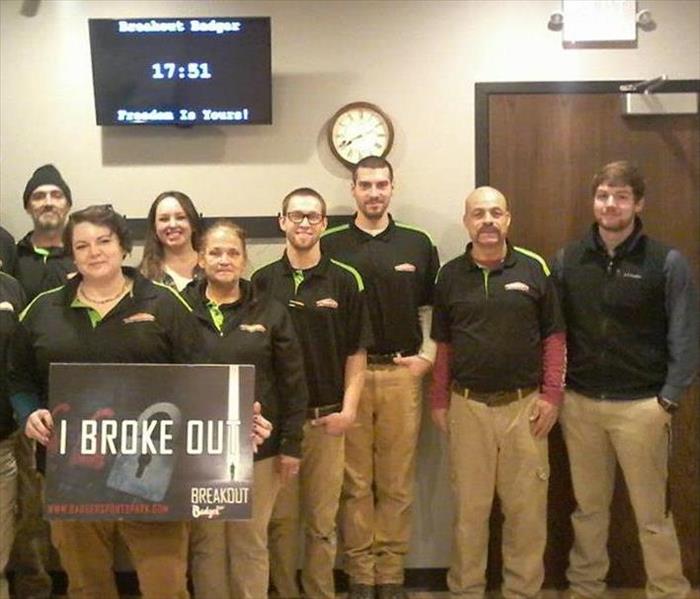 Team Debbie
Team Debbie
January 28th is “National Have Fun at Work Day.” At SERVPRO of Appleton & Winnebago County we believe it’s important for our employees to enjoy what they do. We believe that increased employee satisfaction means a better experience for our customers. To that end, we regularly plan events for our employees to have fun and increase team bonding.
For our most recent outing this past December, we went to Badger Sports Park for an Escape Room Experience. We formed two teams that competed against each other to see which team could escape the fastest. “Team Debbie” took home the prize and lots of fun was had by all.
If you’d like to join our team and make a difference in the lives of people who have just experienced a disaster, stop by our office to fill out an application or send an email to our president at: cjsnyder@SERVPROappleton.com
Winter Storms
1/22/2020 (Permalink)
When we think about storms, often the first thing that comes to mind is tornadoes and severe thunderstorms in the spring and summer. But winter in Wisconsin has its fair share of storms as well, and both can cause a significant amount of damage to your home or business.
According to Wikipedia, “A winter storm warning is a statement made by the National Weather Service of the United States which means a winter storm is occurring or is about to occur in the area, usually within 36 hours. Generally, A Winter Storm Warning is issued if the following criteria, at least, are forecast: usually between 4 inches to 7 inches or more of snow or usually 3 inches or more of snow with a large accumulation of ice.”
A blizzard adds the element of wind. “The National Weather Service defines a blizzard as a severe snowstorm characterized by strong winds causing blowing snow that results in low visibilities. The difference between a blizzard and a snowstorm is the strength of the wind, not the amount of snow. To be a blizzard, a snow storm must have sustained winds, or frequent gusts, that are greater than or equal to 32 mph with blowing or drifting snow which reduces visibility to .25 miles or less and must last for a prolonged period of time – typically three hours or more”
Both winter storms and blizzards can cause a significant amount of damage to your home or business. Most often the culprit is downed power lines from heavy ice or high winds. No power in the spring and summer months can mean no working sump pump and a flooded basement. No power in the winter months can cause a disruption in heat, which can lead to frozen and eventually burst water pipes. And a burst water pipe can cause considerable damage to your property if not addressed quickly. If your home or business experiences a disruption in heat during the winter months, it’s important that you monitor the temperature in your home and take action to prevent a water damage situation if the temperature drops too low.
But a disruption in power or heat is not the only problem a winter storm or blizzard can create. A storm that dumps a large accumulation of ice can also create an ice dam situation on your roof. Typically ice dams develop somewhat slowly over the winter months. But in rarer instances, a winter storm with a significant amount of ice, can create ice dam conditions as well. The Fox Valley and surrounding areas had such a storm last winter. Our phones were ringing off the hook with customers who had water leaking into their home from ice dams on their roof.
If your home or business experiences damage from a winter storm, our experts at SERVPRO of Appleton & Winnebago County are always here to help.
Fire Restoration for Insurance Professionals
1/20/2020 (Permalink)
Are you an insurance professional who would like to learn more about cleaning & restoring smoke damaged contents? If so, we have a great opportunity for you!
On Wednesday, March 11th, 2020, we will be hosting two Continuing Education Courses at the Wisconsin Timber Rattler Stadium in Appleton. There will be a 3 credit morning class on "Ethics" and a 2 credit afternoon class on "Cleaning & Restoring Smoke Damaged Contents".
Coffee & Pastries will be served at the morning registration and lunch will be served at 11:30. You are welcome to join us for lunch regardless of which classes you are attending.
This has become a very popular annual event and space is limited, so register early. To reserve your spot, contact our office at (920) 832-1110 or email: jleadley@SERVPROappleton.com
We look forward to seeing you!
Working at SERVPRO
1/15/2020 (Permalink)
SERVPRO of Appleton & Winnebago County is a family owned and operated business, and every member of our team is truly a part of our big family. Our goal is to provide a work environment that encourages team work, gives a sense of purpose, teaches leadership, and fosters not only professional growth but personal growth as well. We believe that when our employees have a positive experience, our customers will as well.
We asked our employees this past week what their favorite part about working at SERVPRO of Appleton & Winnebago County is and here are some of their responses:
“I like that it is a fun, team-oriented workplace.”
“Horrible things happen to good people. I get to swoop in and turn a devastating and stressful situation into new hope. I get to be a hero!”
“I enjoy the family atmosphere and appreciate the knowledge you retain from being on the crew.”
“My favorite part of working for SERVPRO is the relationships I have with my coworkers and my boss.”
“I get the opportunity to help people in need, there is camaraderie within the team, and I have long-lasting relationships with my fellow coworkers that have become an extended family.”
“When I finish a cleaning assignment, the appreciation and gratitude from the customer is instant satisfaction.”
“This work environment gives me the opportunity to have self-growth”
If you are interested in joining our team please stop by our office at 2235 Northern Rd Appleton, WI 54914, right off of HWY 41 at the Prospect Exit, to fill out an application. You may also send your resume to cjsnyder@SERVPROappleton.com. Questions? Call our office at (920)-832-1110.
Ice Dams
1/14/2020 (Permalink)
Ice dams can be a major problem during the winter season.
An ice dam is a ridge of ice that forms at the edge of a roof and prevents melting snow (water) from draining off the roof. Typically ice dams form slowly. As snow melts from your roof, either by the heat of the sun, or by heat escaping from your home, it tends to refreeze at the edges and other juncture points of your roof. The refreezing of water has a damming effect creating an even bigger ice dam behind it. Continuous feeding of the ice dam by melting and refreezing snow melt can cause significant damage. As the water seeps under shingles it refreezes expanding and creating an even bigger gap for future drainage to fill and further the cycle. Your shingles are being raised and eventually the water that backs up behind the dam, and underneath the shingles, can leak into your home and cause damage to walls, ceilings, insulation, and create a perfect environment for mold growth.
Last winter however an unusual storm dumped a couple of inches of snow/ice on our area. Homes that typically don't have problems with ice damming suddenly had ice dams overnight. As that ice began to melt several days later, these homes had water leaking in to their homes.
If you have water in your home this winter from ice damming, SERVPRO of Appleton & Winnebago County can help.
Candle Safety
1/9/2020 (Permalink)
Valentine’s Day is fast approaching. Many people will burn candles for the holiday. Candles can create a romantic and relaxing atmosphere while producing a pleasing scent. But when used improperly, candles can cause house fires. According to the National Fire Protection Association, approximately 8,200 home fires are started each year by candles.
According to the National Candle Association here are some candle safety basics:
- Before burning, trim the candle wick to ¼ inch in order to prevent a flame from being too large
- Always burn candles in a well-ventilated room and avoid drafts/vents
- Never leave a candle unattended
- Never place a candle near or on anything that can catch fire
- Use a candle snuffer to extinguish the flame (never use water)
- Do not move a candle until it is completely cooled
The best way to prevent house fires caused by candles is to not use candles at all. Here are some alternatives to candles that can help create that desired atmosphere and scent without the danger of a flame:
- Essential Oil Diffuser
- Battery-Powered Candles
- Candle Warmers
But if you do experience smoke or fire damage as the result of a burning candle, our experts at SERVPRO of Appleton & Winnebago County are available 24 hours a day, 7 days a week to help restore your property.
Flu Season Cleaning
1/9/2020 (Permalink)
According to the Centers for Disease Control and Prevention, the number of flu cases have recently spiked across Wisconsin, putting Wisconsin at a high flu activity level.
If you've had a significant outbreak at your school or office, SERVPRO of Appleton & Winnebago County can help you clean and disinfect your property to prevent the further spread of disease.
Homes and businesses can depend on SERVPRO of Appleton & Winnebago County to clean and sanitize building materials, surfaces and contents following restoration industry standards, using professional cleaning products and EPA-registered cleaners and disinfectants. Our professionals are also equipped to clean your HVAC and duct systems to help provide better air quality and help reduce the risk of circulating harmful contaminants.
Call our office today if we can help you! (920) 832-1110
Great American Smokeout
11/21/2019 (Permalink)
November 21st marks the “Great American Smokeout”. The American Cancer Society sponsors the Great American Smokeout every year on the third Thursday in November. This is an annual social engineering event to encourage Americans to quit tobacco smoking. It challenges smokers to quit smoking for 24 hours in the hopes that they will continue beyond 24 hours. While we all know the health benefits of not smoking, we in the restoration business think it’s a good idea to not smoke as well.
According to FEMA, “An estimated 7,600 smoking-related fires in residential buildings occur each year in the United States. While smoking-related fires accounted for only 2 percent of all residential building fires, they were a leading cause of civilian fire deaths, accounting for 14 percent of fire deaths in residential buildings. Nonconfined fires accounted for 93 percent of residential building smoking-related fires. Sixty-seven percent of nonconfined residential building smoking-related fires occurred because of abandoned or discarded smoking materials or products, primarily cigarettes. The bedroom was the leading area of fire origin for nonconfined residential building smoking-related fires at 24 percent. Residential building smoking-related fires occurred most often from noon to 8 p.m., peaking from2 to 3 pm at 6 percent”
Giving up smoking will not only improve your health, but it will also reduce your risk of a home fire. Consider joining the “Great American Smokeout” today.
National Clean Out Your Refrigerator Day
11/15/2019 (Permalink)
November 15th is National Clean Out Your Refrigerator Day. Maintaining your refrigerator will not only keep it looking and smelling good, but it will help keep you healthy as well. Many experts recommend cleaning your refrigerator at least twice a month to keep mold and bacteria at bay.
As we’ve discussed in previous blog posts, mold can spread. Once mold starts to grow on your produce or leftovers, it can spread to other items sitting beside or underneath it, or even surfaces of the refrigerator. It’s important to get rid of moldy items quickly.
It’s also important to watch expiration dates and dispose of any expired items. Pay close attention to whether the dates are “sell by” dates or “use by” dates. For foods without an expiration date, the following website is helpful in determining how long food is good for. http://www.eatbydate.com/
If you have a manual defrost freezer, you should defrost it once a year or when frost build up covers a large area and exceeds ¼ of an inch.
Linda Cobb, author of “Talking Dirty with the Queen of Clean”, has excellent tips for cleaning your refrigerator and freezer.
"When you wipe out the refrigerator, always use a cloth or sponge moistened with white vinegar. It leaves a clean, fresh scent and helps prevent mildew.
A dab of vanilla, lemon or orange extract on a small pad of cotton will keep the refrigerator fresh-smelling without a perfume odor.
Many common refrigerator odors may be removed by placing a small tub filled with charcoal in the middle rack in the refrigerator. I use the charcoal made for fish tanks.
If you are shutting off a refrigerator, be sure to prop the door open a crack for air circulation and put a container of fresh coffee grounds inside to ward off unpleasant odors.. For strong odor removal, a container or nylon stocking with coffee grounds in it works wonders.
For cleaning ease, wipe the inside of the refrigerator, including shelves, with a cloth dipped in glycerin, available in the hand cream section at the drugstore. This light coating will keep spills from sticking. Even milk or sticky substances will wipe right out.
Try using the glycerin in freezers, too. That way spills, even though frozen, wipe right out.
Wash out the freezer with a solution of 1 gallon warm water and 1/4 cup borax to clean and deodorize. Rinse and dry."
What is a Puffback?
11/6/2019 (Permalink)
Cold weather is upon us sooner than expected this year. Sadly it's time to talk about furnaces, preparing our homes for winter and similar matters. We here at SERVPRO have a brochure to discuss winter related topics. Stop by our office or ask your SERVPRO professional visiting your home or office for one of these brochures. Or follow our blog in the coming weeks and we will be sharing information from this brochure.
Today we'll talk about "puffbacks". "A puffback is a messy furnace malfunction that occurs when an oil burner backfires, sending soot throughout your home or business. It can happen all at once, covering an interior in grimy soot, or a puffback can leak soot particles more gradually. Equipped with the training, tools and experience to quickly and efficiently clean and restore your home or business, SERVPRO of Appleton will help make your puffback "Like it never even happened."
Why Emergency Ready Profiles are Helpful
10/11/2019 (Permalink)
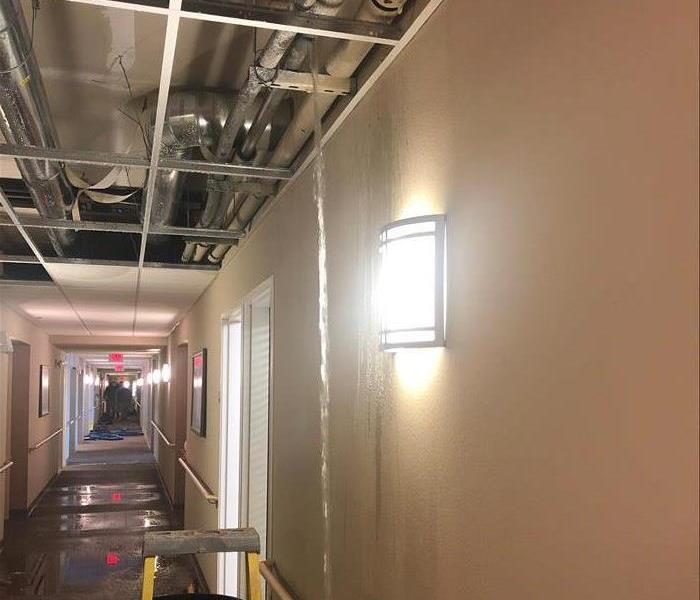 In this photo, the water has been shut off and a garbage can has been placed to collect water that remains in the pipes as it drains out.
In this photo, the water has been shut off and a garbage can has been placed to collect water that remains in the pipes as it drains out.
In our last blog post we talked about Emergency Ready Profiles. The attached photo demonstrates a situation where an Emergency Ready Profile is useful.
Yesterday we were called to a water loss at a Senior Living Community. A water main burst at both ends of a long hallway spraying water all over the place.
In a situation like that, it's important to know exactly where the water shut off valves are and get them shut off as quickly as possible. Once the water is off, the next step is to call the appropriate emergency contacts to get the pipe fixed and dry your structure.
An Emergency Ready Profile gives you all of these things in a convenient app on your phone, so that no matter where you are, or what time of the day it is, you are ready to respond.
In this situation, SERVPRO of Appleton was on the job quickly to begin drying the structure. It was a big task with 55 rooms being effected including tenant units, a community room, offices and more.
National Get Ready Day
9/19/2019 (Permalink)
September 19th is National Get Ready Day. It was established “in 2006 by the American Public Health Association (APHA). The goal of Get Ready Day is to arm individuals, families, and communities with knowledge that will help them cope with crises, such as natural disasters, infectious diseases and pandemic illnesses”. Let SERVPRO of Appleton & Winnebago County help you prepare your business or organization for a disaster.
It is estimated that up to 50% of businesses that close due to a disaster, such as fire and flood never reopen! Of the businesses that survive, the overwhelming majority had a preparedness plan in place. Preparation is a key component for making it through any size disaster, whether it’s a small water leak, a large fire, or an area flood. The best time to plan for such events is not when the event happens but well before it happens.
Our Marketing Professionals can create an Emergency Ready Profile (ERP) for your business or organization. Our ERP serves as a quick reference of important building and contact information. Information like where the water shut off valves are, the name and contact information for the building’s alarm system management company, and so much more. And your ERP can be loaded as an app on a phone for anyone in your organization who might need it, making it conveniently accessible anywhere or anytime, day or night.
By working with SERVPRO of Appleton & Winnebago County to develop your personalized ERP your business will receive the benefits of over 40 years of experience in reducing the impact of any natural or man-made disaster. SERVPRO is a leader in water and fire damage response and can help you quickly get your property back in working order.
Call us today for your no cost ERP.
Mutt's Day
7/31/2019 (Permalink)
 Pictured is our Office "Mutt" Artie. Artie is a Teddy Bear. He's a cross breed between a Shih tzu and a Bichon Frise,
Pictured is our Office "Mutt" Artie. Artie is a Teddy Bear. He's a cross breed between a Shih tzu and a Bichon Frise,
July 31st is Mutt’s Day. The term mutt is often used loosely to mean any dog that is a combination of different breeds, rather than one identifiable breed. Some people note a distinction for dogs who are intentionally bred to combine the characteristics of two or more recognized breeds, calling them crossbreeds, versus a true mutt whose breeding was accidental.
But regardless of whether your dog is a pure breed, a cross breed or a true mutt, he or she is most likely a beloved member of your family. And sometimes these furry members of our families make a mess in our homes. If your dog makes a mess you can’t clean up in your home, SERVPRO is always here to help!
Weekend Storms
7/22/2019 (Permalink)
After severe storms came through the area this past weekend, SERVPRO of Appleton is once again in Storm Mode. The National Weather Service confirmed nine tornadoes touched down in Wisconsin from Friday evening July 19th to Saturday morning, July 20th with several of them being in or near the Fox Valley. Luckily none of the tornadoes were above an EF 1 rating, but the strong winds and rain still inflicted a great deal of damage to many properties. We have received many calls from homeowners and businesses with fallen trees on their roofs and extensive water damage as a result. In addition, many homes and businesses still do not have power this morning. And without a back-up, no power means no working sump pump and many flooded basements as well.
Our crews are out diligently working to restore as many of these water damaged properties as possible. In addition, SERVPRO Corporate has a tree removal vendor from Texas working in the area to help customers remove fallen trees from their structures.
If we can help you restore your home or business give us a call! We are here to help!
Commercial Water Damage
7/9/2019 (Permalink)
Last week was very hot and humid in the valley. Many of us welcomed the heat as it was a far stretch from the long, cold winter we recently experienced. It was a difficult winter and many homes and businesses suffered water losses due to the extreme weather we had.
At the end of January, we were called to a furniture store. They experienced a water loss when a pipe on an outside wall, associated with their sprinkler system, froze and burst. Almost 4,000 square feet of showroom became wet as a result. Floors, furniture, area rugs, some walls, all wet.
Our Project Manager Luke quickly arrived on site to assess the situation. In his preliminary investigation he determined that the pipe was still detached or broken, but the water had been shut off at the source. He also determined that power sources were limited. He arranged for an electrician to come in and set up 3 power panels so that our crews would have enough power to run all the equipment (air movers & dehumidifiers) that were necessary to dry out such a large affected space.
Our crews arrived shortly after Luke. While some team members began extracting water from the floors and furniture, other team members began blocking the furniture. This is where we get furniture up on Styrofoam blocks. This not only protects the furniture from sitting in water, but it also protects the flooring from any dyes that may leach out of the wet furniture.
Some drywall was also wet. To dry the drywall, we removed a couple hundred linear feet of baseboard. Approximately 300 holes were drilled in the wall behind the baseboard. This allowed air from our low-profile air movers to get up behind the drywall and properly dry it in place. This is a big savings for the customer versus removing and replacing the wet drywall. Once the walls are dry, the baseboard is put back up and the holes are covered leaving no evidence of the water damage.
In the end we placed approximately 53 air movers, 7 commercial size dehumidifiers, cleaned and saved approximately 400 pieces of furniture and took 28 area rugs back to our shop to be cleaned, deodorized and dried. We had the affected area mostly dried out and back open to customers in less than 3 days.
Ice Dams & Roof Leaks
7/3/2019 (Permalink)
 Pictured is our very own Luke Snyder talking to the 4th graders about how he calculates area for his job.
Pictured is our very own Luke Snyder talking to the 4th graders about how he calculates area for his job.
This past winter/early spring was very difficult for many Wisconsin property owners. In March we had multiple storms pass through in a short amount of time that dumped a great deal of snow, rain and freezing rain, creating conditions that were perfect for ice damming on roofs. Many homes and businesses that don’t ordinarily have problems with ice damming were seeing it for the first time.
An ice dam is a ridge of ice that forms at the edge of a roof and prevents melting snow (water) from draining off the roof. As snow melts from your roof, either by the heat of the sun, or by heat escaping from your home, it tends to refreeze at the edges and other juncture points of your roof. The refreezing of water has a damming effect creating an even bigger ice dam behind it. Continuous feeding of the ice dam by melting and refreezing snow melt can cause significant damage. As the water seeps under shingles it refreezes expanding and creating an even bigger gap for future drainage to fill and further the cycle. Your shingles are being raised and eventually the water that backs up behind the dam, and underneath the shingles, can leak into your home and cause damage to walls, ceilings, insulation, and create a perfect environment for mold growth.
We had so many calls from homes and businesses experiencing water damage from ice damming that we had to activate our National Storm Team. We brought crews from other franchises throughout the country to assist as many customers as possible. We are the only restoration company in the business with the ability to do this.
One of our customers during this time was a private school in the Fox Valley area. To properly dry the structure, we had to suck wet insulation out of the ceiling. We then had to calculate how much insulation we needed to replace the wet insulation. As our Project Manager Luke was in a hallway calculating the area with his team, a teacher overheard their conversation and asked Luke if he would be willing to talk to the class about what they were doing as it related to their current lesson. Luke was thrilled to help and the school posted about it on their Facebook Page.
Valley Christian School
March 21 ·
Thankful for teachers who never miss an opportunity turn every experience (good or challenging) into an opportunity to learn. Exhibit 1- Here is Luke from SERVPRO of Appleton & SERVPRO of Winnebago County (in our building for a week taking care of water damage) giving 4th graders a lesson on AREA, and how he calculates and uses it in his job every day. Thank you Luke for going above and beyond and thank you Mrs. Wiedenhaupt and Mr. Gross for seizing the opportunity!
Kitchen Fires
7/1/2019 (Permalink)
Kitchen fires are the number one cause of home fires, and a grease fire is the most common type of kitchen fire. Your home’s kitchen is where heat, electricity, water and grease all come together. A grease fire is extremely dangerous as it can get out of control quickly and spread from the stove throughout the kitchen and other rooms of the house.
There are two common types of grease fires in the kitchen. One is in the cooking pan itself and the other is under the burner in the drip pan. Often, drip pan fires result from previous cooking sessions. When something is spilled into the drip pan it cannot be cleaned until the burner and the stove has cooled. It’s not uncommon for people to forget to go back and clean the drip pan, setting themselves up for trouble the next time they cook.
Here are some tips for preventing kitchen grease fires:
- Before cooking anything, make sure the burner is cool and wipe up any spills in the drip pan and around the burner before turning on the heat.
- The most common reason for a grease fire is leaving a hot pan unattended. Keep your eye on all pans while cooking.
- Pay attention to heat ratings for cooking oil. Some oils can be heated more than others before catching fire. If you are cooking and the oil starts to smoke, it is too hot. The flash point of a grease fire is 500 degrees Fahrenheit. Grease will smoke furiously before it ignites, so if you notice smoke, turn down the heat immediately.
- Keep cookbooks, towels, paper towels and anything combustible away from the stove. A grease fire can quickly turn into a bigger fire if it catches onto other combustibles.
- Avoid heating grease before putting food into it. Food can fall quickly into the grease and make it splash out, causing grease burns to you or hitting the heat source and catching fire.
- When deep frying, use a pan or cooking container designed for deep frying that will allow equal space of the grease and food contents above what you are frying. For example, if you are cooking chicken and the grease and chicken are three inches deep, the pan sides should be at least six inches deep.
- Have a class ABC fire extinguisher in your kitchen. Experts recommend having at least three fire extinguishers in your home; in the kitchen, garage and main living area.
- If a pan does catch fire, the best thing to do is smoother it, by using an oven mitt and placing a lid on top of the pan or by using a fire extinguisher. NEVER throw water on the fire or try to run it to the sink or outside.
And if a kitchen grease fire does get out of control, resulting in damage or odor to your home, our experts at SERVPRO of Appleton are here to help. We can clean your home "Like it never even happened."
Insurance Awareness Day
6/28/2019 (Permalink)
Friday, June 28th is Insurance Awareness Day. Make an appointment today to sit down with your insurance agent to ensure you have the coverage you need should disaster ever strike your home or business. All too often we deal with customers who are disappointed to find that their Homeowners Insurance Policy does not adequately cover their losses. The two problems we see most often are:
- No Coverage for a Sump Pump Failure. In most cases, a standard homeowner’s insurance policy does not provide coverage for water damage caused by sump pump failure. However, this type of coverage can be very affordable and can easily be added on to your standard homeowner’s insurance policy in the form of what’s called an endorsement. When this type of endorsement is active, it provides for coverage of property damage caused by water that has managed to back up and into your home from pipes, sewer systems, drains, sump pumps, water service, or any additional system that transfers fluids to and from your home.
- A Low Emergency Services Limit. All too often we see homeowners with a $2,500 - $5,000 Emergency Services Limit. And unfortunately, this is not enough to cover the average water loss. It may be enough to dry your basement or home to prevent secondary damage from mold and rot. But it often leaves no money left over for rebuilding your basement or home and restoring it to its original state. In order to restore your home and make the loss "Like it never even happened." we recommend at least $20,000 for Emergency Service Limits.
Make an appointment today to talk to your insurance agent about these 2 important things.
Summer Humidity
6/26/2019 (Permalink)
It’s that time of year when you will hear your local meteorologist talk about dew points and relative humidity. Simply stated humidity is the amount of water vapor (the gaseous state of water) in the air. Relative humidity is the amount of water vapor the air is holding as a percentage of what it could be holding if it were saturated. For example, if the relative humidity is 30%, the air contains 30% of the water vapor it could hold at that temperature. Higher temperatures have the capacity to hold more water vapor than lower temperatures. So as temperatures rise in the summer months, so too does the capacity for water vapor in the air. And too much water vapor in the air makes us feel uncomfortable and can damage our homes.
When our body temperature rises, we begin to sweat. As the water in our sweat evaporates, it cools our skin. When the relative humidity is high, the air around us has less capacity to take in our evaporating sweat, making it more difficult for us to cool off, and making us feel uncomfortable.
In our homes, high humidity can cause condensation on walls and windows and it can cause mold. As discussed in earlier blog posts, mold is bad for our homes because it feeds on and decomposes any organic material. Organic materials are any type of materials that are found in nature or are made from items that are found in nature. Examples of organic materials in our homes and businesses include wood, textiles and paper.
It’s important during these summer months when humidity levels outdoors can spike, to reduce humidity in our homes and businesses to keep us comfortable and prevent damage. In general relative humidity levels below 50 are considered comfortable and will help prevent mold growth. The two easiest ways to do this are to run air conditioning or a dehumidifier.
Tornadoes
6/6/2019 (Permalink)
Did you know that we are currently in the heart of tornado season? Tornadoes can occur anytime of the year but are most common between the months of March and September, peaking in May, June and July. This is because tornadoes form in particularly violent thunderstorms with sufficient instability and wind shear present in the lower atmosphere.
The Fujita Scale is a scale for rating tornado intensity.
Fujita scale
F0
40–72 mph
Light damage
F1
73–112 mph
Moderate damage
F2
113–157 mph
Considerable damage
F3
158–206 mph
Severe damage
F4
207–260 mph
Devastating damage
F5
261–318 mph
Incredible damage
While EF5 tornadoes are somewhat rare in Wisconsin, they have occurred at least 6 times. In recent history there was one in Oakfield in 1996 and Barneveld in 1984. But as you can see, with wind speeds between 72 & 260 miles per hour, even a lesser tornado can do significant damage. Always be aware of changing weather conditions and know the safest place to go should a tornado warning be issued.
And know that storms strong enough to produce tornadoes often knock out power to thousands of homes in an area. For many homeowners, no power means no running sump pump. And no running sump pump can mean a lot of water in your basement. Consider a battery back-up for our sump pump and talk to your insurance agent to make sure you have coverage should your sump pump fail.
Cleaning Mud on Carpets
6/6/2019 (Permalink)
It's been a particularly wet spring. Here's a little trick from Linda Cobb in "Talking Dirty with the Queen of Clean" on how to remove mud from your carpet.
"Cover wet mud with salt or baking soda and let dry thoroughly before touching. Once it is dry, vacuum it using the attachment hose to concentrate the suction on the mud. Use a good carpet spotter, following the directions, to complete the process. For red dirt or mud, use a rust remover such as Whink or Rust Magic to remove any color residue. Make sure you test the rust remover in a small area first."
And of course if this doesn't work, you can always call the professionals at SERVPRO of Appleton. Our carpet cleaning expert, Brent, can tackle some of the toughest stains. He has been cleaning high profile commercial customers as well as residential customers for over 11 years.
Preparing Yourself in Case of Fire Damage
5/30/2019 (Permalink)
Linda Cobb, 15 year owner of a disaster restoration company in Michigan, and author of the book “Talking Dirty with the Queen of Clean” also gives good advice in Chapter 29 “Turning Down the Heat on Fire Damage”.
“….in those first hours after a fire it’s all you can do to remember your name. The fire truck has just left and there you stand amid what once was your home and is now a smelly, wet, black mess that you hardly recognize. You want to sit down and have a good cry, but there isn’t any place clean to sit. What do you do now? Is everything ruined? This chapter will help you deal with the emotional turmoil and give you sound information about what you, as the homeowner, need to do.
Just in Case
First, as soon as you are done reading this, put your homeowner’s policy, along with your agent’s name and phone number in a fireproof box or bank safety deposit box. This enables you to easily find them and protects them from being destroyed in the fire. Make notes from this chapter and put them with your insurance information.
Get on the Phone
After the fire is out, call your insurance agent or the 800 number that is often provided on your policy to report claims.
Call immediately. It may seem like the damage couldn’t be worse, but it could. After a fire there can be ongoing damage from acid soot residue. Fire produces two main pollutants – nitrous oxide (from burning wood, food, etc.) and sulfur dioxide (from burning plastics and petroleum by products, etc.) When these pollutants combine with moisture and humidity, they form acid! Within hours this can cause substantial and continuing damage. Prompt attention from your local disaster restoration firm will eliminate the problem and prevent further damage to valuables.“
Our experts at SERVPRO of Appleton are here for you 24 hours a day, seven days a week. We will preserve, protect and secure your property with our board up service should it be necessary. And we will work with your insurance adjuster to estimate the damage and begin the clean up process.
What to do Should You Experience Water Damage
5/29/2019 (Permalink)
Many years ago Linda Cobb appeared on the Oprah Winfrey Show. She spent 15 years as the owner of a disaster restoration company in Michigan and she is the author of a great book entitled “Talking Dirty with the Queen of Clean”. As the books back cover says it’s “a marvelous collection of miraculous cleaning tips and surprising shortcuts that get the job done quickly and well”. It addresses everything from how to get various types of stains out of laundry to cleaning your outdoor deck and everything in between. It has come in handy many times in our own home. And the advice she gives in Chapter 30 entitled “The Big Drip-Water Damage Restoration” is spot on.
“What a shock! When you left the house everything was fine.
You come home and unlock the door; you walk in and hear the sound of running water. As you step in, water comes up to your ankles. Now you find water running across the carpet and floors and lapping at the legs of furniture as the sofa and chairs try to soak it up. Here’s what you need to do immediately.
Turn It Off
First, know where your water shut-off is and use it. Turn off the water and look for the source of the leak. BE SURE THE ELECTRICAL POWER SOURCE IS OFF BEFORE YOU WALK IN STANDING WATER. The leak could be a toilet, the washing machine hoses, or a broken pipe.
How quickly you react will have impact on what can be saved in your home.
Call the Professionals”
And of course that’s where we come in. Our professionals at SERVPRO of Appleton are just the people to call in such an emergency. We help people in situations like this everyday.
Preventing Mold
5/23/2019 (Permalink)
In our last blog we talked about what mold needs to grow. Knowing what mold needs to grow, we can talk about what to do to prevent it. We can talk about lots of specifics, but the big overlying issue is to cut off mold’s water source.
- Keep humidity levels below 60 percent. This can be accomplished by running air conditioning, running exhaust fans in humid places like bathrooms, and of course running a dehumidifier when necessary. Good air flow is also important to control humidity and possible condensation on places like windows. Be mindful of furniture placement near or over vents and registers, open drapes and blinds to avoid humidity or condensation being trapped behind them and reduce clutter that may hinder air flow.
- Watch for water intruding into places it should not be and address any leaks from plumbing, roofing, appliances, hot water heaters, or even a flooded basement from a failed sump pump immediately. Any time you have water somewhere it should not be, you are inviting mold.
What Mold Needs to Grow
5/16/2019 (Permalink)
In our last blog we talked about the fact that mold can be found almost everywhere and how it spreads. Today we’ll talk about what mold needs to grow. For the most part, mold needs basically the same things that plants need to grow. It needs:
- Water or moisture
- Oxygen
- Food
- Warmth
The specifics of these things vary slightly for mold. For example, mold does not need a certain amount of water or rainfall. Mold does just fine with condensation, a small amount of moisture, or even a high level of humidity (moisture) in the air. In addition, instead of soil, mold feeds on any organic material. Examples of organic materials in our homes and businesses would be wood, textiles, and paper. The mold hyphae produces an enzyme that breaks down the organic material into a digestible food source.
As for warmth, mold doesn’t require much. It thrives anywhere between 32 and 120 degrees Fahrenheit. That said, temperatures below freezing do not kill mold. Instead the mold spores go dormant unless or until the temperature goes above freezing. And while mold can thrive in any temperature above freezing and up to 120 degrees, it does best between 70-90 degrees Fahrenheit. The chances of mold growth are greatly heightened between those temperatures.
Where plants and mold differ is in their need for sunlight. While plants need sunlight, mold can not grow under ultraviolet light.
In our next blog we will talk about things you can do to help prevent mold.
Mold: Where Can You Find It & How Does it Spread
4/24/2019 (Permalink)
Mold can be found almost everywhere. Mold can be found year-round both indoors and outdoors. The key is to prevent it from growing and/or reproducing or spreading.
So how does mold reproduce or spread? Molds reproduce or spread by releasing spores. Mold spores are kind of like a mature dandelion that has gone to seed and gone white. When disturbed, mold spores can travel through the air, in water, or on animals, much like when you blow on a mature dandelion and the seeds go floating through the air to land in a new spot and start to grow there. So, if you discover a mold problem in your home or business, it’s important not to disturb it. Instead, call our professionals for advice and/or assistance in cleaning it up.
We all know what a dandelion seed needs to grow once it is released; soil, sunshine, and water. In our next blog post, we will talk about what mold spores need to grow.
What is Mold & Why is it a Problem
4/23/2019 (Permalink)
What is mold? According to Wikipedia, “a mold is a fungus that grows in the form of multicellular filaments called hyphae. In contrast, fungi that can adopt a single-celled growth habit are called yeasts.” For many of us, that probably still doesn’t mean a whole lot. Most of us probably just want to know why we should care about mold.
Mold is part of the restoration industry because mold plays a major role in the decomposition of organic material, including the organic material our homes or businesses are made of. “Organic materials are any type of materials that are found in nature or are made out of items that are found in nature.” Examples of organic materials in our homes and businesses would be wood, textiles, and paper. The mold hyphae produces an enzyme that breaks down the organic material into a digestible food source. Therefore, if we want to keep our homes and the things in them safe from decomposition and rot, it’s important to keep mold at bay and remove and remediate any mold that does begin to grow. Our experts at SERVPRO of Appleton are just the professionals you can count on to help you with your mold issues.
Winter & Early Spring Storms
4/18/2019 (Permalink)
This past winter was rough here in Wisconsin. We here at SERVPRO got lots of calls for water damage caused by roof ice damming and flooding caused by snow melt and early rains. To put it in perspective, on an average day, our Appleton Franchise gets about 3 or 4 water calls. During the height of the “storm event” we were getting approximately 60 calls a day. There simply aren’t enough restoration businesses in the Fox Valley to service that many customers. As a result, we activated our National Storm Team and brought in crews from other parts of the country to help service as many customers as possible. We had two SERVPRO Crews from Virginia franchises working on our behalf in the Fox Valley. We are proud to be the only restoration company in the industry that has a national network of franchises that they can mobilize and bring in to a certain geographical area for a storm event.
While that storm event is over, and the crews from Virginia have gone back home, we are expecting to receive a lot of mold calls this spring and summer from customers who had smaller amounts of water creep into their homes or businesses during that storm event that was previously undetected. In the coming weeks our blog posts will focus on mold, what it is, how it spreads, when it’s a problem and more.
Ice Dams & Water in Your Attic
3/28/2019 (Permalink)
In our January 23rd blog we talked about the possibility of roof ice dams this winter. In the blog we explained what ice dams are, and some things you can do to avoid them. And sure enough, we received many calls this past month from homeowners that experienced water damage to their home because of ice damming. In all of these cases, water was leaking, and in some cases running, into the living areas of the home.
But what if you had ice, ice dams, or icicles on your roof but didn’t see any water in living areas of your home? Is it safe to assume you didn’t experience any water damage? The answer is no. It is entirely possible that water leaked into your attic space but never made it to your living areas. And if that happened, you may have mold and eventually wood rot in your attic.
If you had ice damming on your roof this past winter, a thorough inspection of your roof to check for shingle damage, and a thorough inspection of your attic to check for water intrusion, is a good idea.
Ice Damming
1/23/2019 (Permalink)
The first major snow of the season has fallen. Soon you may see icicles hanging from the gutters of homes. But did you know that those icicles are most often the result of ice damming and can lead to water damage and eventually mold in your home?!
An ice dam is a ridge of ice that forms at the edge of a roof and prevents melting snow (water) from draining off the roof. As snow melts from your roof, either by the heat of the sun, or by heat escaping from your home, it tends to refreeze at the edges and other juncture points of your roof. The refreezing of water has a damming effect creating an even bigger ice dam behind it. Continuous feeding of the ice dam by melting and refreezing snow melt can cause significant damage. As the water seeps under shingles it refreezes expanding and creating an even bigger gap for future drainage to fill and further the cycle. Your shingles are being raised and eventually the water that backs up behind the dam, and underneath the shingles, can leak into your home and cause damage to walls, ceilings, insulation, and create a perfect environment for mold growth.
To prevent ice dams, it’s important to clean your gutters before winter so that winter’s melting snow and rain can properly drain off your roof.
Additionally, improper insulation and improper attic ventilation can contribute to ice damming by allowing warm air from inside your home to escape into the attic. It seems counter-intuitive, but the basic ventilation principal for your attic is to keep it as cool as possible during the cold season. If you look at your roof several days after a snow and you see an even distribution covering your roof, that’s a good sign that your attic is properly insulated and ventilated. If on the other hand, you see sections where snow has melted, that suggests an area in the attic where warm air is present due to either improper insulation or improper ventilation. These problems should be addressed as soon as the weather allows.
Some homeowners also find it useful to use a roof rake during the winter months. A roof rake is not your average garden rake. It is a specialty item used to remove snow from the 4-6 feet of roof above your gutter, while standing safely on the ground, so that melting snow can properly flow off of your roof versus forming an ice dam. Roof rakes can be found in season at most hardware and home improvement stores. If you choose to use a roof rake, it’s important to follow all suggested safety precautions and suggestions for use. Additionally, it’s important to know the condition of your roof and shingles. Older roofs, or roofs in poor shape, can easily be damaged by roof rakes and may cause more harm than good.
April Showers Bring...Water in Your Basement
4/16/2018 (Permalink)
While the old saying “April showers bring May flowers” may be true; April showers (and even April snow storms!) can also bring water in your basement.
This time of the year water in your basement typically comes from one of the following sources:
- Water leaks in from the outside through a basement window or other opening
- Water overflows from your sump pump crock as the result of failed sump pump
- Water seeps up through cracks in your concrete floor or foundation, again often as the result of a failed sump pump
- Your sewer system backs up into your basement
But did you know that a standard homeowner’s insurance policy will not provide coverage for water damage caused by any of these four sources?! However, coverage for three of the four can be easily and inexpensively added on to a standard homeowner’s policy in the form of what’s called an endorsement. When this type of endorsement is active, it provides coverage of property damage caused by water that has managed to back up into your home from pipes, sewer systems, drains, sump pumps, water-service, or any additional system that transfers fluids to and from your home.
Now is an excellent time to check with your homeowner’s insurance agent to ensure you have this very important coverage! And for more on sump pumps and how they work, see our blog post from February 1, 2018.
Sump Pump Failure & Homeowner's Insurance
2/2/2018 (Permalink)
Yesterday we talked about sump pumps; how they work and why they’re important. Now imagine the potential damage to your home should your sump pump stop working for any reason; whether it be due to a power failure during a spring storm, or the simple mechanical failure of the pump itself. Without a functioning pump to pump the water out of your sump crock, and up out of your home, the crock will overflow into your basement, soaking your carpet and drywall if your basement is finished, and possibly destroying furniture, important documents and anything else you may have stored in your basement. And depending upon things like the water table and soil conditions in your area, the elevation of your home, and the amount of time the pump is out of order, the amount of water can be significant, causing havoc even in an unfinished basement.
Many people may assume that their homeowner’s insurance will cover this type of damage. But did you know that in most cases, a standard homeowner’s insurance policy does not provide coverage for water damage caused by sump pump failure. However, this type of coverage can be very affordable and can easily be added on to your standard homeowner’s policy in the form of what’s called an endorsement. When this type of endorsement is active, it provides for coverage of property damage caused by water that has managed to back up and into your home from pipes, sewer systems, drains, sump pumps, water-service, or any additional system that transfers fluids to and from your home. Now is a perfect time of the year to check with your insurance agent to see if you have this important coverage, and if not, to add it before the heavy spring rains.
Sump Pumps: How They Work & Why They're Important
2/1/2018 (Permalink)
In our January 18th blog post entitled “Landscape Grading & Keeping your Basement Dry”, we talked about surface water runoff and the importance of keeping it flowing away from your home in-order to keep your basement dry. But did you know that water below ground can also be a threat to your foundation? That’s where your sump pump comes in.
In-order to understand how a sump pump works and why it’s important, it’s helpful to first understand the home building process. After a hole is dug by an excavator for a basement, the next step is to put in foundation footings. Foundation footings in Wisconsin are typically a poured cement slab, often reinforced with rebar. The footings are poured into the excavated trench essentially in an outline of the foundation walls. The footings provide a foundation upon which the cement bricks of the foundation will be laid, or upon which the cement walls of the foundation will be poured, depending on the type of basement wall construction used. The soil upon which these footings are poured needs to stay at a consistent moisture level to prevent settlement, heave, or differential movement. That’s where the sump pump and it’s supporting system comes into play.
A drain system is installed around the perimeter of the foundation/footings. This drain system is essentially a system of pipes (surrounded by crushed stone) with holes in the top that collect water that is heading towards the foundation walls. The water that is collected in these pipes is redirected into a sump crock in the basement, where a pump then pumps the water up and out of the basement. Proper installation and maintenance of this entire system is essential to keeping a basement dry and stable.
Deodorizing Your Refrigerator
1/31/2018 (Permalink)
"To deodorize refrigerators, leave a bowl filled with clean clay cat litter or charcoal on the shelf to absorb odors. This is particularly helpful in refrigerators that are going to be shut off or moved. Make sure you leave the door partially open at all times to allow air circulation, and put some litter or charcoal in an old nylon stocking and tie the top shut. Lay this in the refrigerator and it will control odors. For strong odors, nothing works better than dry, fresh coffee grounds. Put them in a bowl and leave in the refrigerator until odor disappears. This can be used in conjunction with the cat litter or charcoal very effectively." Source: Talking Dirty with the Queen of Clean by Linda Cobb
Cleaning After a Trauma or Death
1/31/2018 (Permalink)
Injury, trauma, and even death, are a difficult but inevitable part of life. And, unfortunately sometimes these events take place in the home. Cleaning up can be emotionally challenging, not to mention dangerous if blood and/or other bodily fluids are involved. Did you know that our cleaning experts can handle any of these situations? We will treat your property and the people involved with the greatest empathy and respect in the face of trying circumstances and we will remove the burden of having to clean up. We will remove and dispose of bodily fluids, tissue and other potentially pathogenic substances. Then we will clean, disinfect and deodorize the structure.
And if your home has become the scene of a crime, we can handle that too. Our experts can clean up things like: fingerprint powder, evidence-gathering chemicals, tear gas & pepper spray residues, and fire extinguisher residues.
Flooding & Flood Insurance
1/30/2018 (Permalink)
Soon it will be that time of year when flooding will be all over the news. Did you know that a standard homeowner’s insurance policy does not cover damage from flooding? Water coming into your home or business from the outside, through a basement window or other opening due to excessive rain or rising bodies of lake, rivers, streams, etcetera, typically falls under the category of a flood, and most homeowner’s insurance policies do not cover floods. According to a 2016 poll conducted by the insurance information institute, only 12 percent of homeowner’s have flood insurance.
How can you protect yourself? The first step is to make sure that your yard is properly graded so that excessive rain, and any standing water resulting from excessive rain, flows away from, and not towards your house. For more information on this, see our January 18, 2018 blog posted titled “Landscape Grading & Keeping your Basement Dry”
The second step is to determine if your home is in a flood plain. If it is, you are at risk of flooding from rising bodies of nearby lakes, rivers, streams, etcetera. FEMA (Federal Emergency Management Agency) can provide you with information you need regarding flooding. They provide copies of the latest and most up-to-date flood zone maps for most communities. You can start by going to: https://msc.fema.gov/portal Here you will be able to type in the address of your property, hit “search” and then click on “view web map”. If you have any questions, or suspect that your property may be in a flood plain, talk to your insurance agent. You may be able to buy a separate flood policy through the federal government’s National Flood Insurance Program (NFIP). Talk to your insurance agent about this very important coverage and what your risks are. Not all areas of a flood plain have the same risk.
Having flood insurance, if it makes sense for your property, will allow you to get our experts in quickly to dry out your floors, walls, furniture and other belongings. When it comes to water damage, a fast response is important to keep costs down and prevent the growth of mold or other secondary damage.
Oshkosh Chamber of Commerce Business Expo
1/30/2018 (Permalink)
Our very own Marketing Manager, Joe Leadly had some fun last week at the Oshkosh Chamber of Commerce Business Expo.
Mold Removal & Containment
1/30/2018 (Permalink)
Did you know that mold reproduces by means of tiny, lightweight spores that travel through the air? Mold spores can be compared to a mature dandelion that has gone to seed. All you need to do is gently blow on a dandelion that has gone to seed, and the seeds go floating through the air looking for a new place to land and grow. Mold spores act the same way. That’s why a small mold problem in your home or business can easily turn into a large mold problem if not treated properly. Our experts at SERVPRO of Appleton know how to treat your mold problem to prevent it from spreading.
The first thing we do before any work begins is to build what we call a containment. This containment is a sealed off area around the mold problem built out of plastic. It seals the area around the mold problem so that mold spores that are disturbed during the removal process are contained and do not travel to other areas of your home or business.
Mold spores in the air during the removal process are almost inevitable. This means that we will also run a commercial air scrubber within the containment area during and after the removal process. An air scrubber is a portable filtration system that removes particles, gasses, and/or chemicals (including mold spores) from the air within a given area.
Any building materials such as drywall, wood, or insulation, that has been affected by mold, and needs to be removed, is placed in a bag and sealed while still within the containment area before it is removed. In addition, crew members working in the containment area are vacuumed with a HEPA (High-Efficiency Particulate Air) vacuum before exiting the containment area. HEPA vacuums differ from conventional vacuums in that they contain filters that are capable of trapping extremely small, micron-sized particles.
Keep in mind that many mold issues are uncovered during remodel or construction projects. It’s not uncommon in these situations, for the contractor you’ve hired for the construction project, to attempt to mitigate the mold themselves. This can be dangerous because they often don’t understand mold the way we do and don’t follow the necessary steps to prevent contaminating your whole home or business. If you encounter mold during a construction project, stop work immediately and contact the experts at SERVPRO of Appleton for professional advice or assistance. Our mold removal and mitigation process is so precise, that most of the hospitals and medical facilities in the Fox Valley use us when they have a mold issue. And if they trust us with their mold issues, you can too.
Have Your Carpets Cleaned for Valentine's Day
1/24/2018 (Permalink)
Valentine's Day is fast approaching. The exact origins of Valentine's Day are difficult to determine as there were multiple Saint Valentines, and evolutions of the holiday go all the way back to the Roman Empire. However, many scholars believe that the saint for whom the modern holiday derived, was a bishop who lived around 270 AD in Rome.
At that time, the Roman empire was in crisis under Emperor Claudius II. They were facing internal struggles like increased taxation and declining education, as well as external aggression on all their borders. As a result, more soldiers needed to be recruited to protect the nation from takeover. Claudius believed that married men made weak soldiers because of their emotional attachment to their families. So he issued an edict forbidding soldiers from marrying. It is believed that Bishop Valentine performed secret marriage ceremonies of soldiers in opposition to edict forbidding it. Eventually Bishop Valentine's secret marriage ceremonies were discovered, and Claudius had Bishop Valentine arrested and executed.
If you're planning a romantic evening at home for you and your significant other this Valentine's Day, let SERVPRO of Appleton give your carpet and/or home a deep clean before the big day. Nothing kills a romantic mood like a dirty home and carpets.
Landscape Grading & Water in your Basement
1/18/2018 (Permalink)
It's hard to imagine right now, but spring will be here before you know it. And while spring may be a welcome sight for many of us, it isn't without it's problems. Many of you will find wet foundation walls or even water in your basement during the spring thaw. There are a couple of reasons why this might happen. One of them is something many of us never think about and that's the grading of our yards.
According to Wikipedia, "Grading in civil engineering and landscape architectural construction is the work of ensuring a level base, or one with a specified slope for a construction work such as a foundation, the base course for a road or railway, or landscape and garden improvements, or surface drainage."
It is important that the ground around your home slopes away from your foundation so that water, or surface drainage, from heavy rains or melting snow, runs away from your foundation and your home. Ground that is flat or slopes toward your foundation is a recipe for wet basement walls or water in your basement.
Proper slope and surface drainage is something that should be checked periodically. Ground shifts and settles with freezing and thawing, erosion and other impacts of nature. Settling ground is particularly pronounced in newer homes where the ground has recently been disturbed to build the home. The ground will compress or settle downward. Evidence of this will be more visually apparent in sinking walk ways or patios, but may not be as obvious in the ground around the foundation of the home as it is often hidden by shrubs and plants in landscape beds. It's important to check for proper slope every year or so and fill in with dirt if necessary to help keep your foundation walls and basement dry.
What is the proper slope away from your foundation? The consensus seems to be 6 inches for the first 10 feet extending out from your foundation. This translates to a slope of 5%. According to the Spruce,
"To find the slope away from your foundation, you will need:
- Some string (at least 12 feet long)
- 2 stakes (we will call them "A" and "B"), and something to pound them into the ground
- A string level (that is, a type of level designed to fit on a piece of string)
- A tape measure
Do You Already Have the Correct Slope?
Using the above supplies, take the following steps to determine if sufficient slope currently exists:
- Tie one end of the string loosely around stake A.
- Pound stake A into the ground right near your foundation
- Slide the string down stake A, so that it rests at ground level
- Tie the other end of the string loosely around stake B.
- Now measure out 10 feet down the slope from stake A, and pound stake B into the ground there (if there is excess string, just wrap it around stake B). The string between the stakes should be fairly taut, but still adjustable.
- Slide the string up or down stake B, so as to make it roughly level.
- Put the string level on the string, at about the mid-point between the stakes.
- Now adjust the string up or down on stake B, so as to make it exactly level.
- Measure the distance from the string on stake B to the ground. Is the measurement 6 inches or more?"
And if you do find yourself with wet foundation walls or a wet basement, SERVPRO of Appleton is always here to help.
Electrical Fires & Arc Faults
1/17/2018 (Permalink)
Electrical fires are one of the leading causes of home fires. And while things like faulty wiring, overheating appliances, misuse of extension cords and heating units, and even faulty light fixtures are most often the cause, it's important to note that the underlying cause is most often arc fault conditions. The National Fire Protection Agency and the National Association of State Fire Marshals, estimate that 50 to 75 percent of all electrical home fires in the United States are caused by arc fault conditions. An arc fault is a high power discharge of electricity between two or more conductors. This discharge creates heat, which can break down the insulation covering wires and trigger and electrical fire.
So while it's important to take precautions like not overloading electrical outlets, inspecting appliance cords for damage, keeping combustible materials away from heat sources, and watching for signs of faulty wiring like switches that crackle or lights that dim, it's also a good idea to install arc fault circuit interrupters where appropriate. While conventional circuit breakers respond to short circuits and overloads, arc fault circuit interrupters, detect an electrical arc and break the circuit if one is detected. Arc Fault Circuit Interrupters are selective. Normal arcs do not cue them to trip. Their circuitry continuously monitors the electrical current and discriminates between normal and unwanted arcing conditions.
Hot Water Heater Leaks
1/16/2018 (Permalink)
Most of us rarely think about our hot water heaters until they either fail to give us hot water or they leak all over our basement and cause significant damage. But in fact, due to the nature of what they due, water heaters are prone to leaks and often cause significant damage to your basement, especially if your basement is finished. It's a much harder clean up if you have wet carpeting and drywall versus cement floor and walls.
Hot water heaters operate by bringing cold water into the tank at the bottom. This water is then heated using natural gas, propane, fuel oil or electricity. The hot water then rises to the top where it is released to wherever warm water is needed in your home, while more cold water comes back into the tank to replace it, and the cycle continues. This process results in various spots where water can leak.
- Whenever you have a plumbing connection or plumbing lines, you have the potential for a leak and there are several near your water heater
- Because water is being heated, water heaters have a temperature & pressure relief valve. These valves can be faulty and cause a leak, or they can leak due to excessive pressure, overheating, or becoming stuck
- Your water heater has a drain valve. This drain valve can fail to close completely and can cause leak.
- If you have an electric water heater, leaks can occur due to a loose heating element or a bad gasket
- The tank itself can corrode and water can leak out the bottom
To protect yourself from significant water damage from a leaky hot water heater, you can install an automatic water shut off valve. Moisture sensors are placed on the floor near or under the water heater. If a leak is detected, the sensors send a signal to the control box which in turn closes the valve, shutting off the water supply.
Frozen Water Pipes
1/8/2018 (Permalink)
Much of the country recently experienced a severe cold snap. And as temperatures began to rise this past weekend, we at SERVPRO were inundated with calls to clean up water damage at both commercial and residential properties due to burst water pipes. It may seem counter intuitive. The temperatures are rising, so why are pipes bursting now?
Without getting into the chemistry of water and what causes it, suffice it to say that water expands as it freezes. While this expansion can cause a weak pipe to burst, it's usually not the direct cause of a burst pipe. Pipes usually burst where little or no ice has formed. That's because the break is usually the result of increased pressure in the pipe and not expanding ice. Pipes burst when water thaws and begins to flow, but then runs into other, still-frozen parts of the pipe and builds up pressure.
What can you do to prevent burst pipes? The simple and most direct answer is to keep your water pipes warm and prevent them from freezing. Typically homes in Wisconsin are built with the water pipes located on the inside of the building insulation, which protects the pipes from subfreezing weather. That said, if your homes insulation is inadequate, you may have a problem. Also consider that any hole on an outside wall for things like television or cable wires, phone wires, or even furnace exhaust vents, can let cold air in. These openings need to be properly insulated as well. If you're building a new home, or doing a home remodel project, it's also a good idea to locate your plumbing pipes on inside walls versus outside walls whenever possible.
To further protect your water pipes, it's a good idea to insulate the pipes themselves. Most hardware stores or home improvement stores carry foam rubber or fiberglass sleeves that most homeowners can install themselves. Plumbing supply stores and insulation dealers carry pipe sleeves that feature extra-thick insulation, as much as one or two inches thick. These sleeves will obviously cost a little more but may be worth the extra cost.
One last thing to consider. The best insulation in your home, and on your pipes, may not be enough to protect your pipes from freezing during a particularly cold spell like the one we recently had, if your furnace goes out while you are out of town on vacation. If you plan to be out of town during the winter months, you may want to consider purchasing a remote temperature monitor. A remote temperature monitor is a digital thermometer that tracks ambient changes in temperature. The sensor then streams the temperature data using wireless technology such as Wi-Fi, Bluetooth or GSM to your computer, tablet or cell phone. This way you can be alerted to any problems at home, even when you're away, so that you can send someone to address the problem before it's too late. Remote temperature monitors are not terribly expensive. They can be purchased on-line or at hardware stores and home improvement stores for as little as $50 or less.
And as always, if one of your water pipes bursts and floods your home or business, the experts at SERVPRO of Appleton are here to help.
Preventing Bathroom Mold
1/3/2018 (Permalink)
What does mold need to grow? In order for mold to grow, it needs oxygen, moisture, warmth and food. The ideal spot for mold to grow would be a warm place (somewhere between 77 and 86 degrees), with a high amount of humidity or moisture, and organic matter, like cotton, paper or wood for the mold to feed upon. This makes our bathrooms an ideal spot for mold growth. Our bathrooms tend to be warm, they contain things like towels, toilet paper, and woodwork for the mold to feed upon, and they often have high levels of relative humidity from running water and steam from hot showers. So what can you do to prevent mold from growing in your bathroom?
First make sure that your bathroom is properly ventilated. Poor ventilation is one of the most common causes of bathroom mold. Without proper ventilation, steam/moisture in the air from hot showers and running water, settles on bathroom surfaces and makes a perfect environment for mold growth. Every bathroom should have a clean and properly functioning ventilation fan permanently mounted in the ceiling and it should be turned on every time someone showers. They are inexpensive and can be purchased at most hardware and home improvement stores. A properly installed and functioning, ventilation fan in your bathroom's ceiling will help move the air out of your bathroom and clear the humidity caused by hot showers and other running water. It is important however to ensure that your ventilation fan has been properly installed and is venting the moist bathroom air outside of your home versus into your attic or some other room. If it improperly vents into another area of your home, you are simply transferring your problem from one location to another. If your bathroom does not have a ventilation fan, instead of showering with the bathroom door closed, as most of us do, an alternative until a ventilation fan can be installed, would be to leave the bathroom door open while showering. This will allow the steam/humidity to dissipate over a larger area reducing its impact. Another alternative during warm weather months, or in warm climates, would be to open a bathroom window while showering or even putting a box fan in the window with the air blowing out of the bathroom versus in. And of course, abstaining from very long, hot showers is always recommended when trying to prevent mold.
Regularly cleaning your bathroom by wiping down all surfaces at least once a week will also help keep mold in check. And when it comes to cleaning/preventing mold, wiping is always the best approach. Molds are fungi that reproduce by releasing spores into the air. Spraying bleach on mold may look like an easy fix. When you spray bleach on mold it looks like it almost instantly disappears. Unfortunately, when you spray bleach on mold, you are releasing the mold spores into the air. Think of it like a mature dandelion that you have just gently blown upon and released the seeds floating into the air on their white dried flowers. The mold spores that you have just released by spraying bleach upon them, float through the air and settle onto new surfaces, where they can begin to grow again if the conditions are right. Wiping with soap and water, or another cleaner, and then throwing away any rags that may contain beginning mold spores is your best bet.
Also when it comes to mold in bathrooms, consider that caulk and grout are there to block or keep out water and moisture. If you have missing or broken caulk or grout, water and moisture can get behind the tiles and mold can form behind the tiles where it's impossible for you to see or clean. It's important to regularly replace and/or maintain your bathroom caulk and grout.
Lastly, painting your bathroom with a mold resistant paint and/or primer will help you battle mold in your bathroom. As indicated earlier, mold needs a food source of organic matter. Drywall paper can be a source of food for mold. Using a mold-resistant paint on bathroom walls can help stop mold before it starts by sealing off access to a food source.
And as always, if you do develop a problem with mold, SERVPRO of Appleton is here to help.
Kitchen Grease Fire
7/19/2017 (Permalink)
Your home’s kitchen is where heat, electricity, water, and grease come together. It’s no wonder, kitchen fires are the number one cause of home fires. And the most common type of kitchen fire is a grease fire. A grease fire is extremely dangerous as it can get out of control quickly and spread from the stove throughout the kitchen and other rooms of the house.
There are two common types of grease fires in the kitchen. One is in the cooking pan itself and the other is under the burner in the drip pan. Often, drip pan fires result from previous cooking sessions. When something is spilled into the drip pan it cannot be cleaned until the burner and the stove has cooled. It’s not uncommon for people to forget to go back and clean the drip pan, setting themselves up for trouble the next time they cook.
Here are some tips for preventing kitchen grease fires:
- Before cooking anything, make sure the burner is cool and wipe up any spills in the drip pan and around the burner before turning on the heat.
- The most common reason for a grease fire is leaving a hot pan unattended. Keep your eye on all pans while cooking.
- Pay attention to heat ratings for cooking oil. Some oils can be heated more than others before catching fire. If you are cooking and the oil starts to smoke, it is too hot. The flash point of a grease fire is 500 degrees Fahrenheit. Grease will smoke furiously before it ignites, so if you notice smoke, turn down the heat immediately.
- Keep cookbooks, towels, paper towels and anything combustible away from the stove. A grease fire can quickly turn into a bigger fire if it catches onto other combustibles.
- Avoid heating grease before putting food into it. Food can fall quickly into the grease and make it splash out, causing grease burns to you or hitting the heat source and catching fire.
- When deep frying, use a pan or cooking container designed for deep frying that will allow equal space of the grease and food contents above what you are frying. For example, if you are cooking chicken and the grease and chicken are three inches deep, the pan sides should be at least six inches deep.
- Have a class ABC fire extinguisher in your kitchen. Experts recommend having at least three fire extinguishers in your home; in the kitchen, garage and main living area.
- If a pan does catch fire, the best thing to do is smoother it, by using an oven mitt and placing a lid on top of the pan or by using a fire extinguisher. NEVER throw water on the fire or try to run it to the sink or outside.
And if a kitchen grease fire does get out of control, resulting in damage or odor to your home, our experts at SERVPRO of Appleton are here to help. We can clean your home "Like it never even happened."
Preventing Attic Mold
6/2/2017 (Permalink)
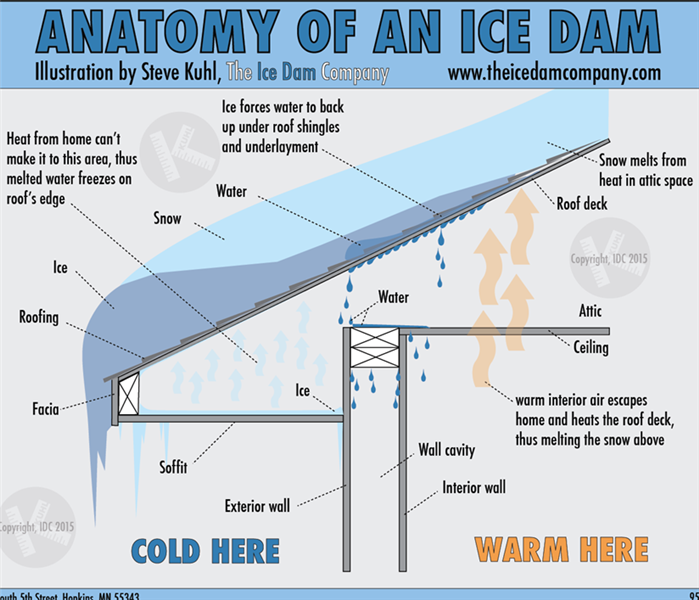 Anatomy of an Ice Dam
Anatomy of an Ice Dam
Anywhere in your home with moist, warm air is an ideal environment for mold to grow. For some of us, moist, warm air can be found in our attics. And unfortunately, many of us rarely, if ever, go up in our attics, so any problems can go unchecked for long periods of time. It’s important to check your attic periodically for common causes of attic mold.
Anything that introduces water or moisture to your attic can be a problem. Things like:
1) Leaking Roof - Sometimes a roof leak is bad enough that water leaks into the floors below and becomes immediately apparent. However often the leak is small enough to cause attic mold, without being apparent in the living spaces of the home.
2) Dryer Vents, Plumbing Vents, and Kitchen or Bathroom Fans vented in to the attic - This practice can pump warm, moist air into the attic where it can be trapped and begin the cycle of mold growth. It is always best to vent these items outside of the home.
3) Missing or Improperly Installed Insulation - Missing or improper installation of the wrong kind of insulation can cause problems in multiple ways. Moisture from the lower levels of the home can rise and get trapped in the attic. Additionally, it can create moisture or condensation in your attic. Think of your attic like a cold glass of ice water outside on a hot summer day. The water is a much lower temperature than the air around it and condensation develops on the glass. If there is missing or improperly installed insulation, this same principle can apply when your home is air conditioned to 70 degrees, but your attic temperature is 99 degrees. Lastly, missing or improperly installed insulation can lead to number four……
4) Ice Damming – An ice dam is a ridge of ice that forms at the edge of a roof and prevents melting snow (water) from draining off the roof. The water that backs up behind the dam can leak into your home and cause damage to walls, ceilings, insulation, and create a perfect environment for mold growth. It’s important before winter to clean your gutters so that winter’s melting snow and rain can properly drain off your roof. Additionally, improper insulation can contribute to ice damming by allowing warm air from inside your home to escape into the attic.
5) Inadequate Ventilation - It seems counter-intuitive, but the basic ventilation principal for your attic is to keep it as cool as possible during the cold season. Pay attention to your roof after snow storms. If you look at your roof several days after a snow and you see an even distribution covering your roof, that’s a good sign that your attic is properly ventilated. If on the other hand, you see sections where snow has melted, that suggests an area in the attic where warm air has been trapped instead of being properly vented to the exterior. Make sure your soffit vents are clear and free of things like debris, bird’s nests and insulation.
6) Water Heaters or Furnaces installed in the attic - While not a common practice in Wisconsin, sometimes homes without a basement will have water heaters or furnaces in the attic. You may also see this practice in larger homes with several heating and cooling zones, as well as spa style bathrooms with a huge soaking tub, where it is common practice to have designated systems to support these luxuries. Unfortunately, this practice can contribute to adding moisture to your attic and contribute to mold growth if there are any leaks from these items.
Cleaning Your Grill
5/11/2017 (Permalink)
Summer grilling season is upon us! Here are some tips for getting your grill ready for the season.
"To clean the grill surface when it is heavily caked with baked-on food, follow this procedure. Simply wrap the rack in a peace of heavy-duty aluminum foil, dull side facing out. Heat the barbecue to high heat and place the rack over the coals or flame for approximately 10 to 12 minutes. When you remove the foil after it has cooled, all the burned-on grease and food drippings will fall off and your rack will be spotless and ready to grill again."
To clean the outside of your grill, try this fast and easy method. "It works well on charcoal and gas grills and will make them look almost like new. Take some Go-Jo Waterless Hand Cleaner (available at grocery stores, hardware stores and home centers) and rub it on the outside of a cool grill with an old rag or paper towel. Work it into the metal well, paying special attention to any grease or barbeque sauce spots. Do not rinse; instead, take paper towels and buff the grill surface and watch as the dirt is replaced by a great shine."
"Talking Dirty with the Queen of Clean" Linda Cobb
Dehumidifier Recalls
5/9/2017 (Permalink)
We all know that spring and summer can bring increased humidity levels in the air. This can present a special problem for areas of our home that are already prone to high humidity levels like basements and laundry rooms. Dehumidifiers reduce indoor humidity which is important because excessive humidity can cause mold, mildew and an increase in other potential allergens. Additionally, humidity can make the indoor temperature feel hotter than it is.
But you should also be aware that as with any other electrical appliance in your home, dehumidifiers bring the risk of fire. They have numerous moving parts that generate significant amounts of heat, including motors, compressors and condensers. Dehumidifiers often run for long periods of time out of view in the basement, which amplifies the risk.
Don’t forget to clean and maintain your dehumidifier regularly according to the manufacturer’s directions and be aware that in recent years, there have been multiple dehumidifier recalls due to fire risk. SERVPRO of Appleton and SERVPRO of Winnebago County has been called in to clean up multiple fires caused by dehumidifiers.
In November of 2016, ABC News reported that a recall of millions of dangerous dehumidifiers that can overheat, smoke and catch fire was reannounced, in an effort to get more consumers to check their units. Gree USA and the U.S. Consumer Product Safety Commission jointly publicized the recall for a second time. The CPSC first announced the recall in September of 2013. The recall affects about 2.5 million dehumidifiers sold in the United States and 55,000 sold in Canada.
According to ABC News, “The appliances were manufactured by Gree Electric Appliances of China and sold under various brand names including Danby, De’Longhi, Fedders, Fellini, Frigidaire, GE, Gree, Kenmore, Norpole, Premiere, Seabreeze, SoleusAir and SuperClima.
Retailers that sold them included AAFES, HH Gregg, Home Depot, Kmart, Lowe’s, Menards, Mills Fleet Farm, Sam’s Club, Sears, Walmart and other stores nationwide and in Canada, and online at Amazon.com and Ebay.com.
The recall involves various models of 20, 25, 30, 40, 45, 50, 65 and 70-pint dehumidifiers.
For a full list of affected model numbers, click here.
The model number and date code are on a sticker on the back, front or side of the dehumidifier.
If you have one of these dehumidifiers, immediately unplug and stop using it and contact Gree for a full refund. You may call toll-free at (866) 853-2802 from 8 a.m. to 6 p.m. Eastern Time Monday through Friday or go to www.greeusa.com and click on “Recall” for more information.”
In November of 2016, ABC News also reported that, “Midea announced a recall of 3.4 million units – for similar reports of smoke and fire -- sold under these brands: Airworks, Alen, Arcticaire, Arctic King, Beaumark, Coolworks, ComfortAire, Comfort Star, Continental Electic, Crosley, Daewoo, Danby, Danby & Designer, Dayton, Degree, Diplomat, Edgestar, Excell, Fellini, Forest Air, Frigidaire, GE, Grunaire, Hanover, Honeywell, Homestyles, Hyundai, Ideal Air, Kenmore (Canada), Keystone, Kul, Midea, Nantucket, Ocean Breeze, Pelonis, Perfect Aire, Perfect Home, Polar Wind, Premiere, Professional Series, Royal Sovereign, Simplicity, Sunbeam, SPT, Sylvania, TGM, Touch Point, Trutemp, Uberhaus, Westpointe, Winix, and Winixl.”
Be sure to check if your dehumidifier is one of the recalled units.
Cleaning your Refrigerator & Preventing Mold
4/27/2017 (Permalink)
Anywhere there is an excessive amount of moisture, mold can begin to grow. This includes your refrigerator/freezer. Keeping your refrigerator clean will keep mold at bay.
"When you wipe out the refrigerator, always use a cloth or sponge moistened with white vinegar. It leaves a clean, fresh scent and helps prevent mildew.
A dab of vanilla, lemon or orange extract on a small pad of cotton will keep the refrigerator fresh-smelling without a perfume odor.
Many common refrigerator odors may be removed by placing a small tub filled with charcoal in the middle rack in the refrigerator. I use the charcoal made for fish tanks.
If you are shutting off a refrigerator, be sure to prop the door open a crack for air circulation and put a container of fresh coffee grounds inside to ward off unpleasant odors.. For strong odor removal, a container or nylon stocking with coffee grounds in it works wonders.
For cleaning ease, wipe the inside of the refrigerator, including shelves, with a cloth dipped in glycerin, available in the hand cream section at the drugstore. This light coating will keep spills from sticking. Even milk or sticky substances will wipe right out.
Try using the glycerin in freezers, too. That way spills, even though frozen, wipe right out.
Wash out the freezer with a solution of 1 gallon warm water and 1/4 cup borax to clean and deodorize. Rinse and dry."
Source: "Talking Dirty with the Queen of Clean" by Linda Cobb
Flooded Basement after Heavy Rain
4/26/2017 (Permalink)
The spring and summer rainy season is upon us and you may find yourself with water in your basement.
The first question many homeowners ask is “Will my homeowner’s insurance cover the cost of this mess being cleaned up and dried out by SERVPRO?” Only your insurance agent and/or adjustor can say for certain whether a claim will be covered. But here are some guidelines to consider in such situations.
The source of the water is a major factor. The most common sources of water in your basement following heavy rains include the following:
- Water leaks in from the outside through a basement window or other opening
- Water overflows from your sump pump crock as the result of a failed sump pump
- Water seeps up from cracks in your concrete floor or foundation as the result of a failed sump pump
- Your sewer system backs up into your basement
Water coming in from the outside through a basement window or other opening due to excessive rain or rising bodies of lakes, rivers, streams, etc, typically falls under the category of a flood, and most homeowner’s insurance policies do not cover floods. According to a 2016 poll conducted by the Insurance Information Institute, only 12 percent of homeowner’s have flood insurance. To get flood coverage, you may be able to buy a separate flood policy through the federal government’s National Flood Insurance Program (NFIP). Your local insurance agent can help you determine if such a policy makes sense for you, and can help you purchase this type of policy.
But what if the water came from your sewer system or a failed sump pump? In most cases, a standard homeowner’s insurance policy does not provide coverage for water damage caused by sump pump failure. However, this type of coverage can be very affordable and can easily be added on to your standard homeowner’s policy in the form of what’s called an endorsement. When this type of endorsement is active, it provides for coverage of property damage caused by water that has managed to back up and into your home from pipes, sewer systems, drains, sump pumps, water-service, or any additional system that transfers fluids to and from your home.
The spring rainy season is a perfect time to check with your insurance agent to ensure that you have this very important coverage. So that if disaster strikes, SERVPRO of Appleton can make it "Like it never even happened."
"Mold Removal" vs Remediation
4/29/2016 (Permalink)
“Mold Removal” vs. Remediation
What’s the Difference?
Since microscopic mold spores exist naturally almost everywhere, indoors and outdoors, removing all mold from a home or business is impossible. Some restoration businesses advertise “mold removal” and even guarantee to remove all mold. This is a fallacy.
A qualified restoration company understands the science behind mold and mold growth. SERVPRO Franchise Professionals have the training and expertise to remediate the mold in your home or business. Mold remediation focuses on getting mold levels back to normal, natural levels.
Every mold damage scenario is different and requires a unique solution, but the general mold remediation process stays the same. To learn more about our mold remediation process.
- Step 1: Emergency Contact (920) 832-1110
- Step 2: Inspection and Mold Damage Assessment
- Step 3: Mold Containment
- Step 4: Air Filtration
- Step 5: Removing Mold and Mold-Infested Materials
- Step 6: Cleaning Contents and Belongings
- Step 7: Restoration
Signs of Mold? Call Today (920) 832-1110
Understanding Mold
When water intrudes into your property, mold growth can start in as little as 48 hours. Consider the following mold facts:
- Mold is present almost everywhere, indoors and outdoors.
- Mold spores are microscopic, float along in the air, and may enter your home through windows, doors, or AC/heating systems or even hitch a ride indoors on your clothing or a pet.
- Mold spores thrive on moisture. Mold spores can quickly grow into colonies when exposed to water. These colonies may produce allergens and irritants and have the potential to cause other health effects.
- Before mold remediation can begin, any sources of water or moisture must be addressed. Otherwise, the mold may return.
- Mold often produces a strong, musty odor, and that odor can lead you to possible mold problem areas.
- Even higher-than-normal indoor humidity can support mold growth. Keep indoor humidity below 45 percent.



 24/7 Emergency Service
24/7 Emergency Service
